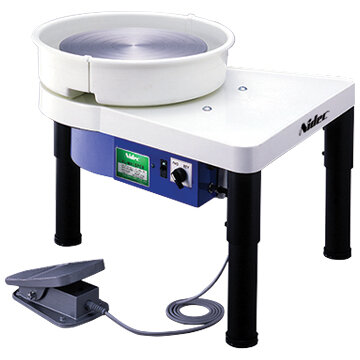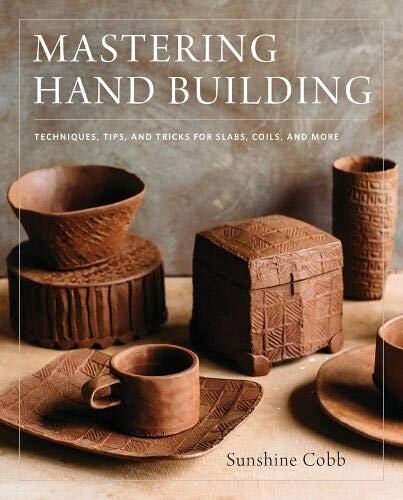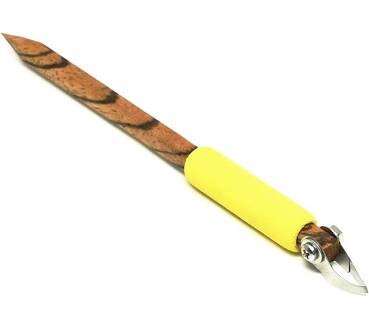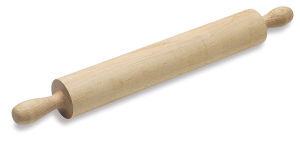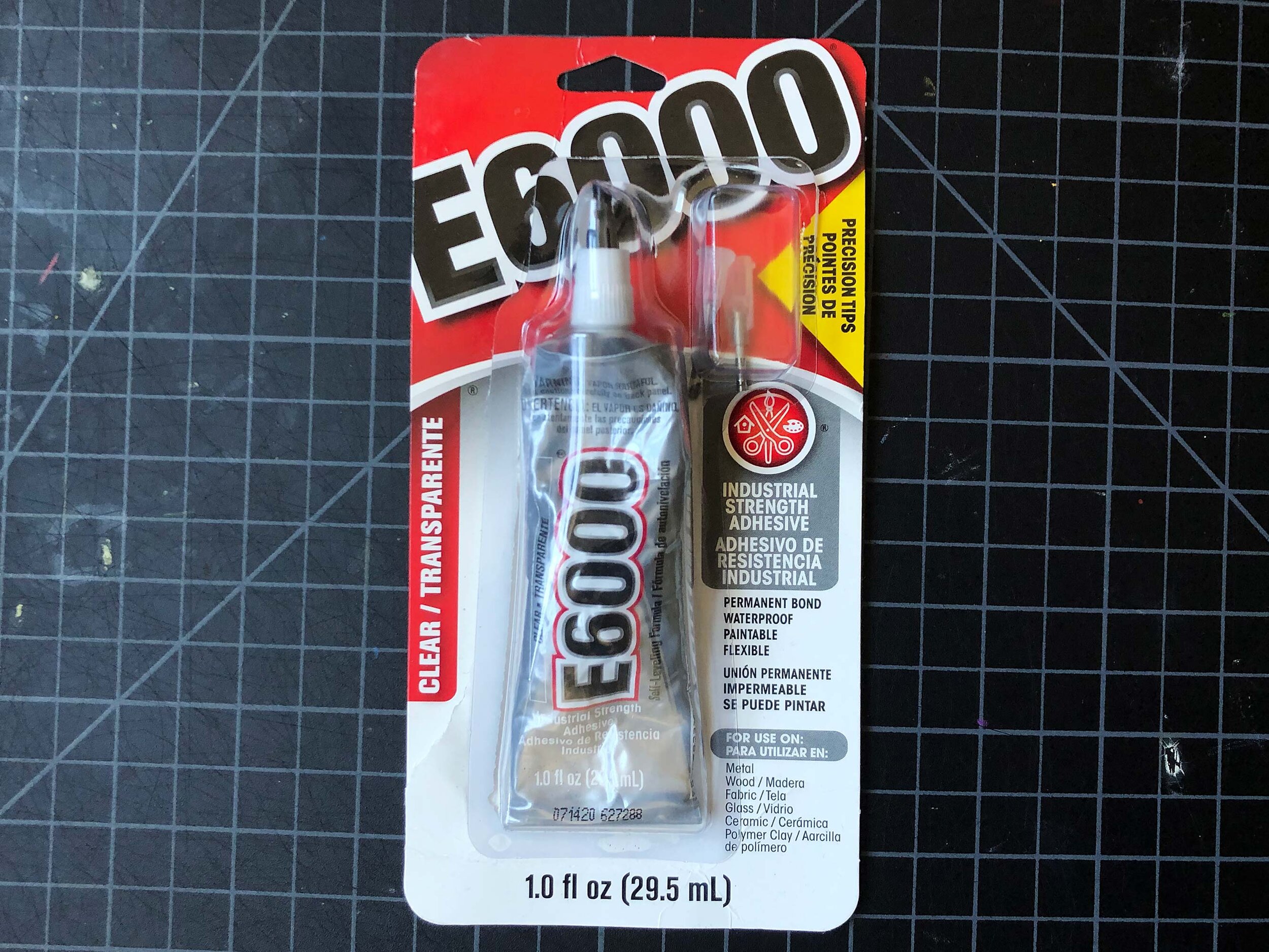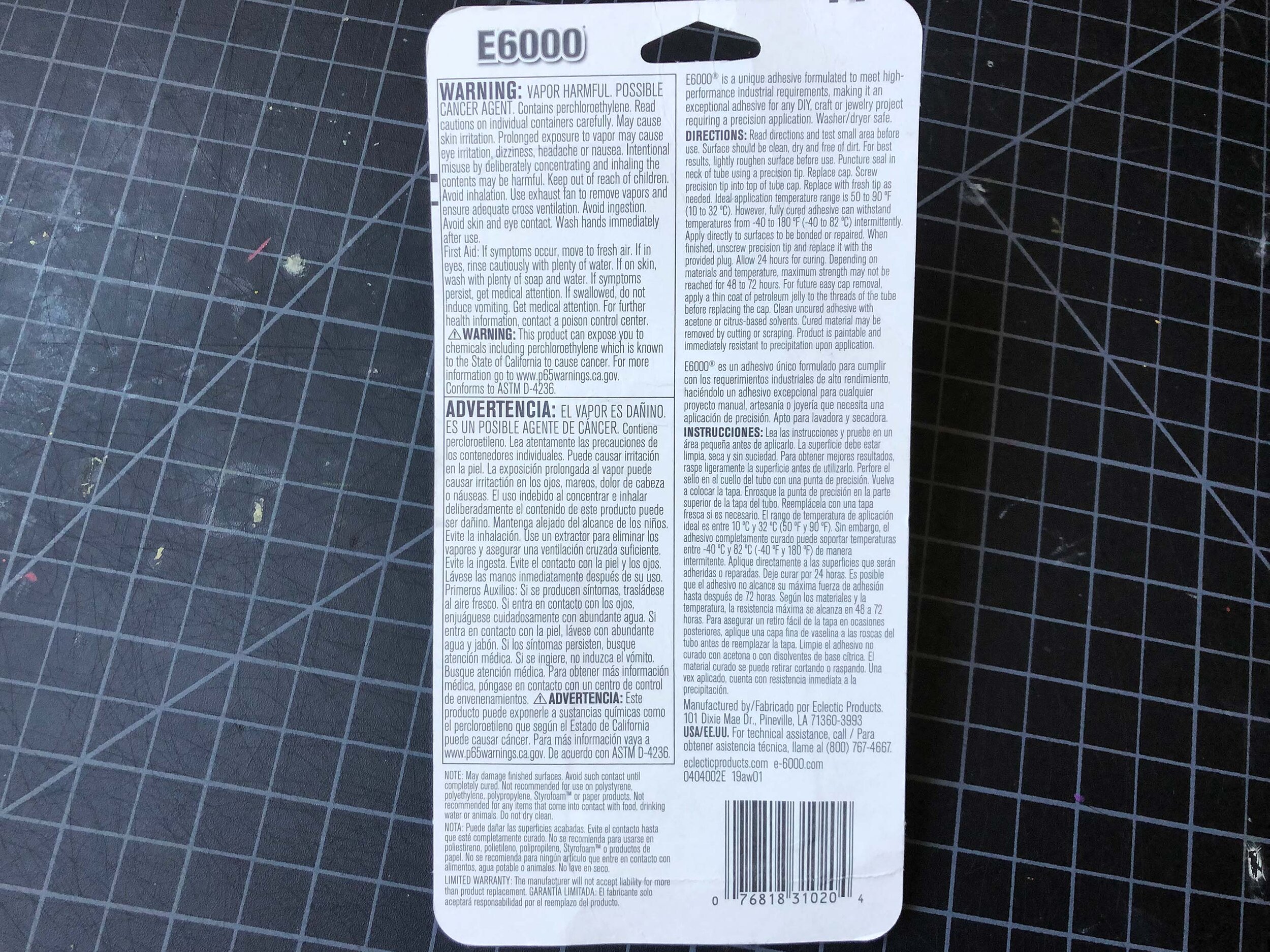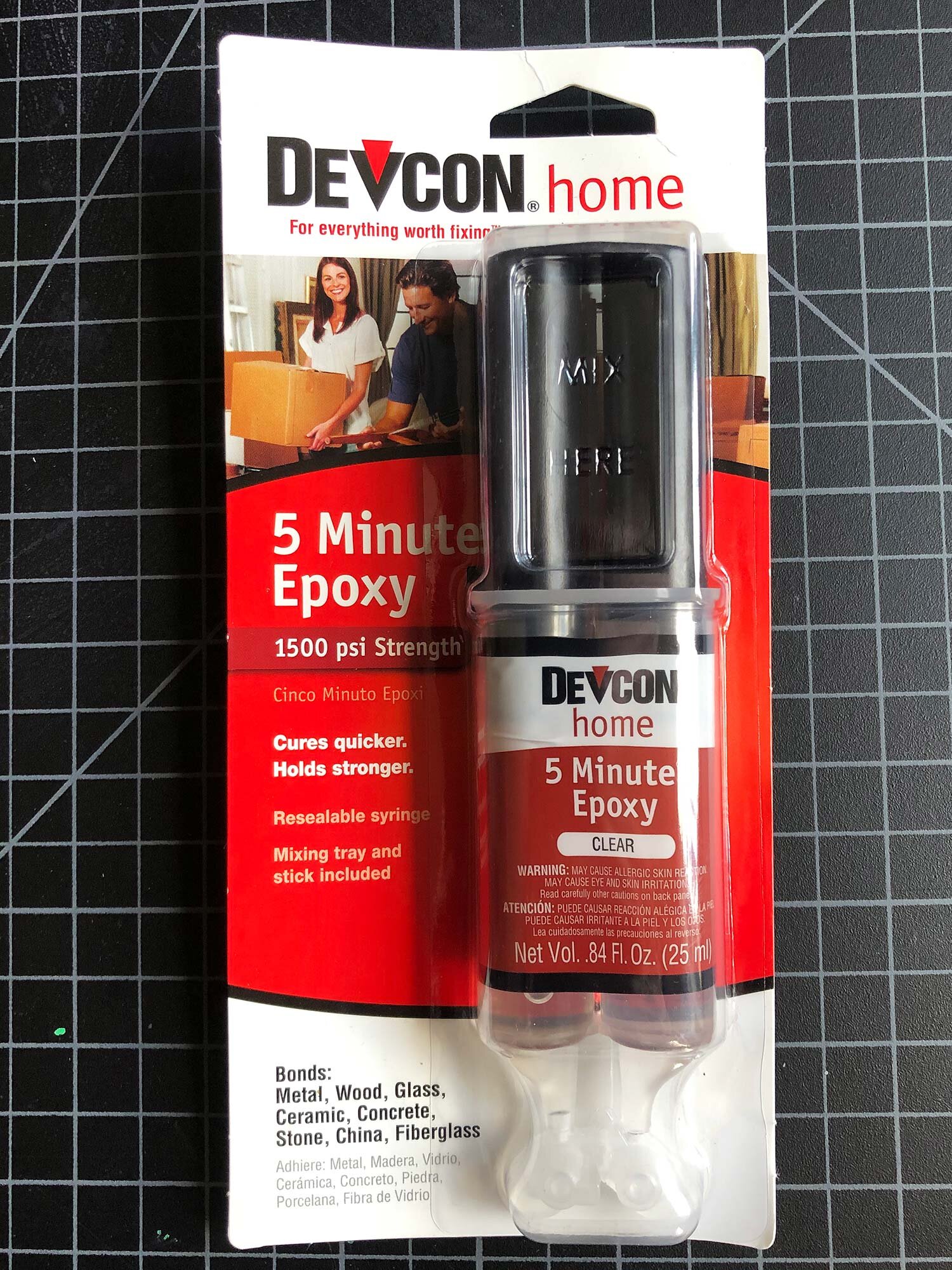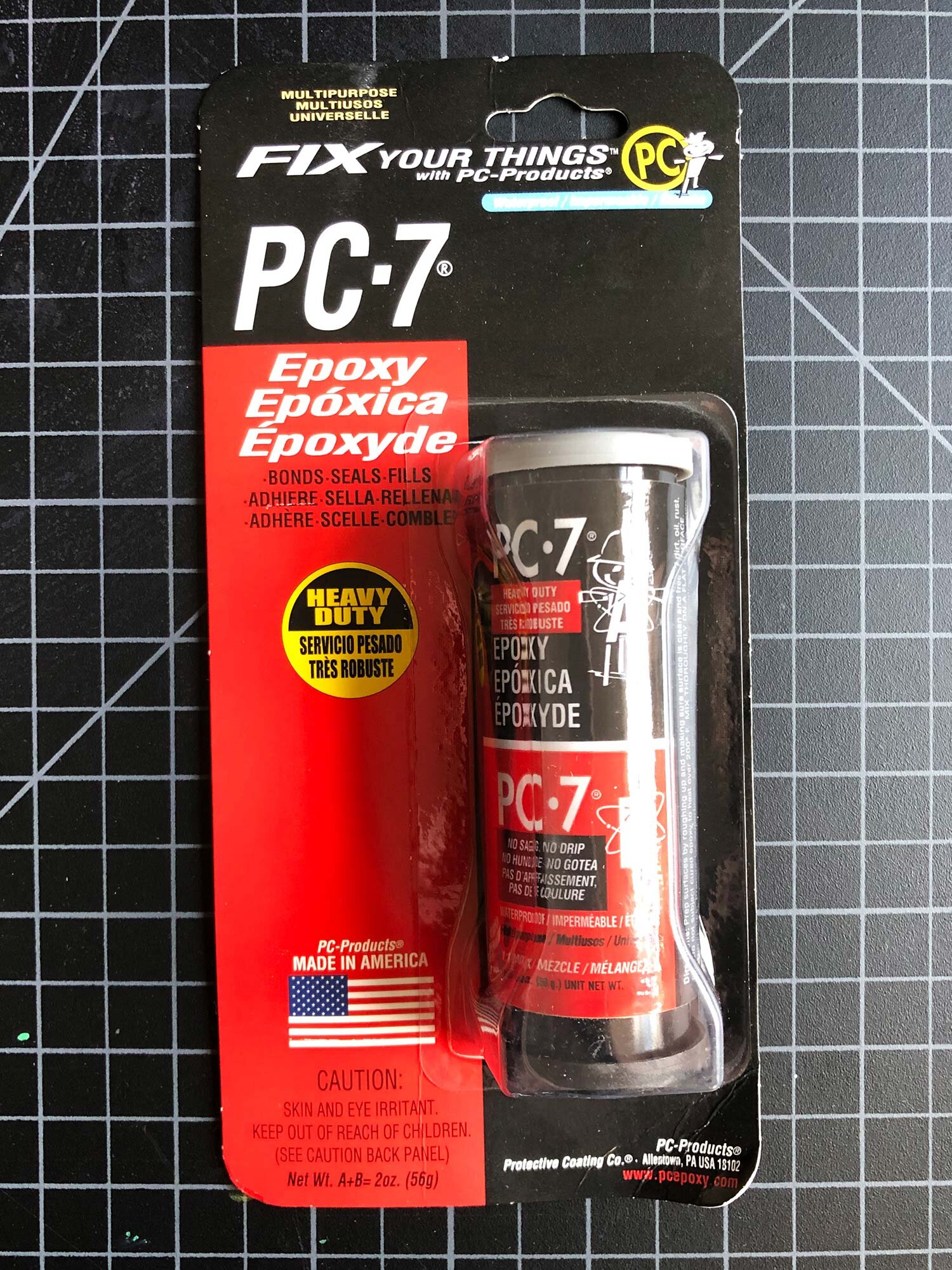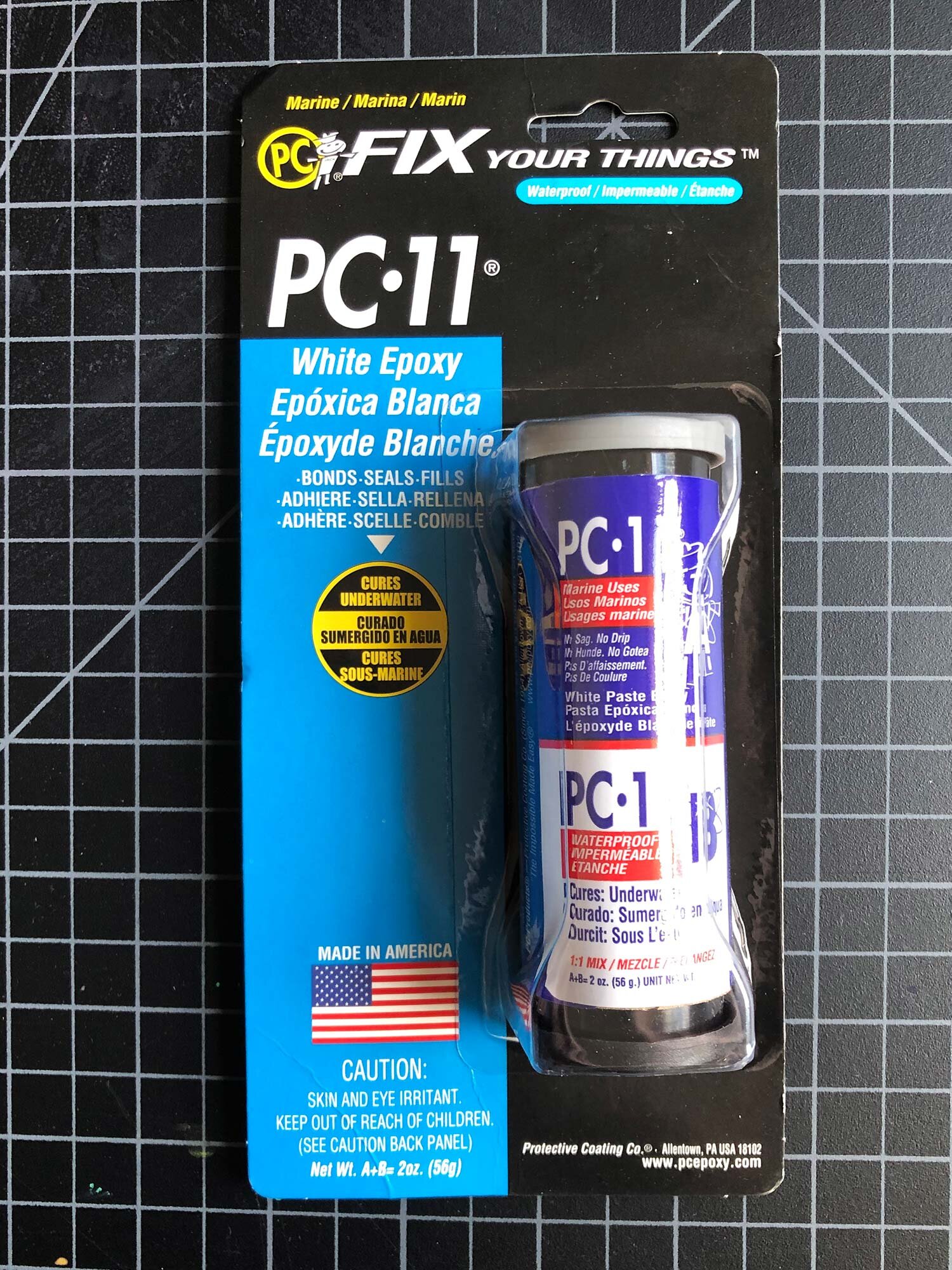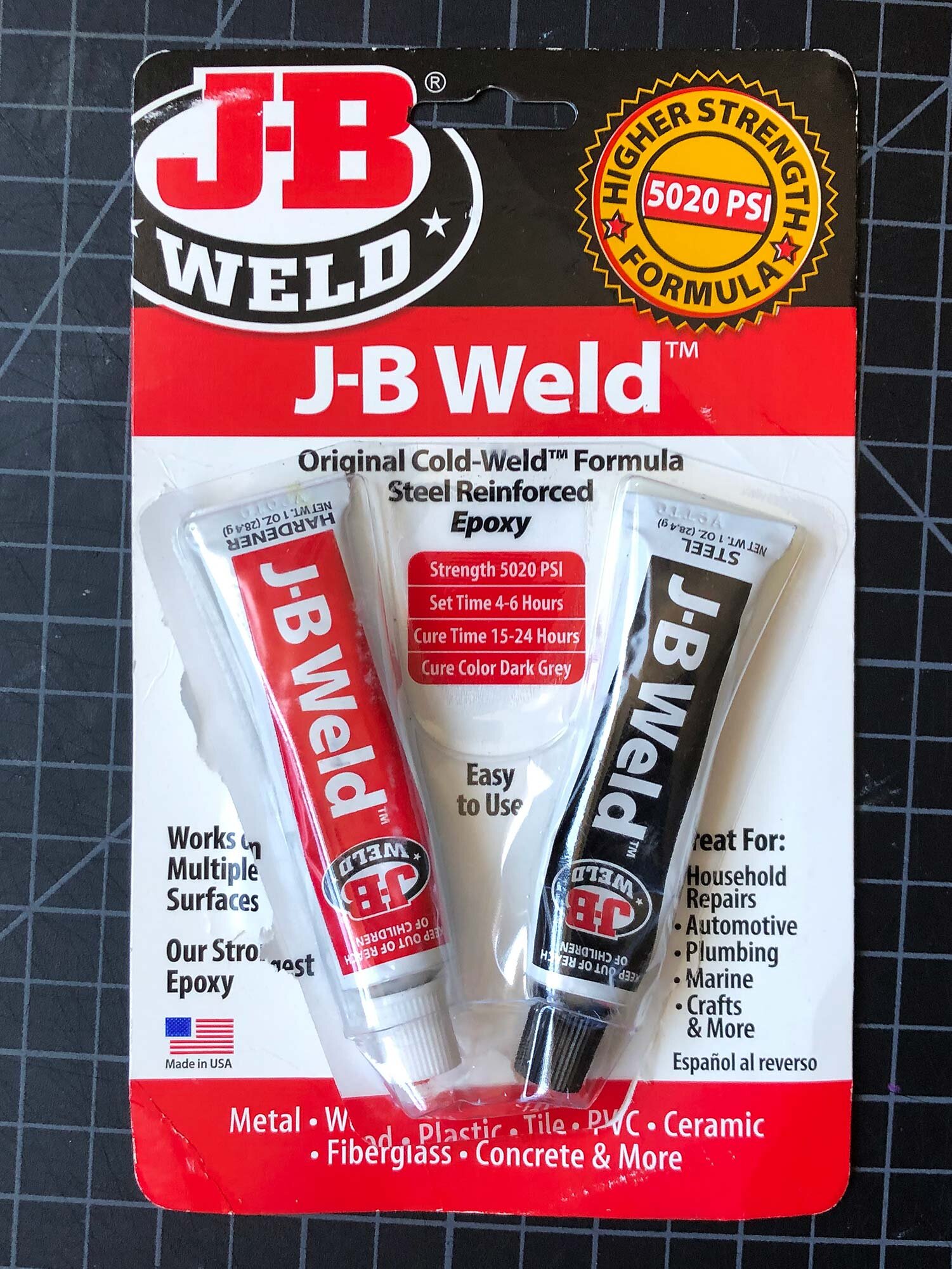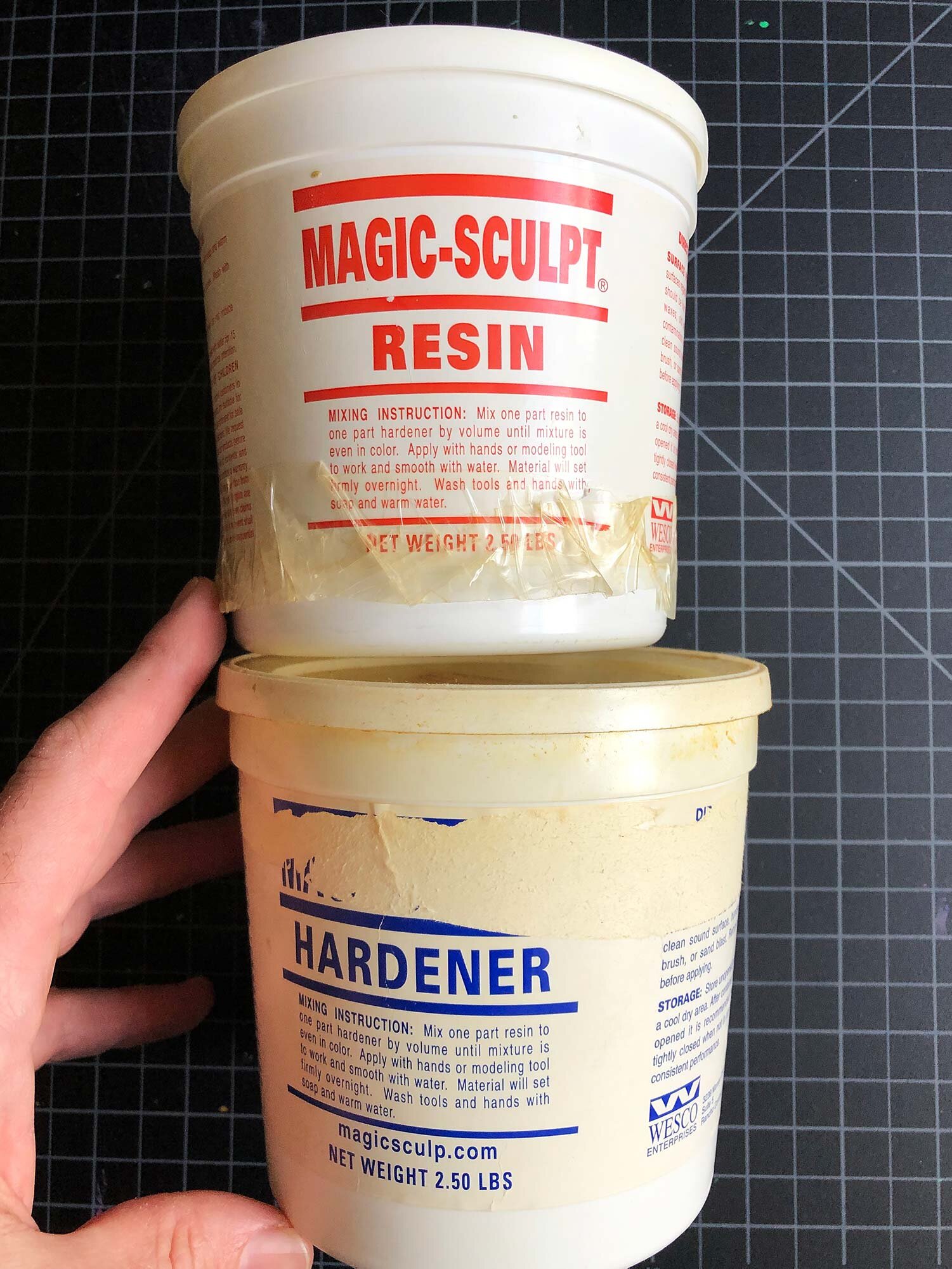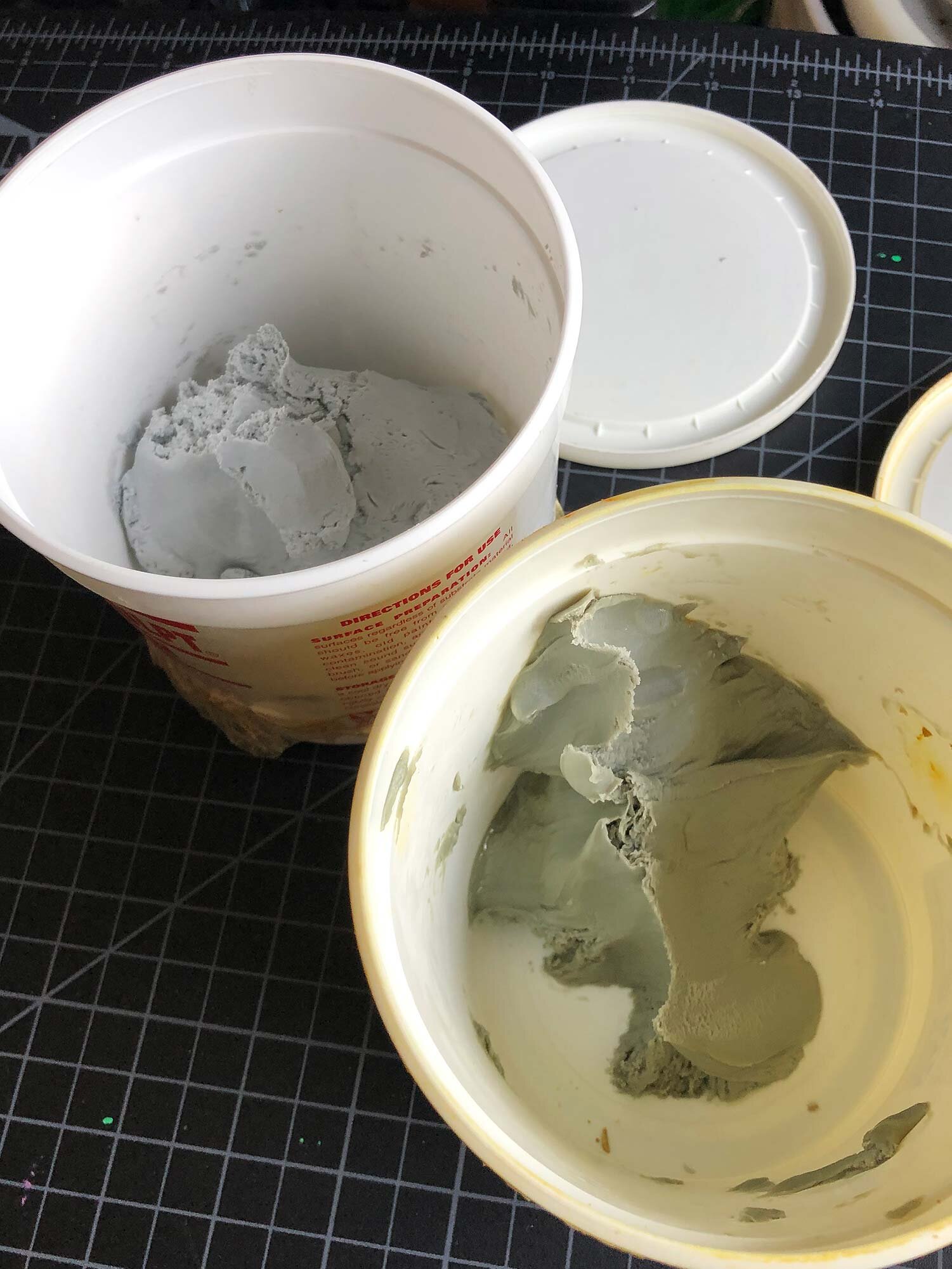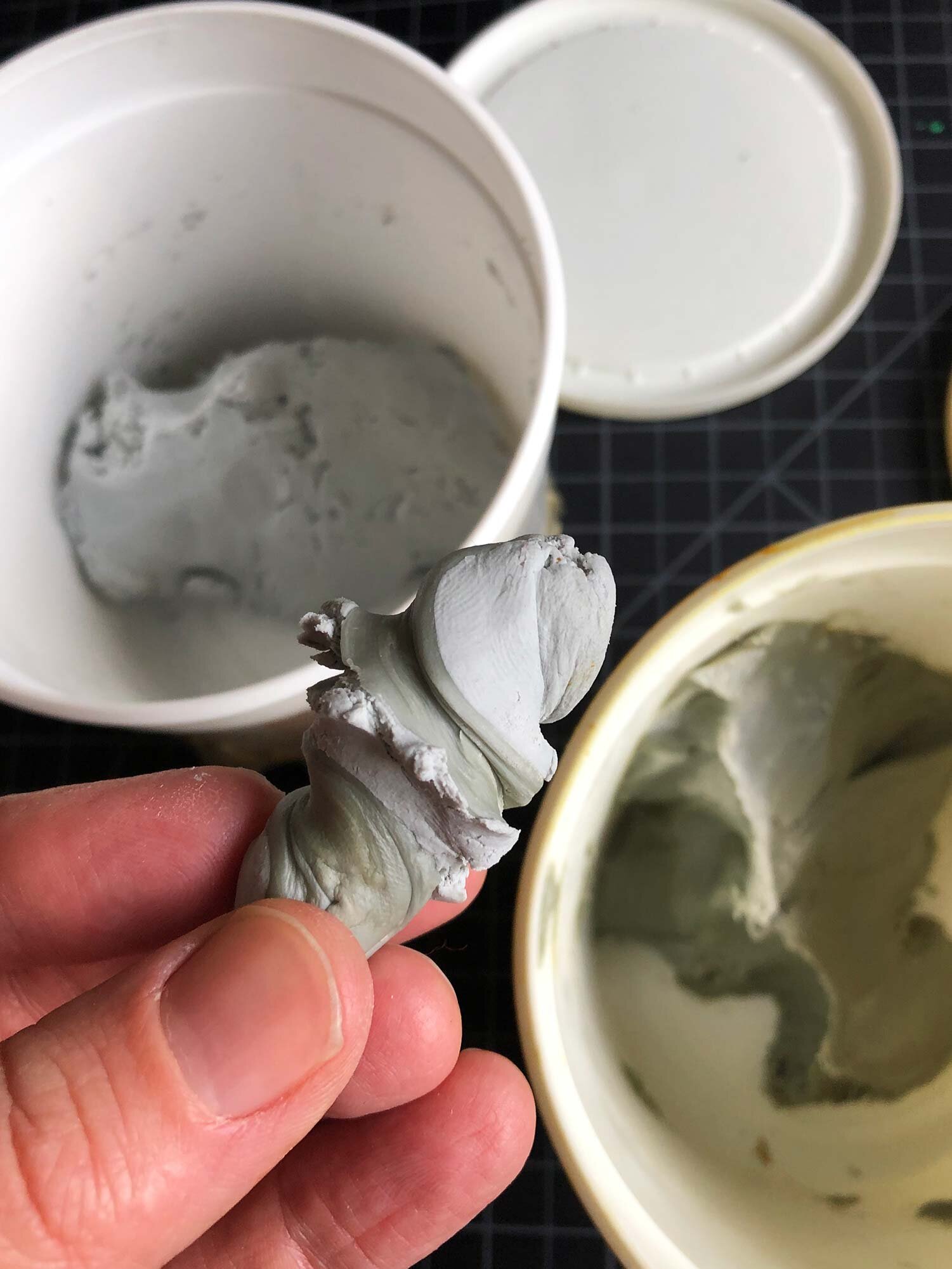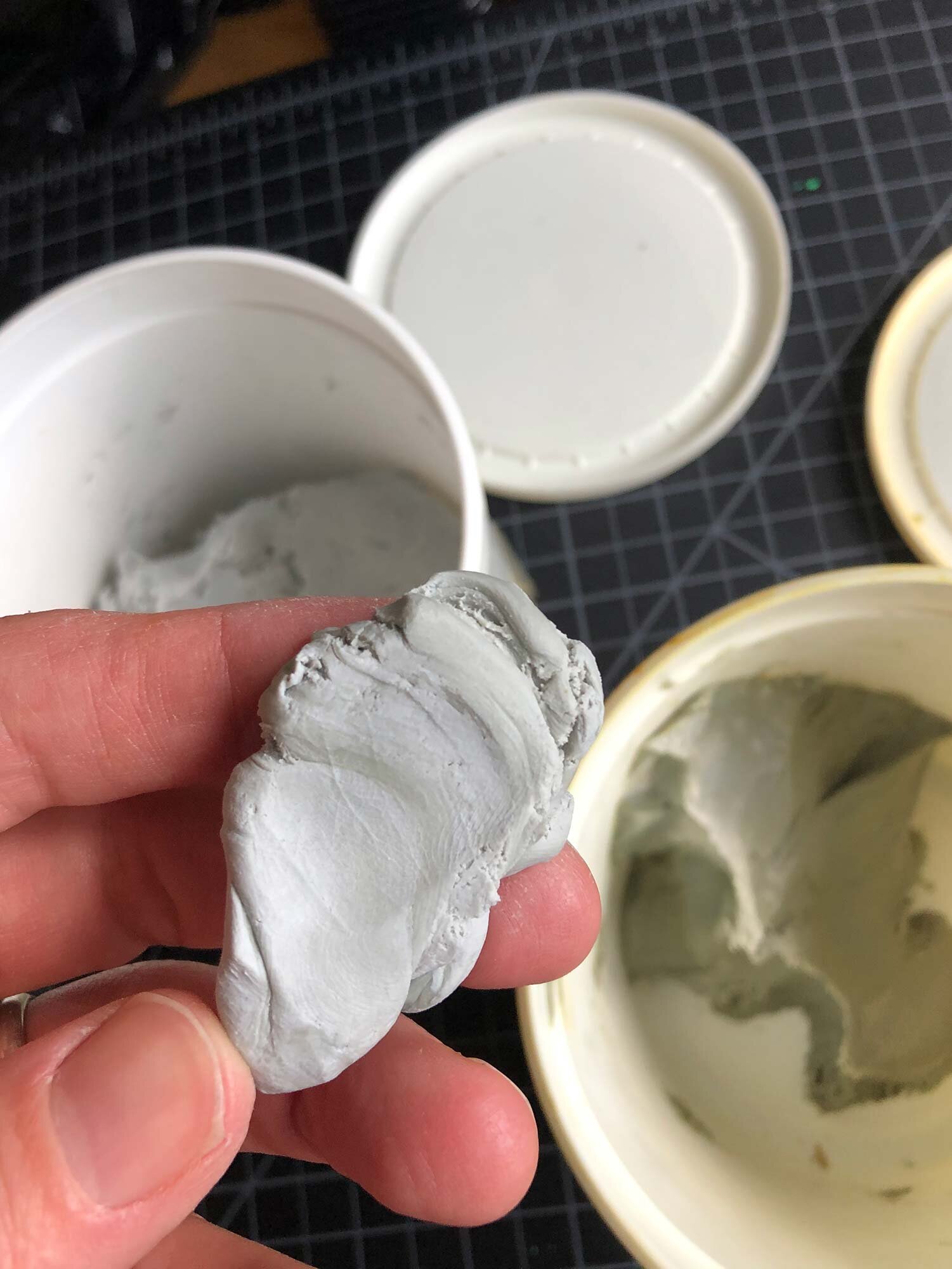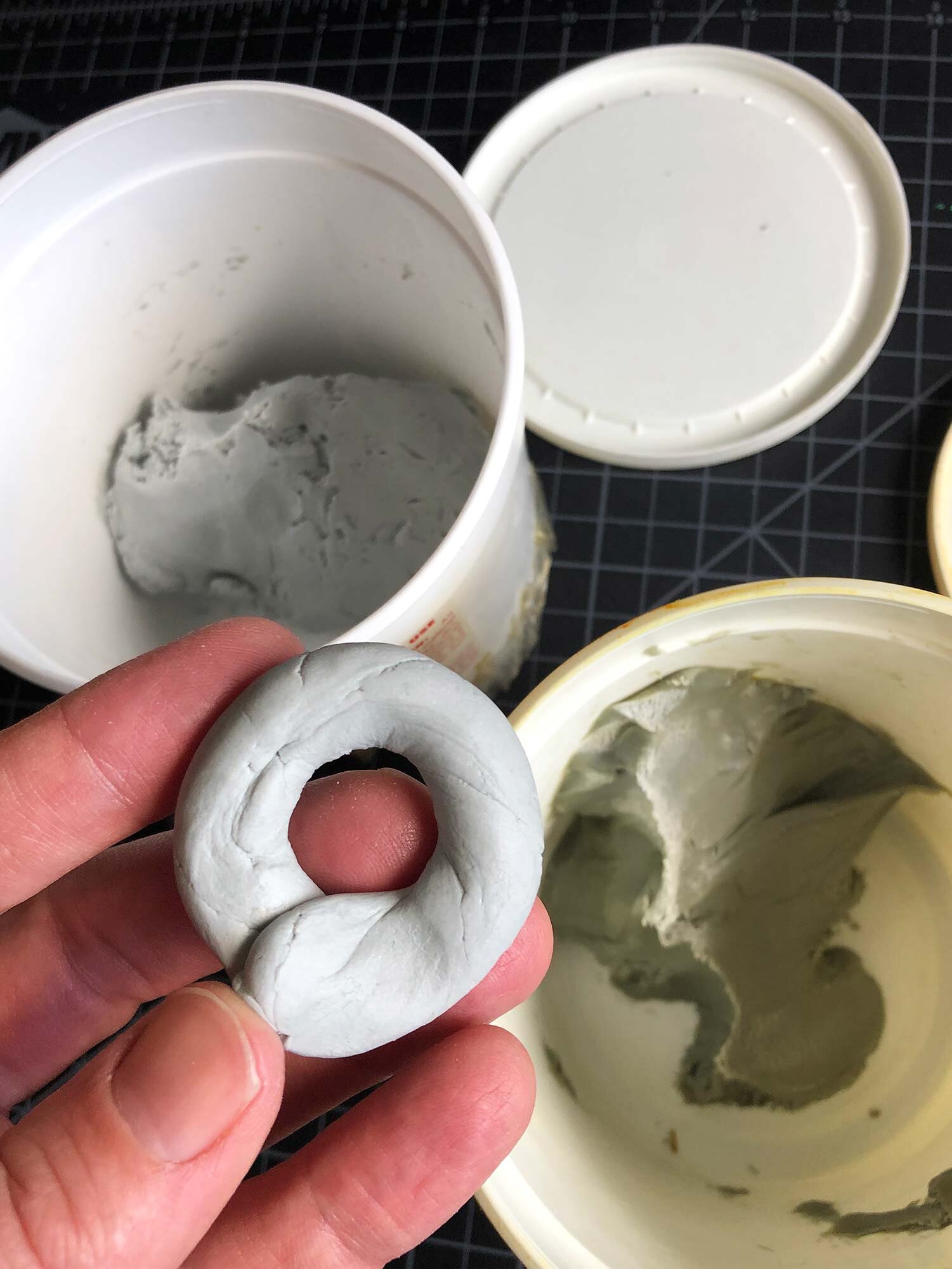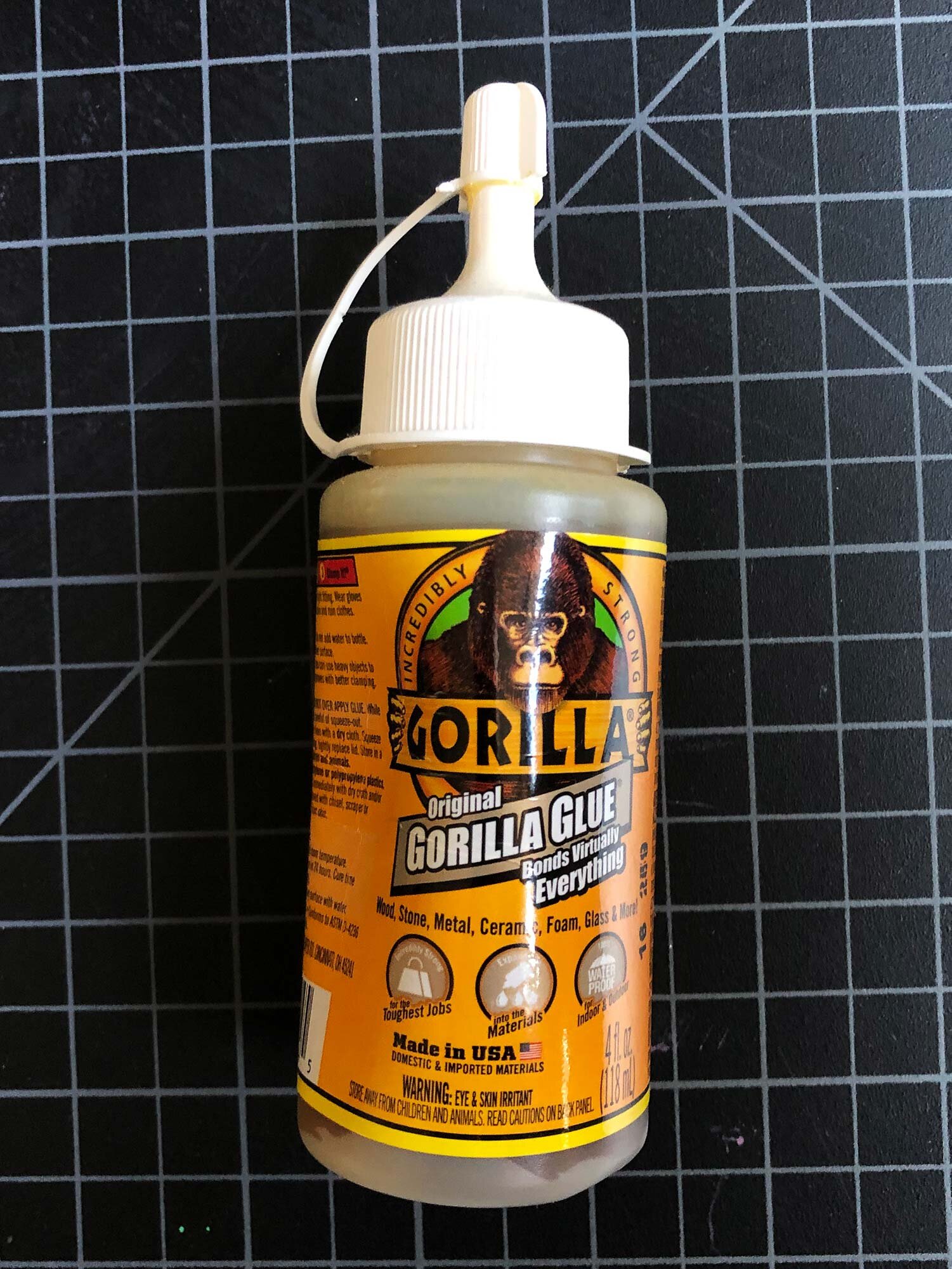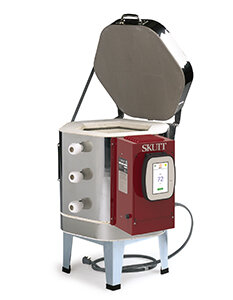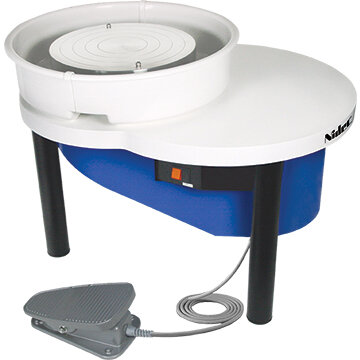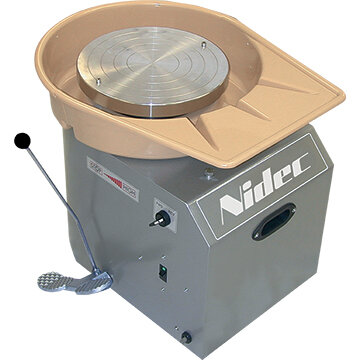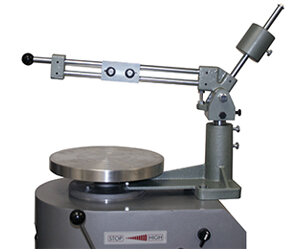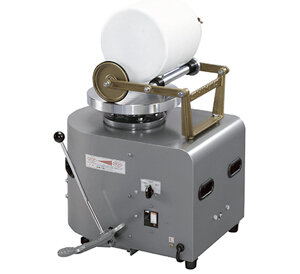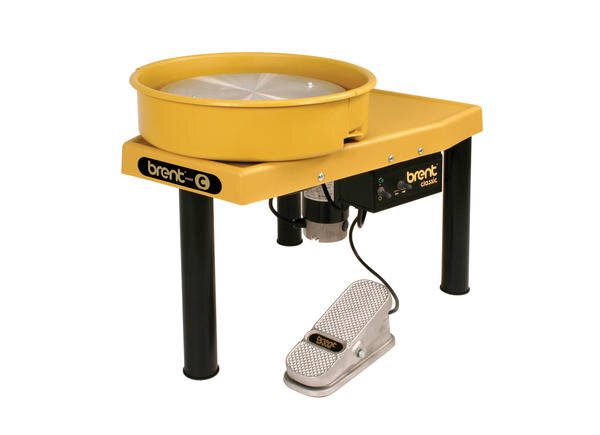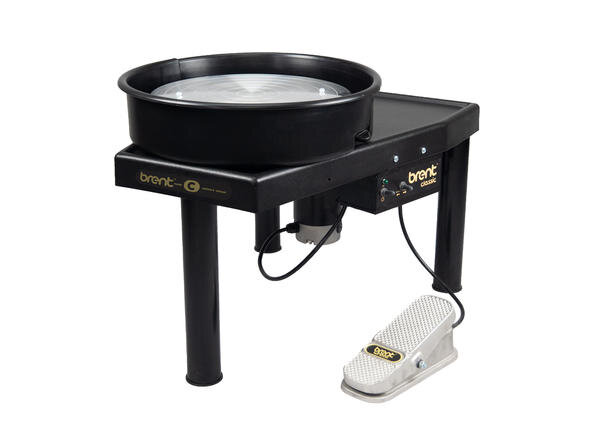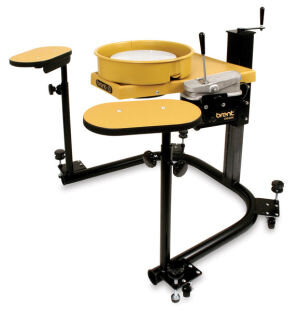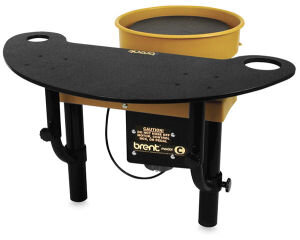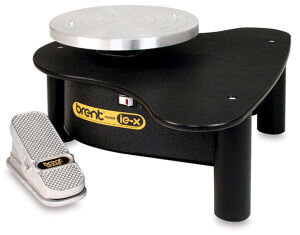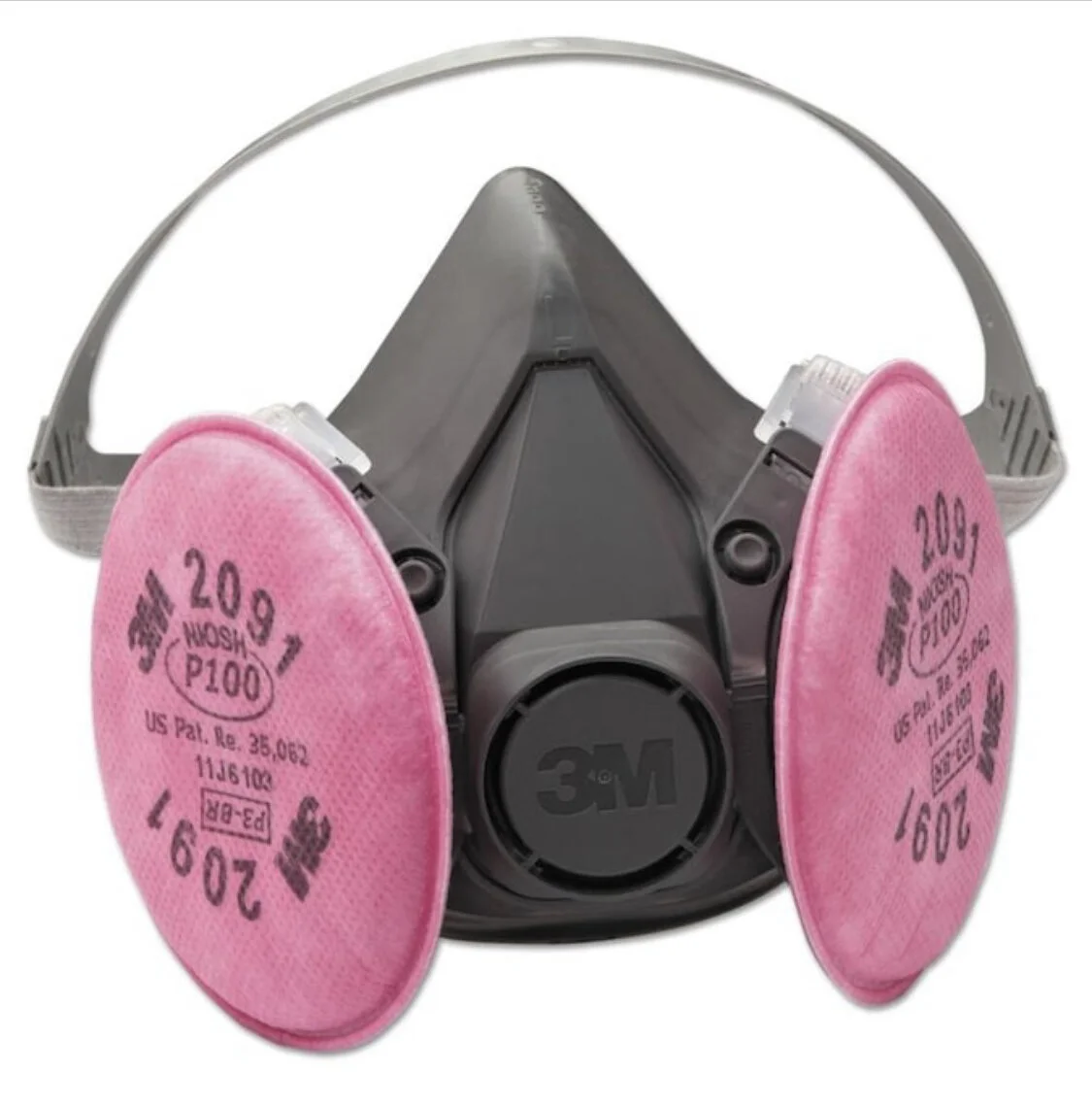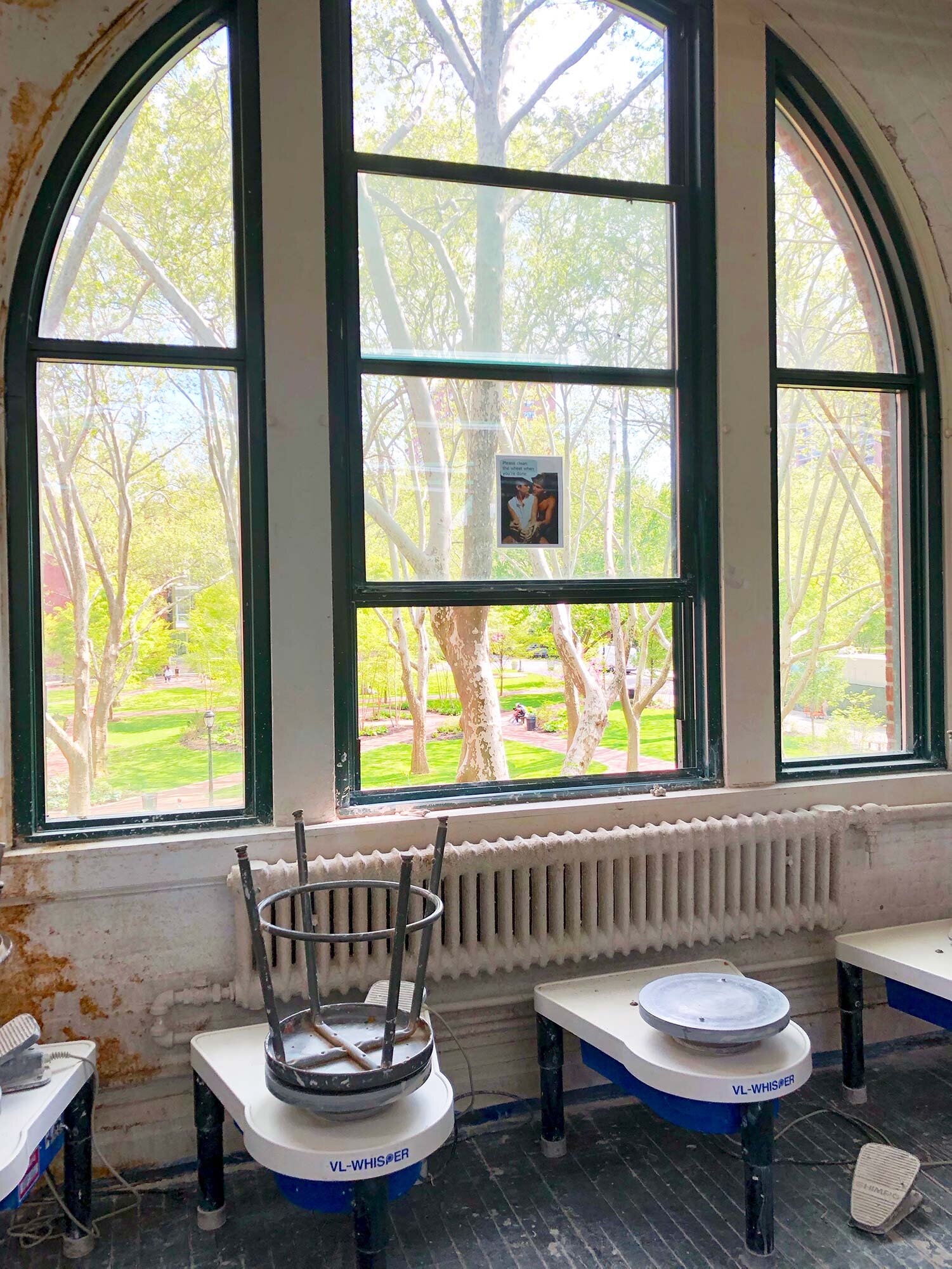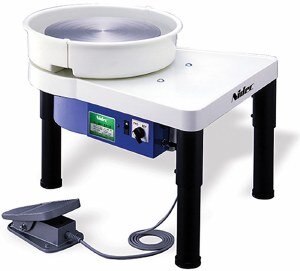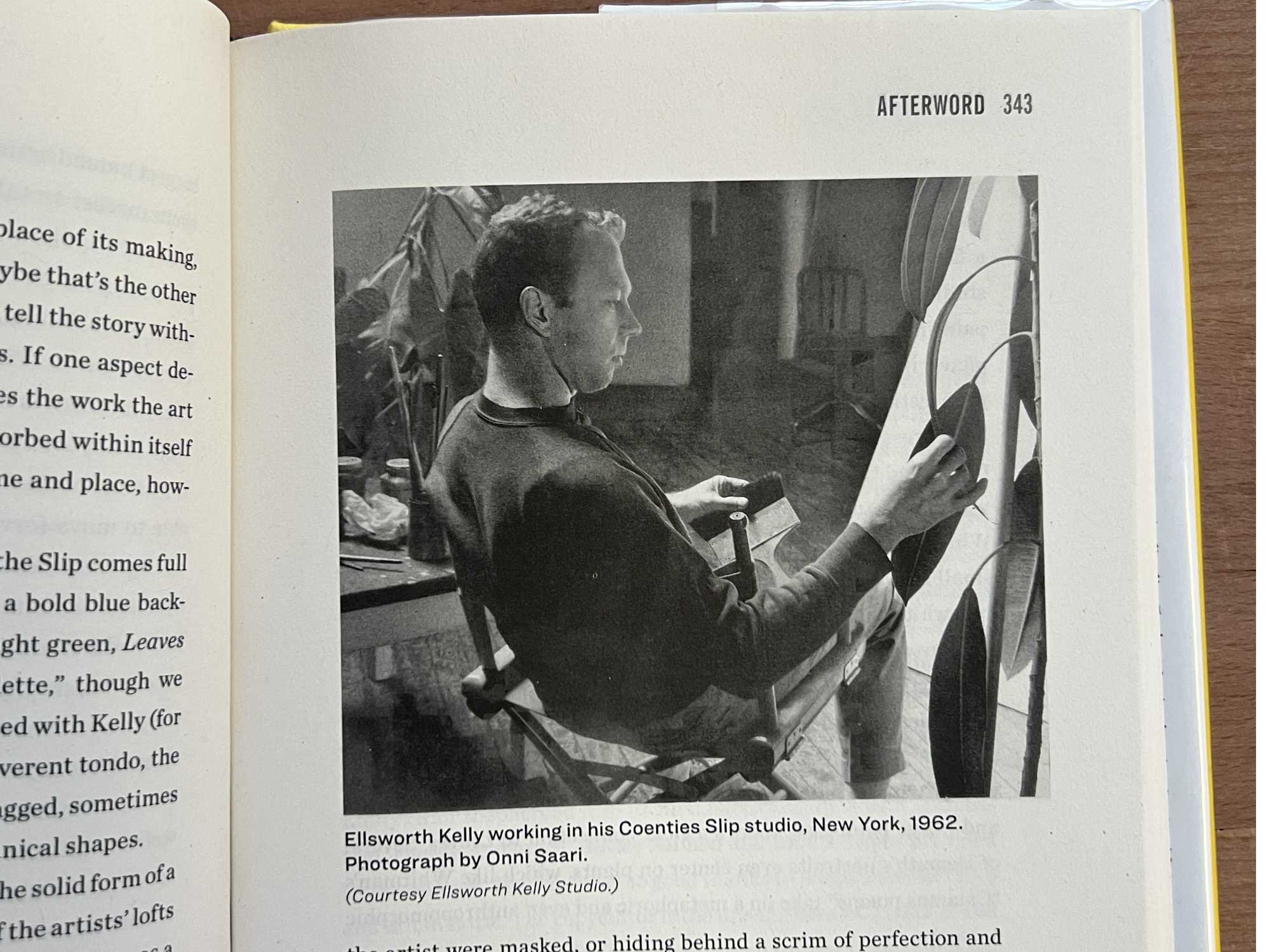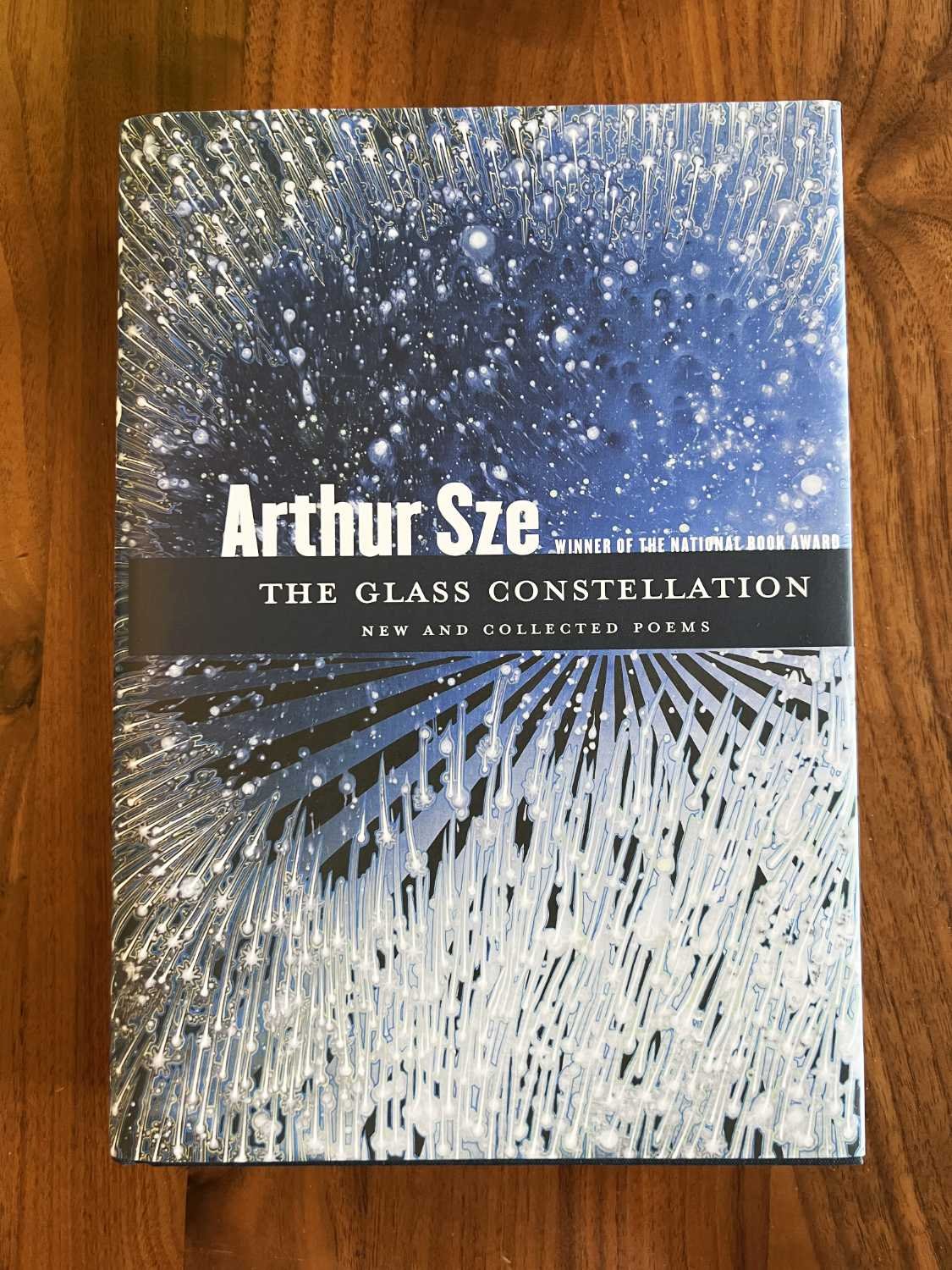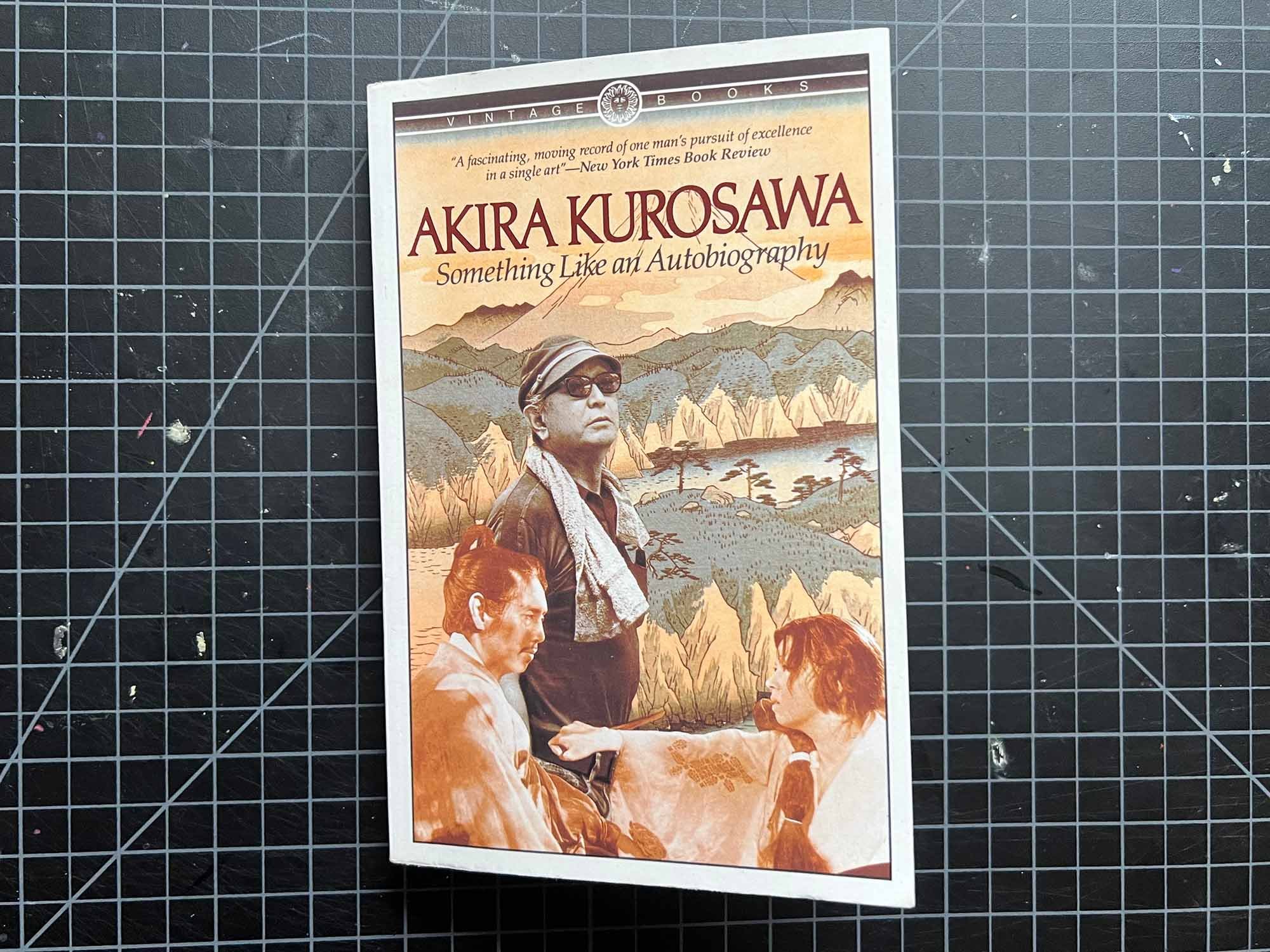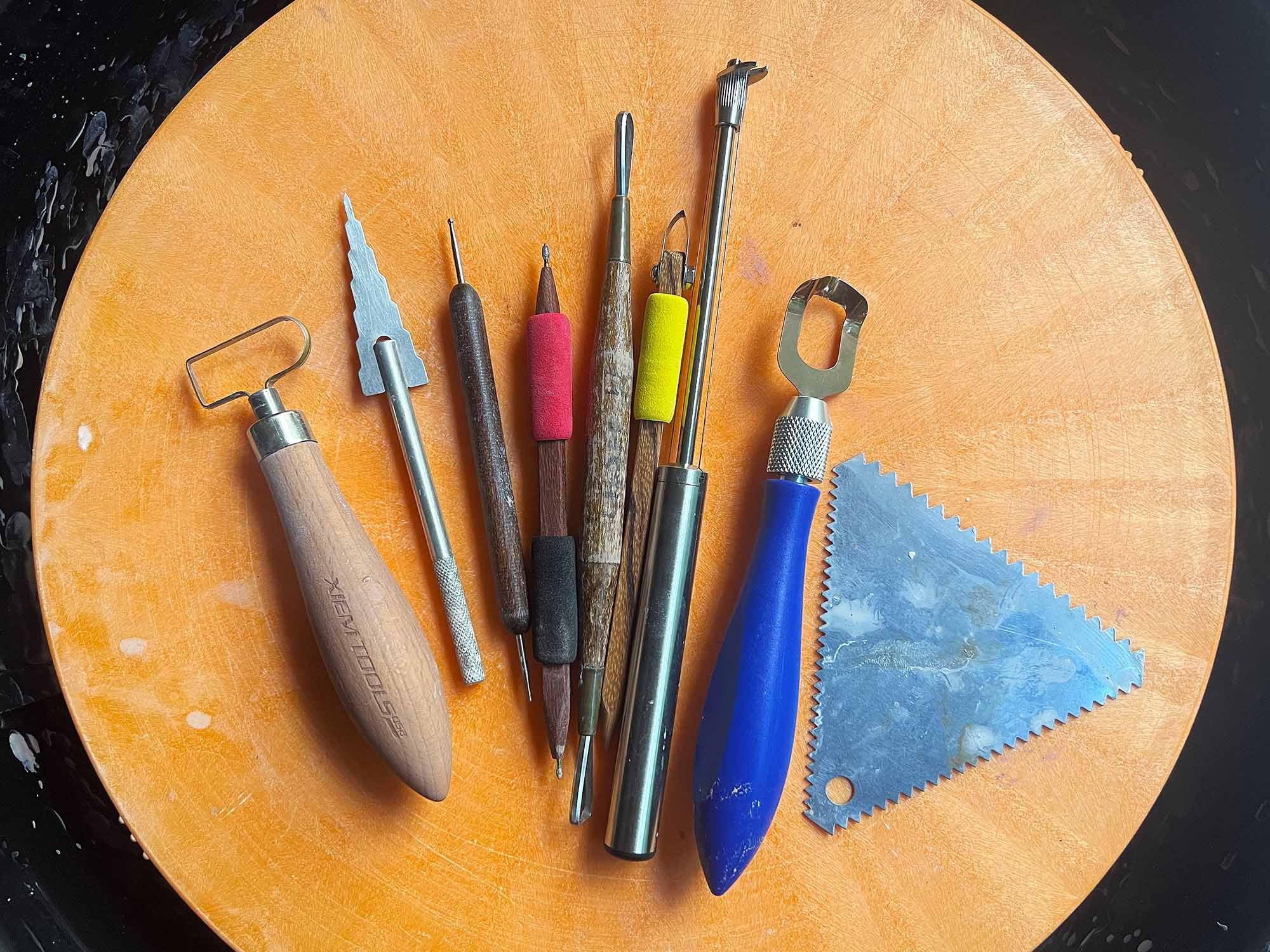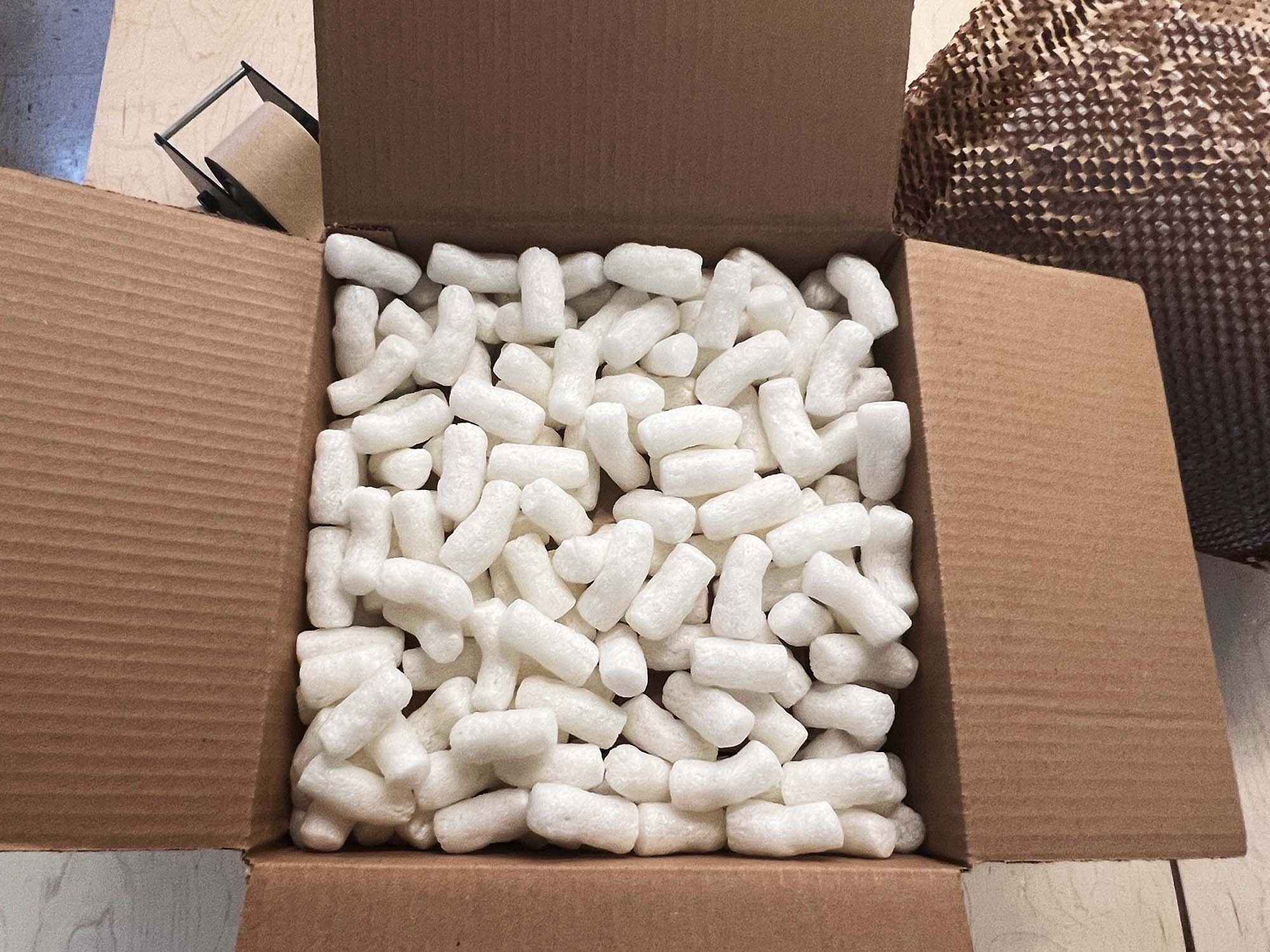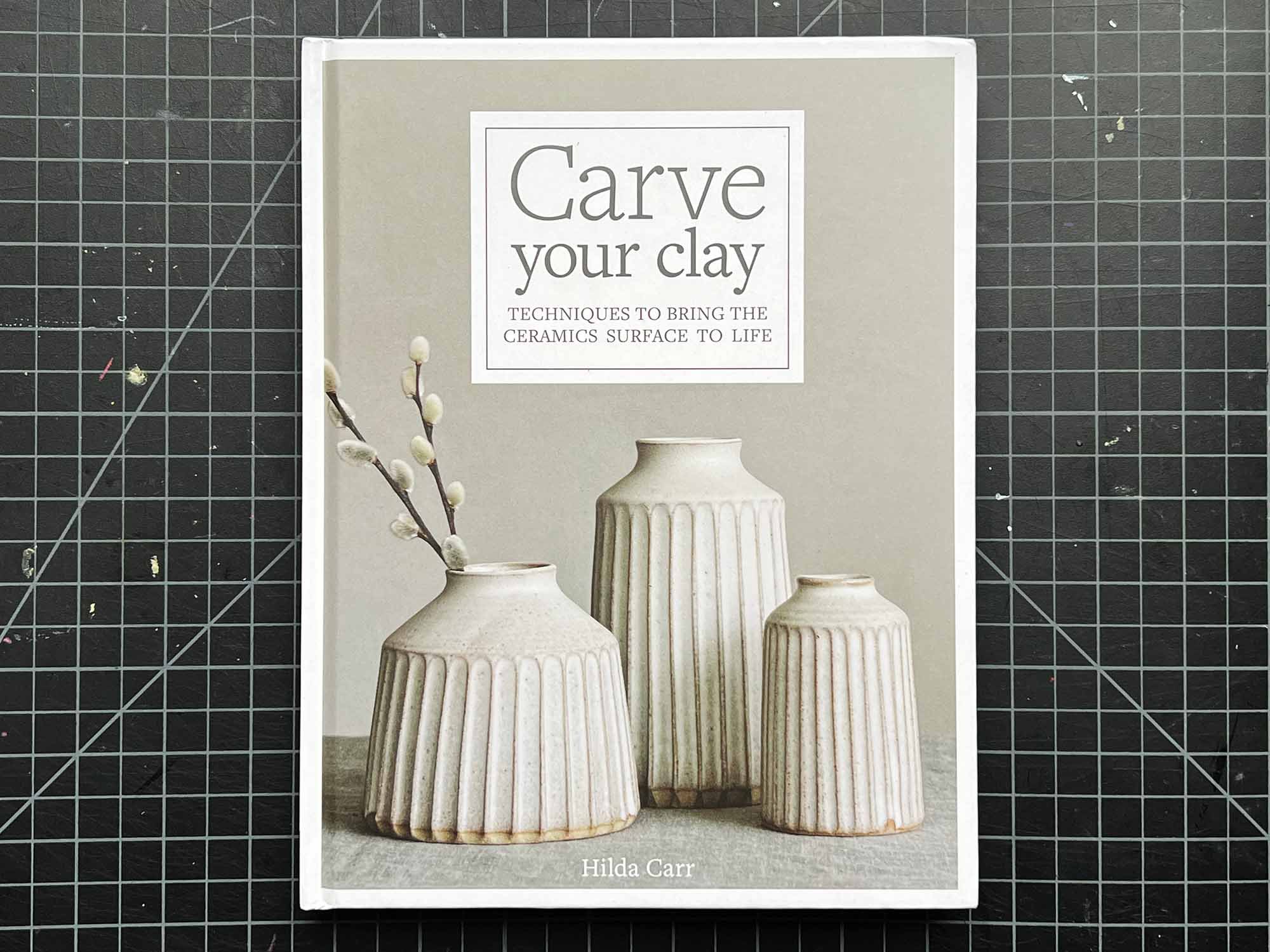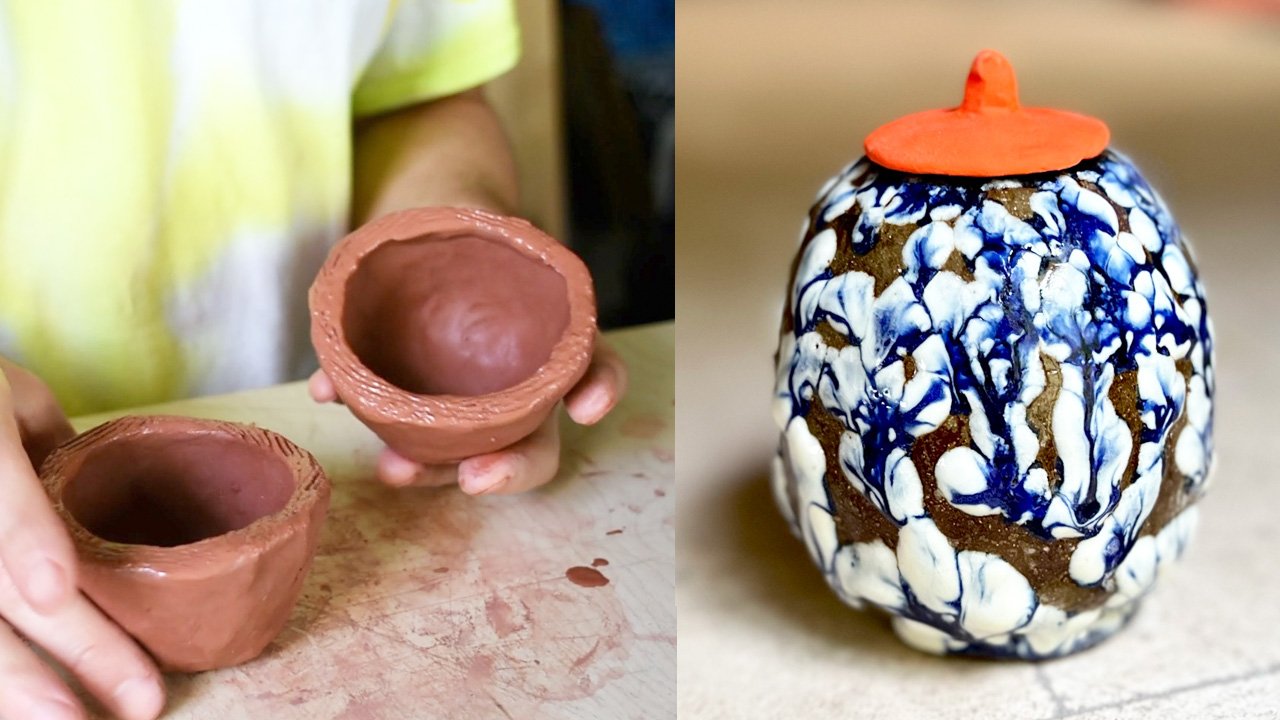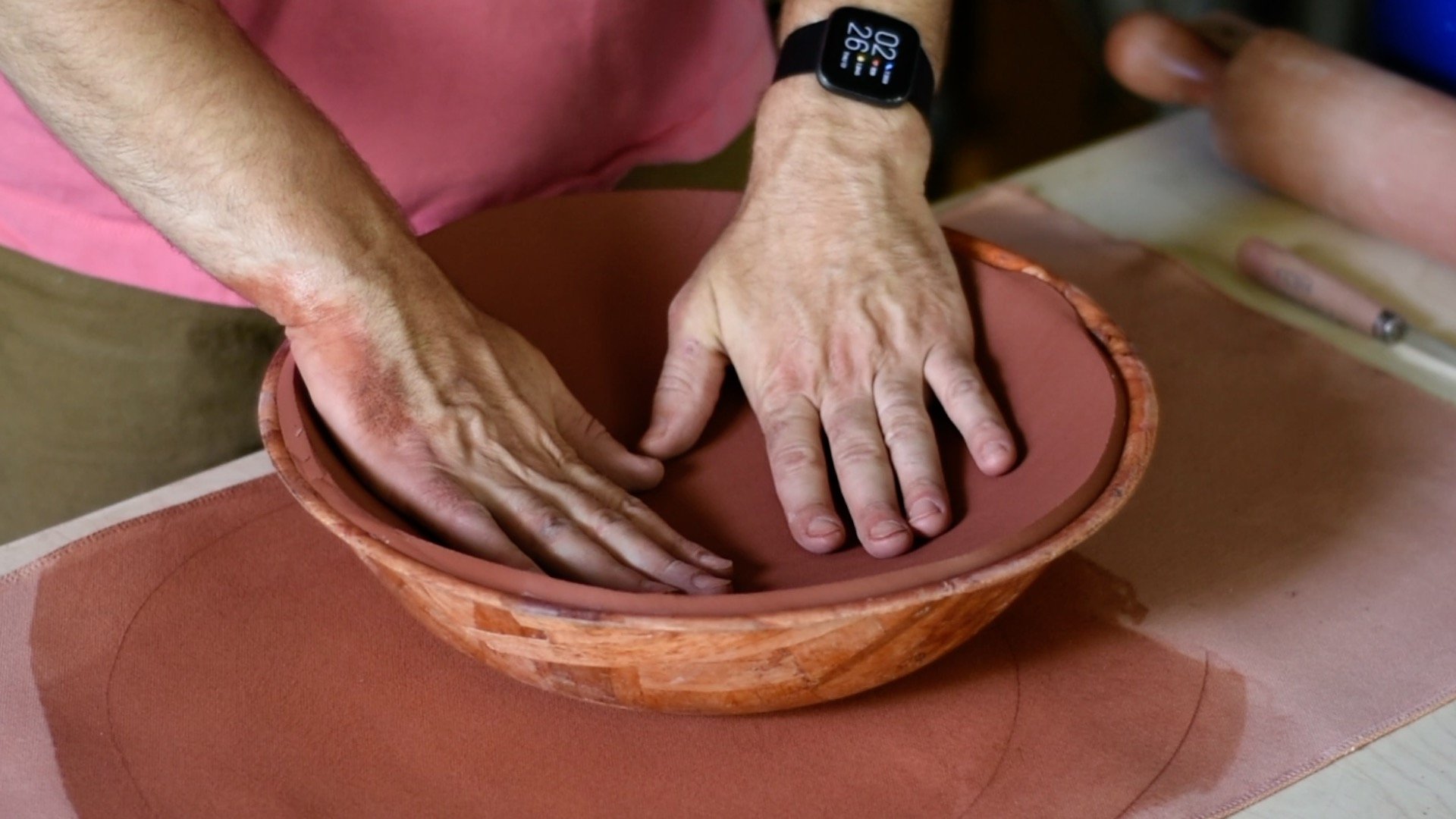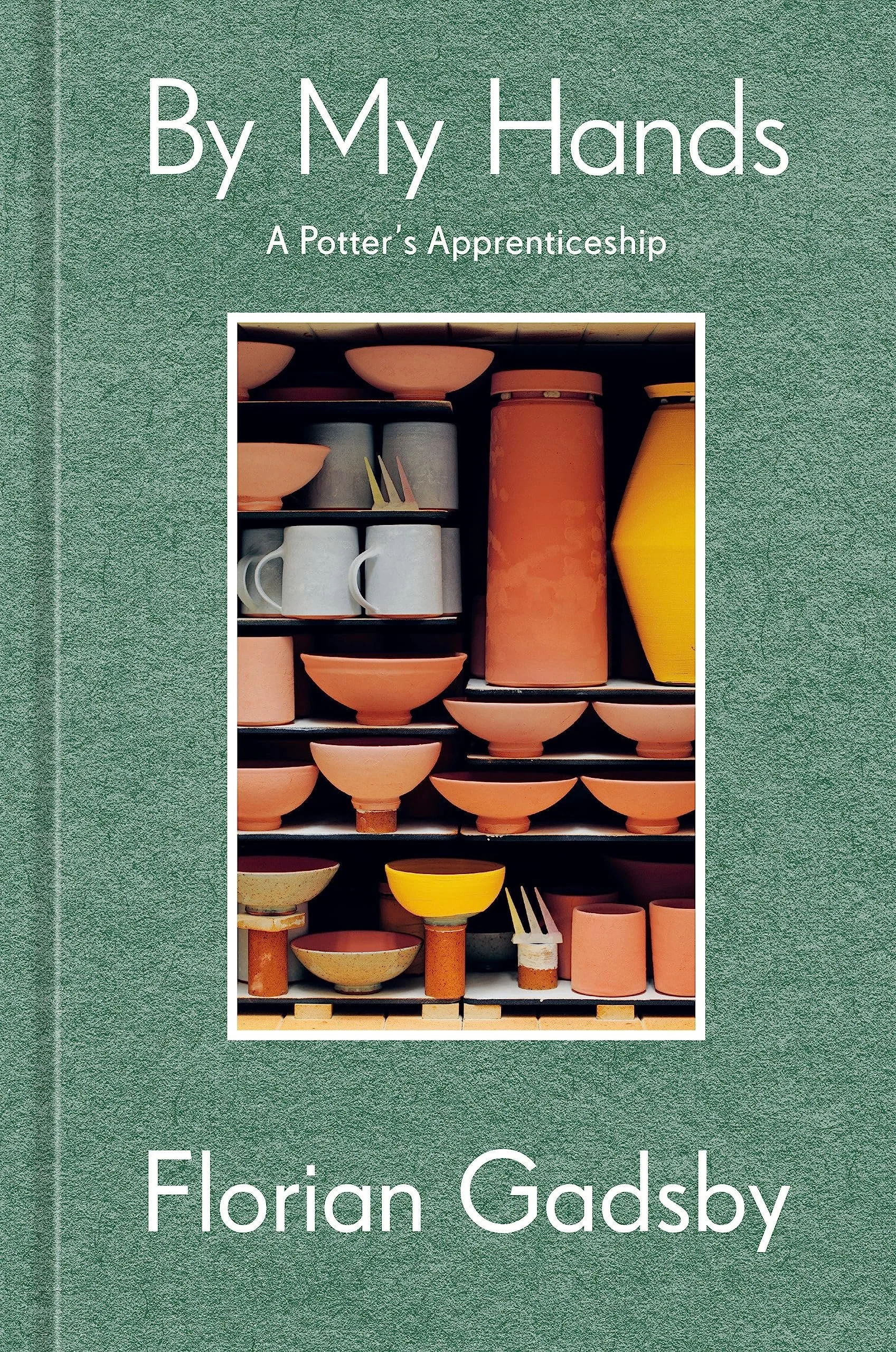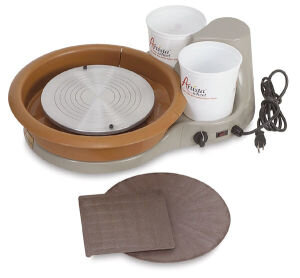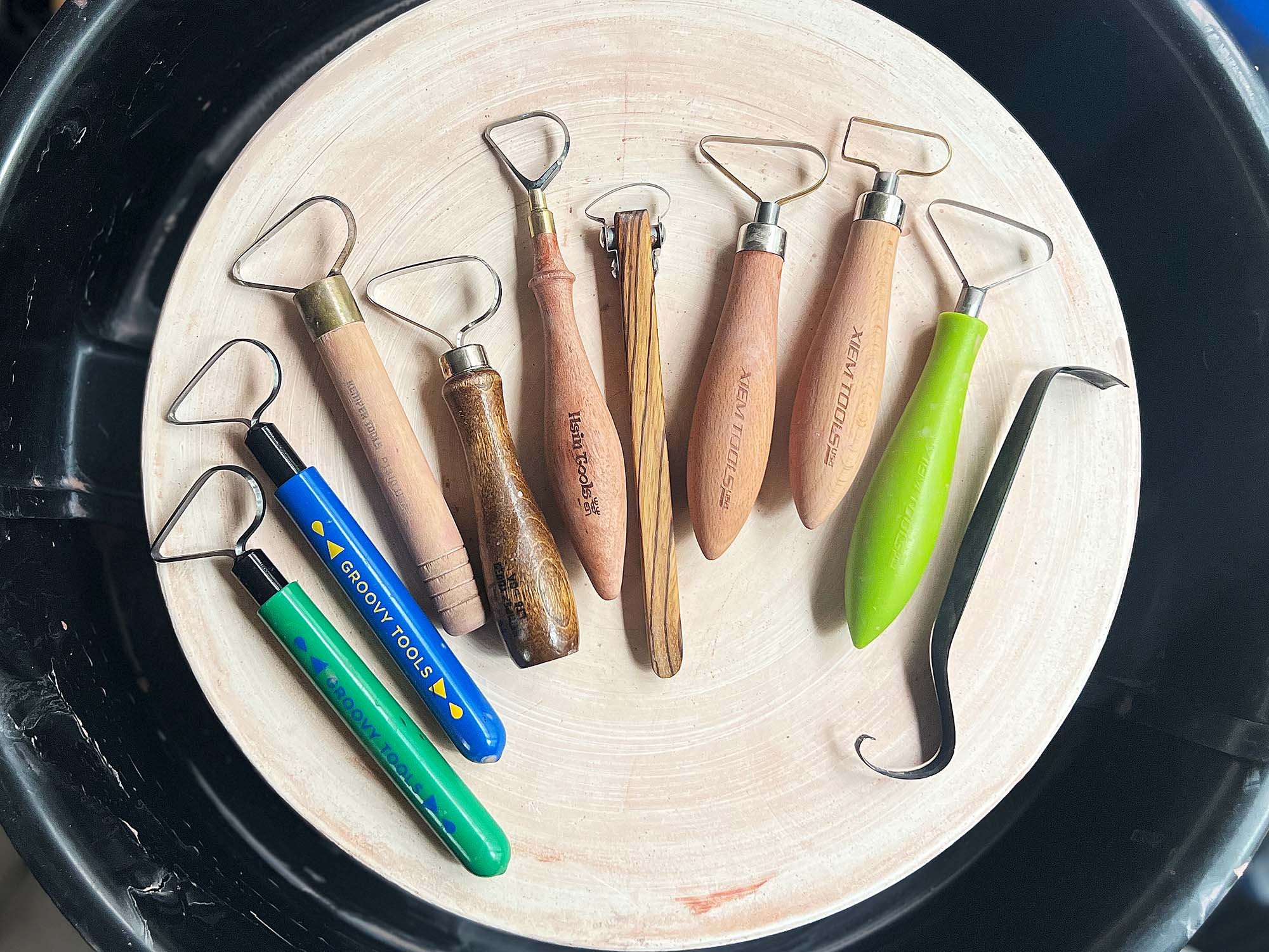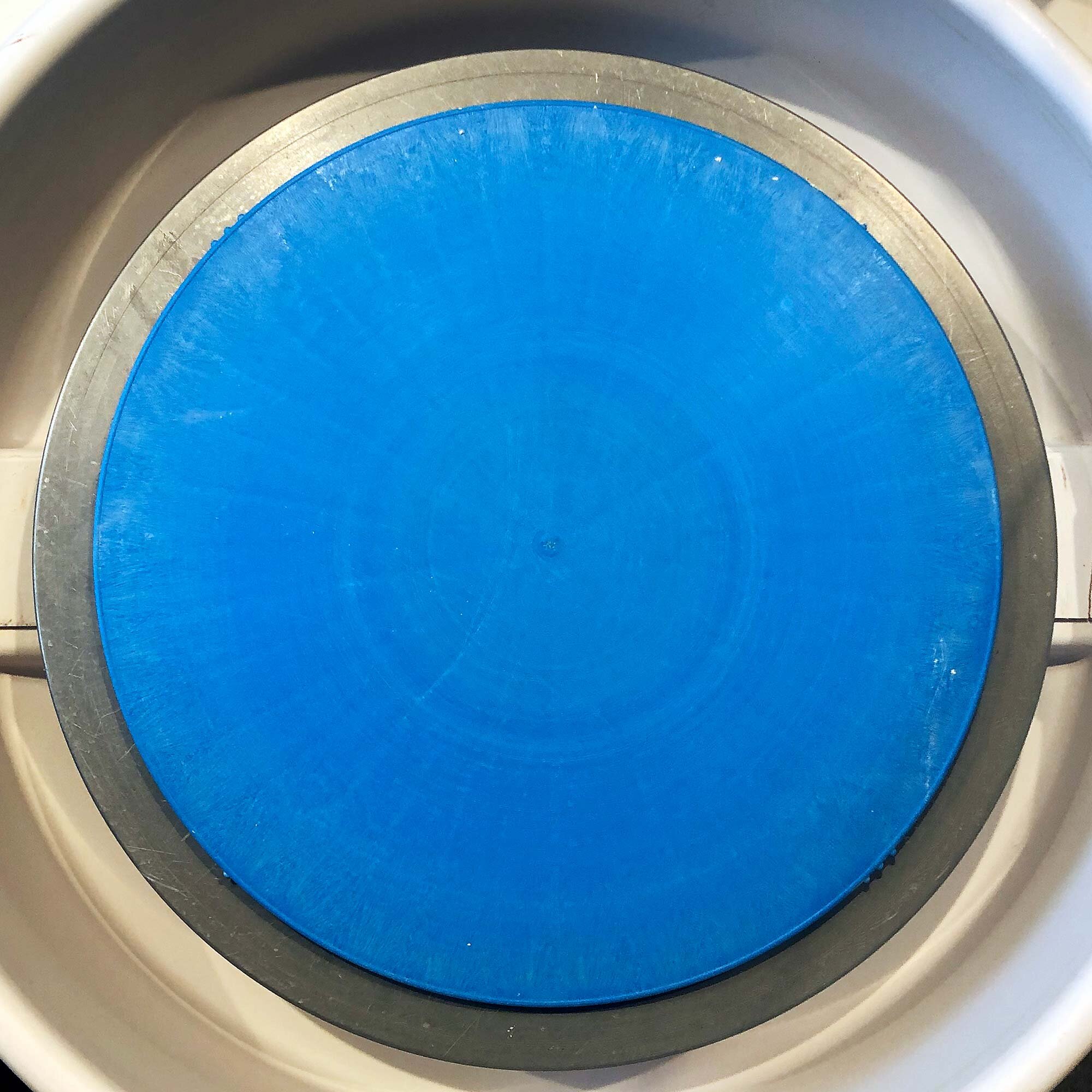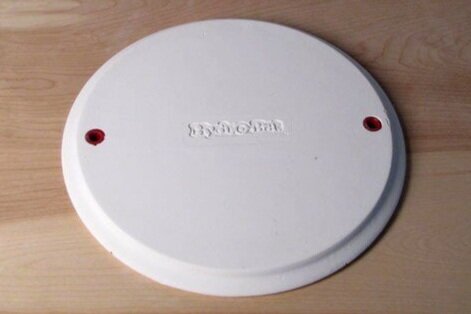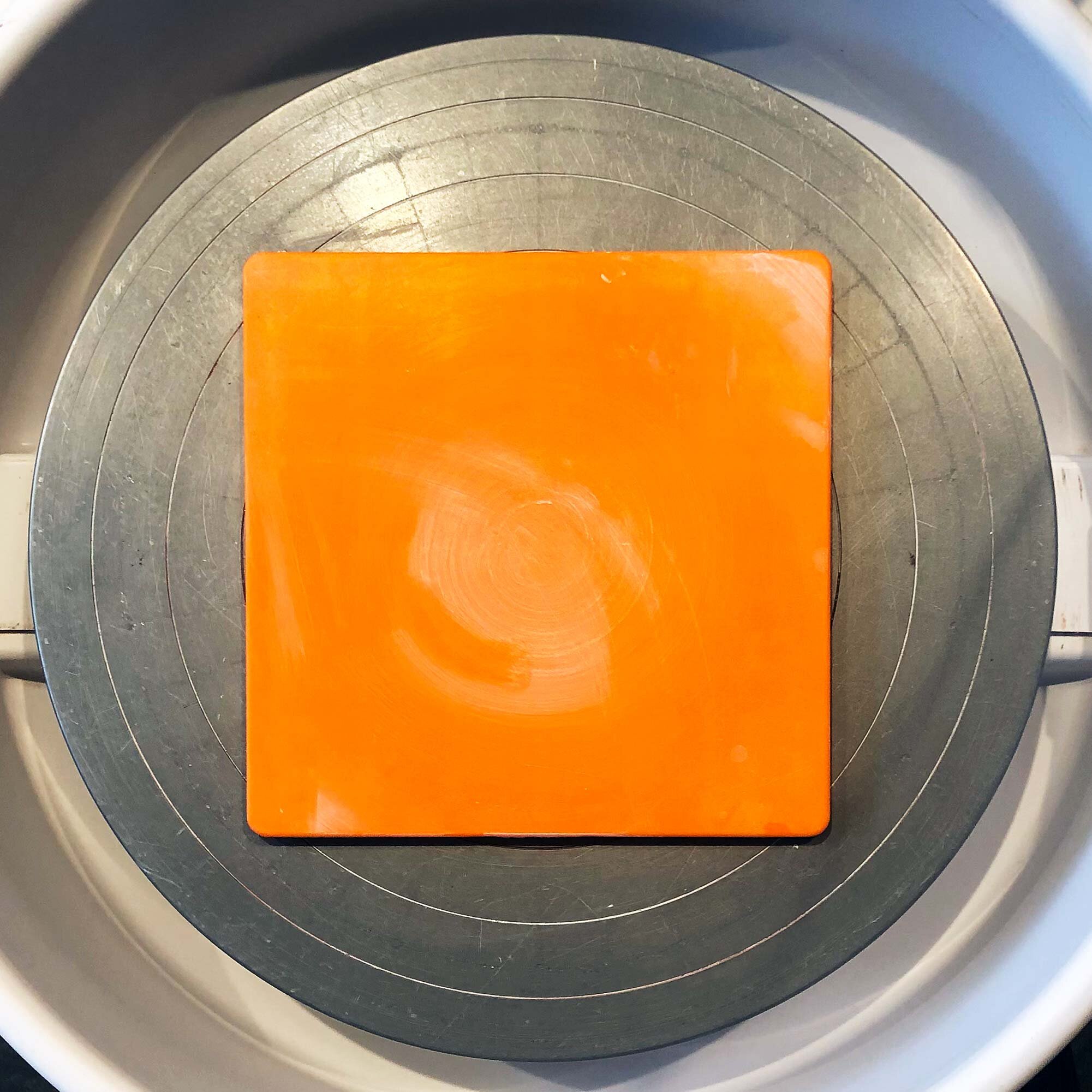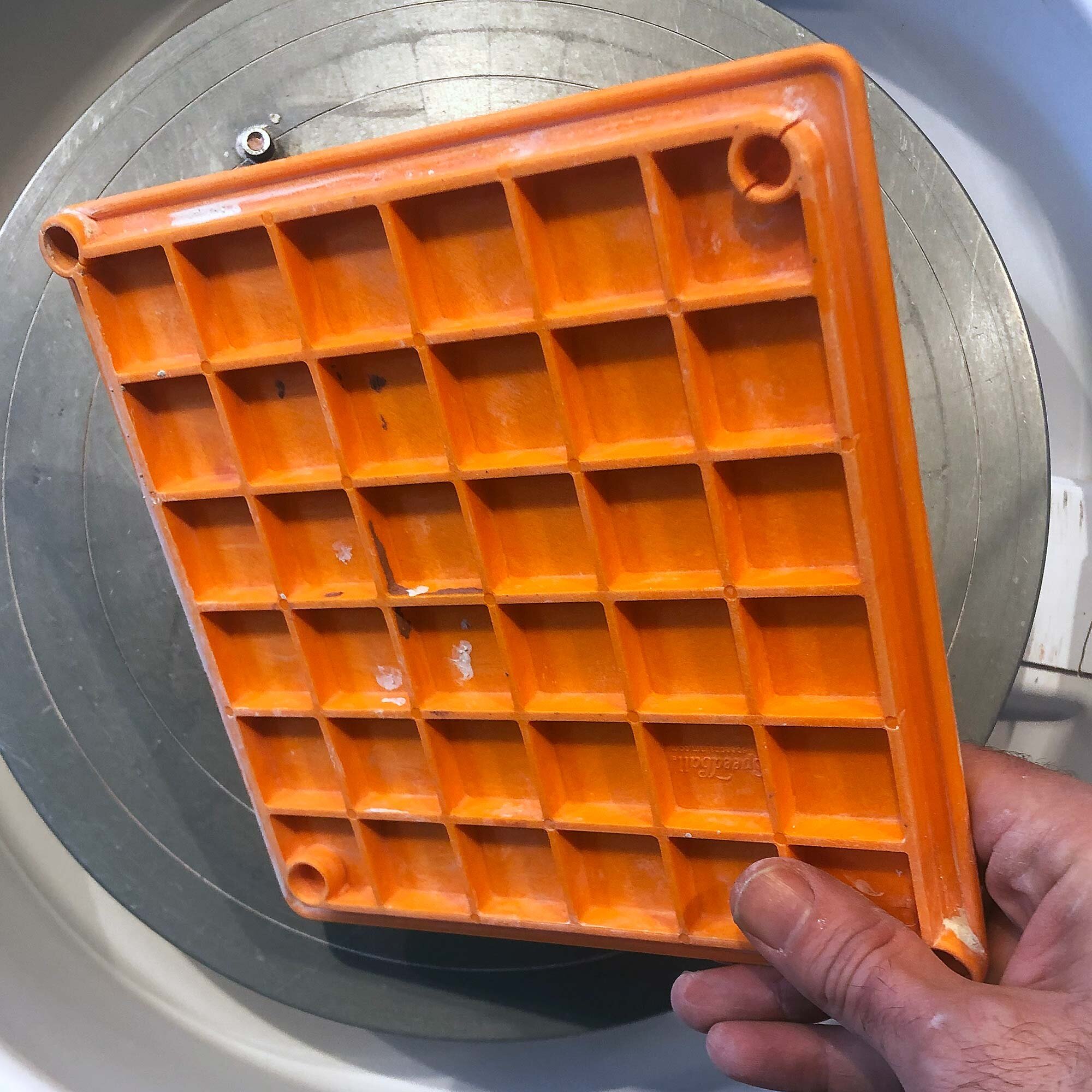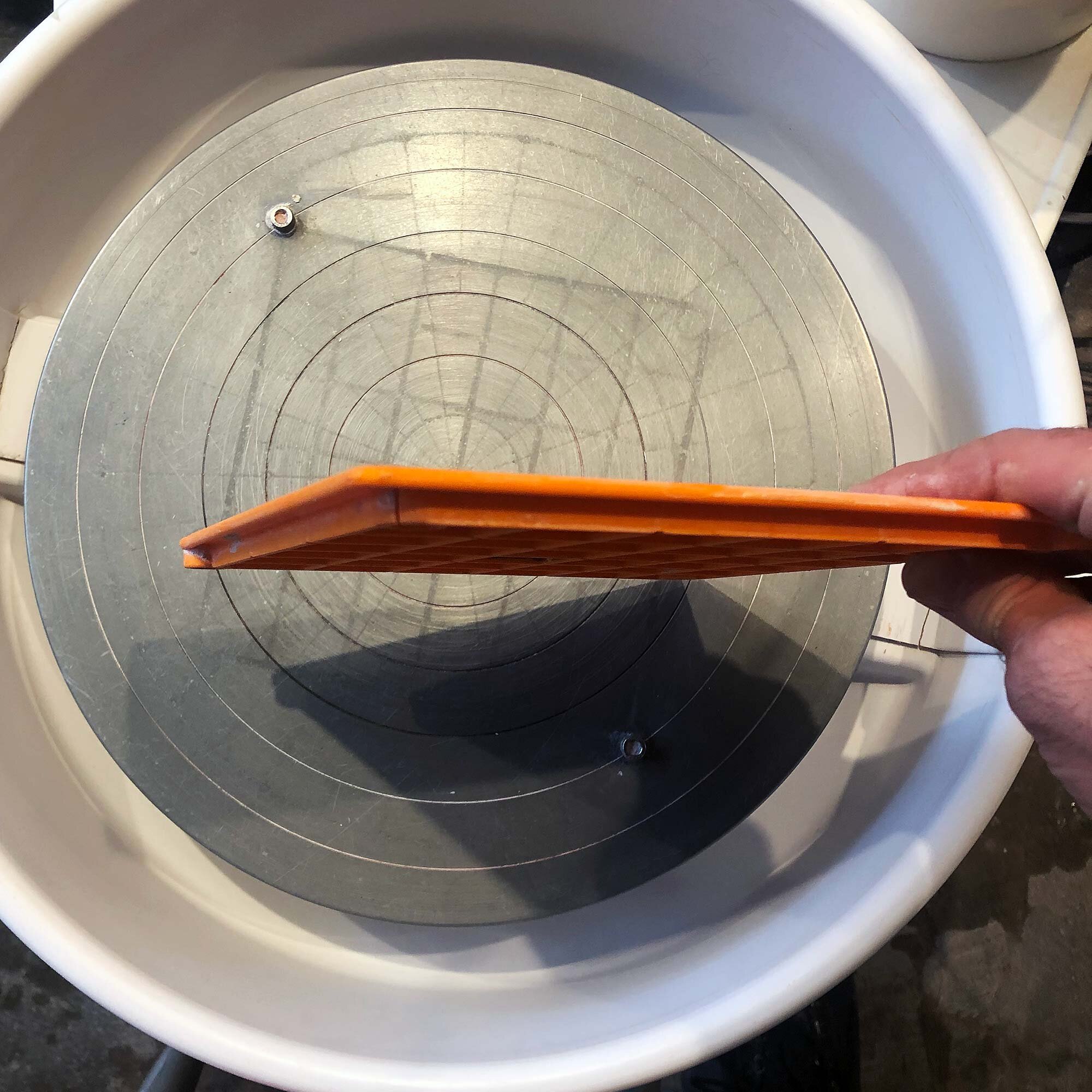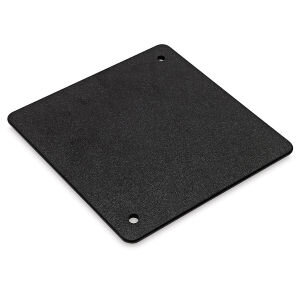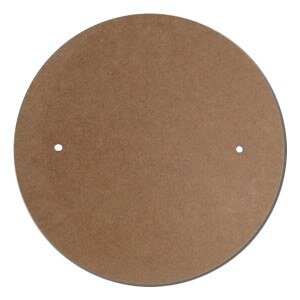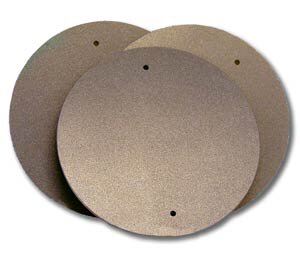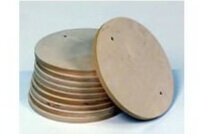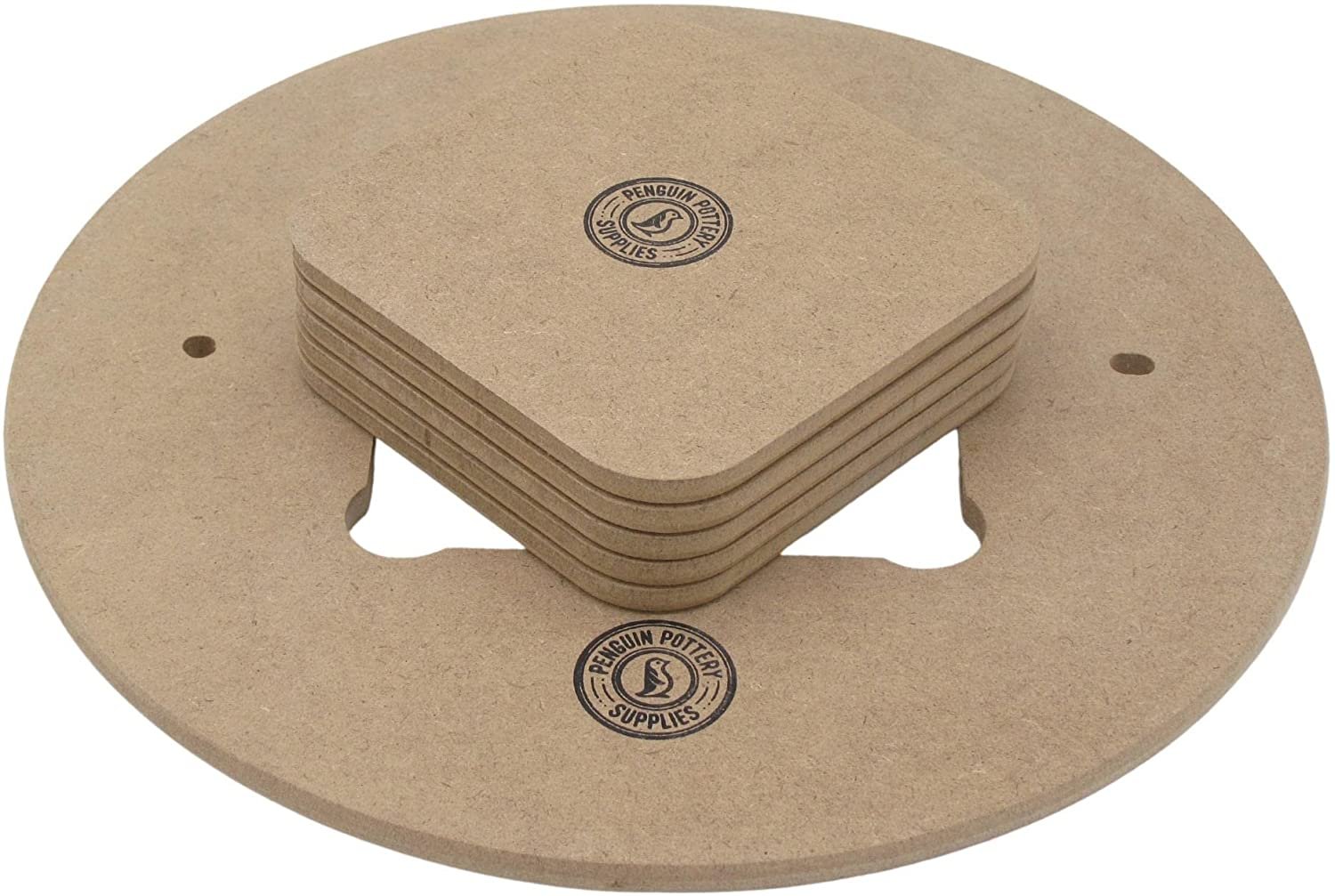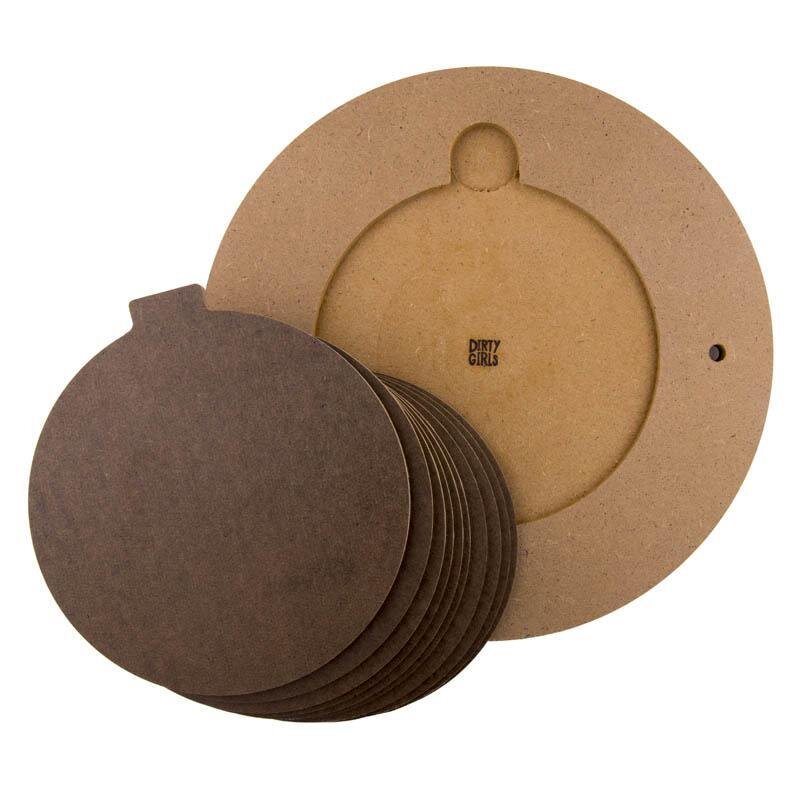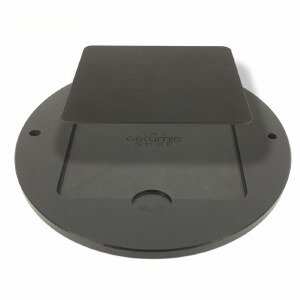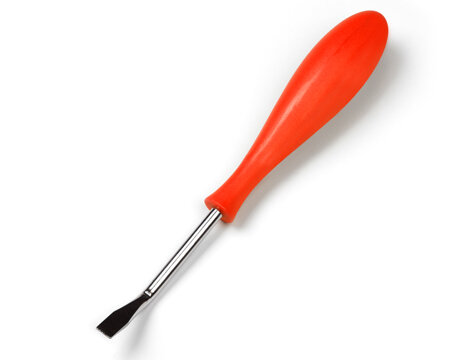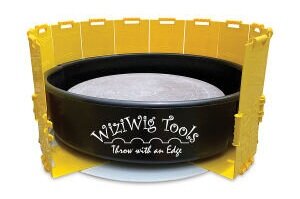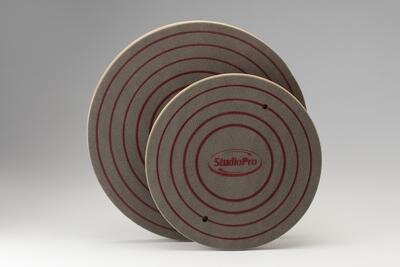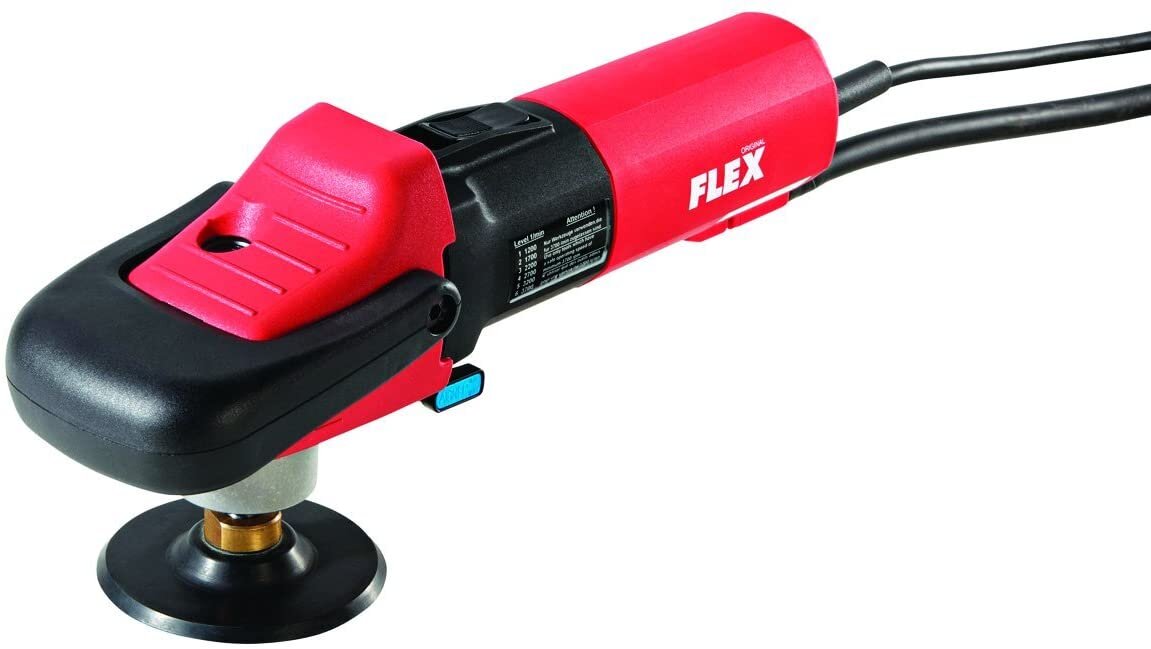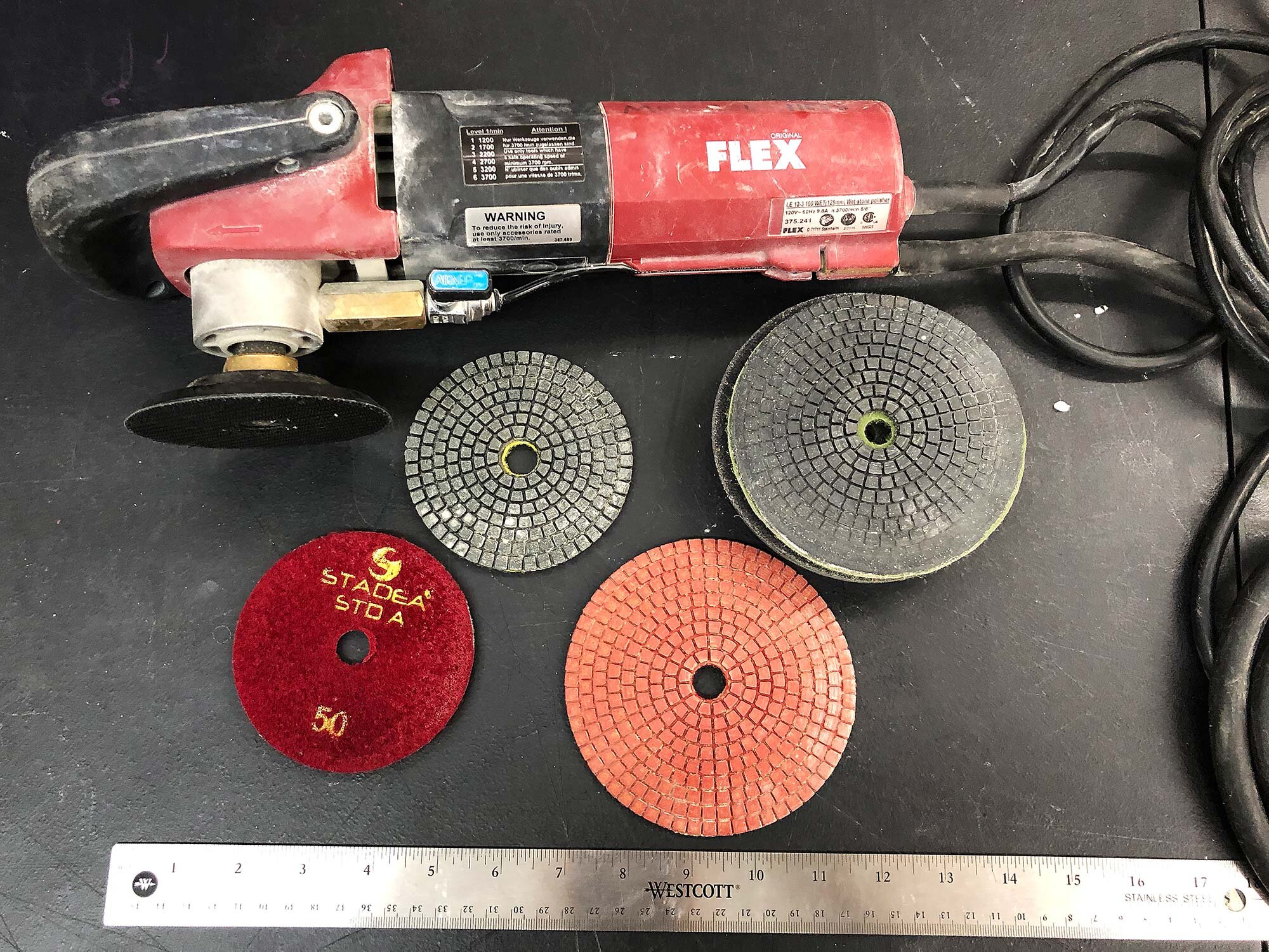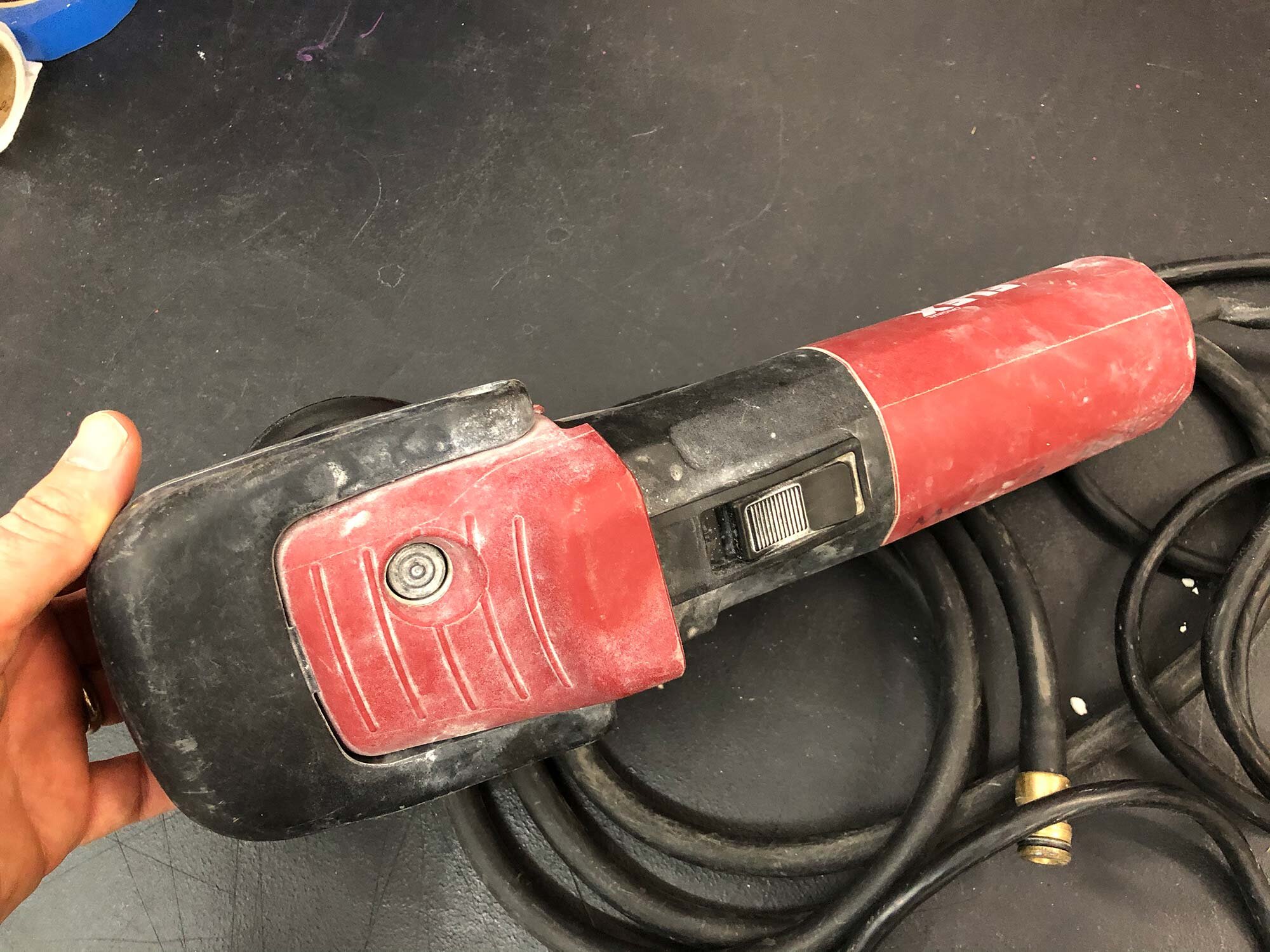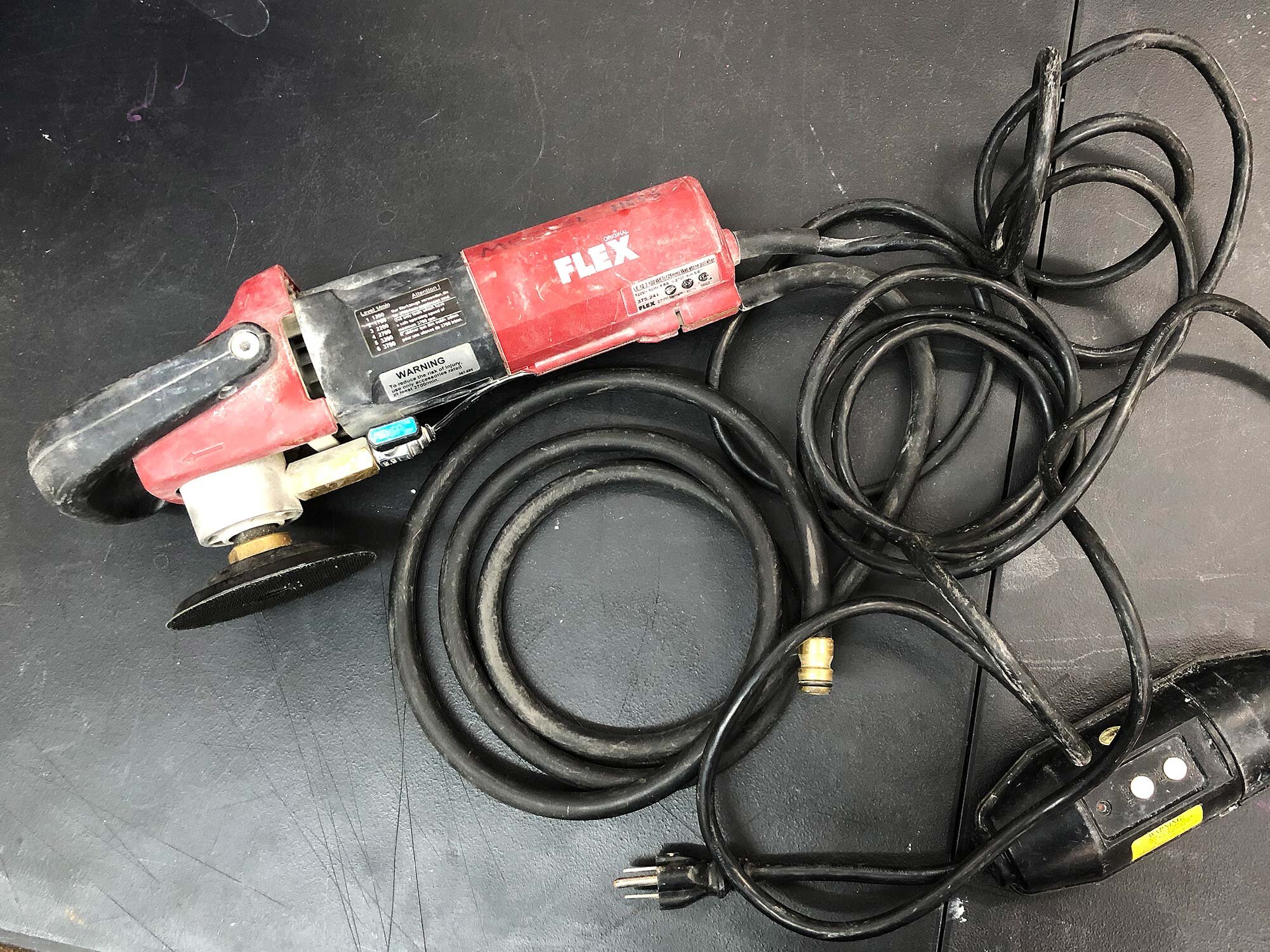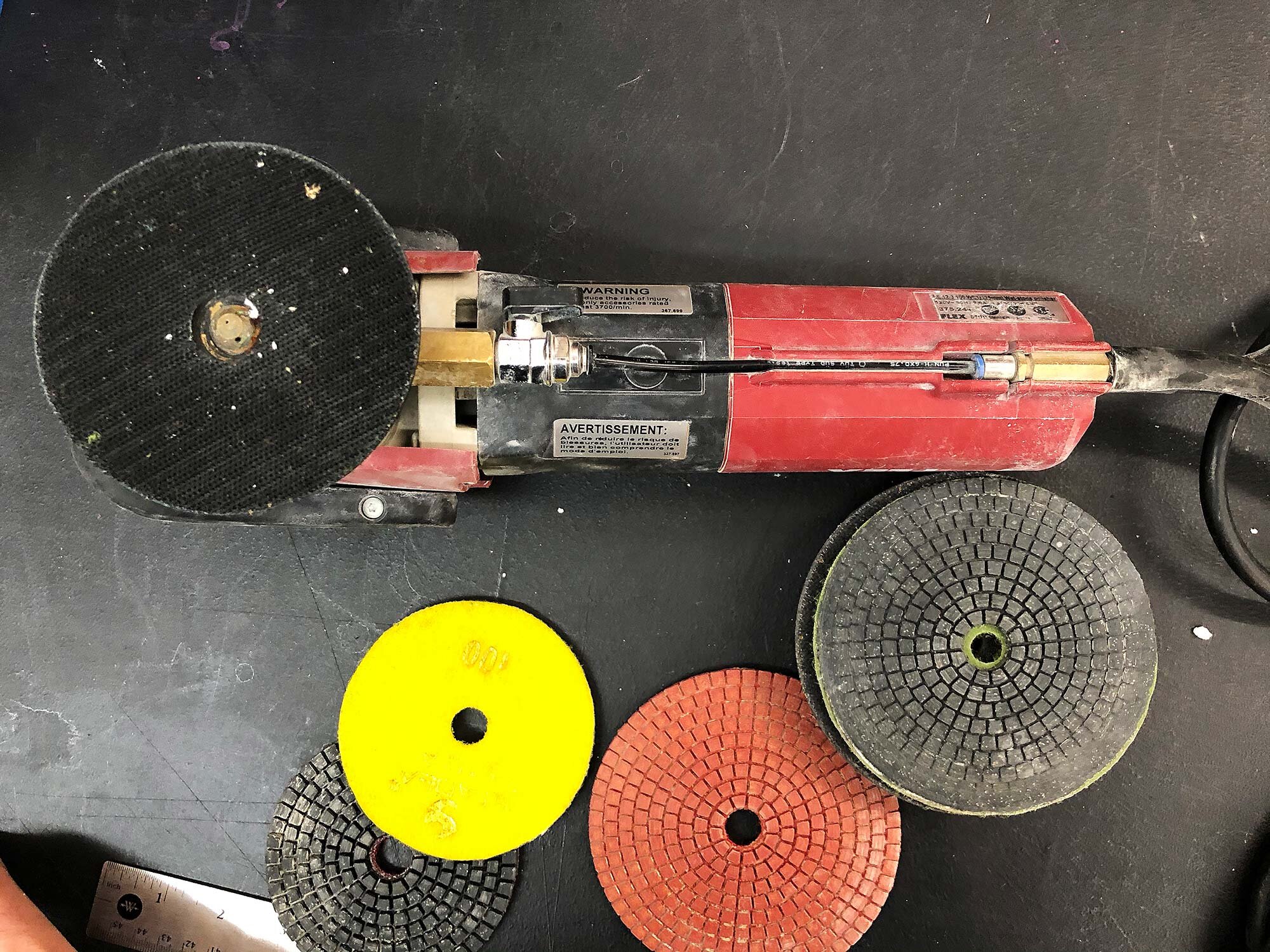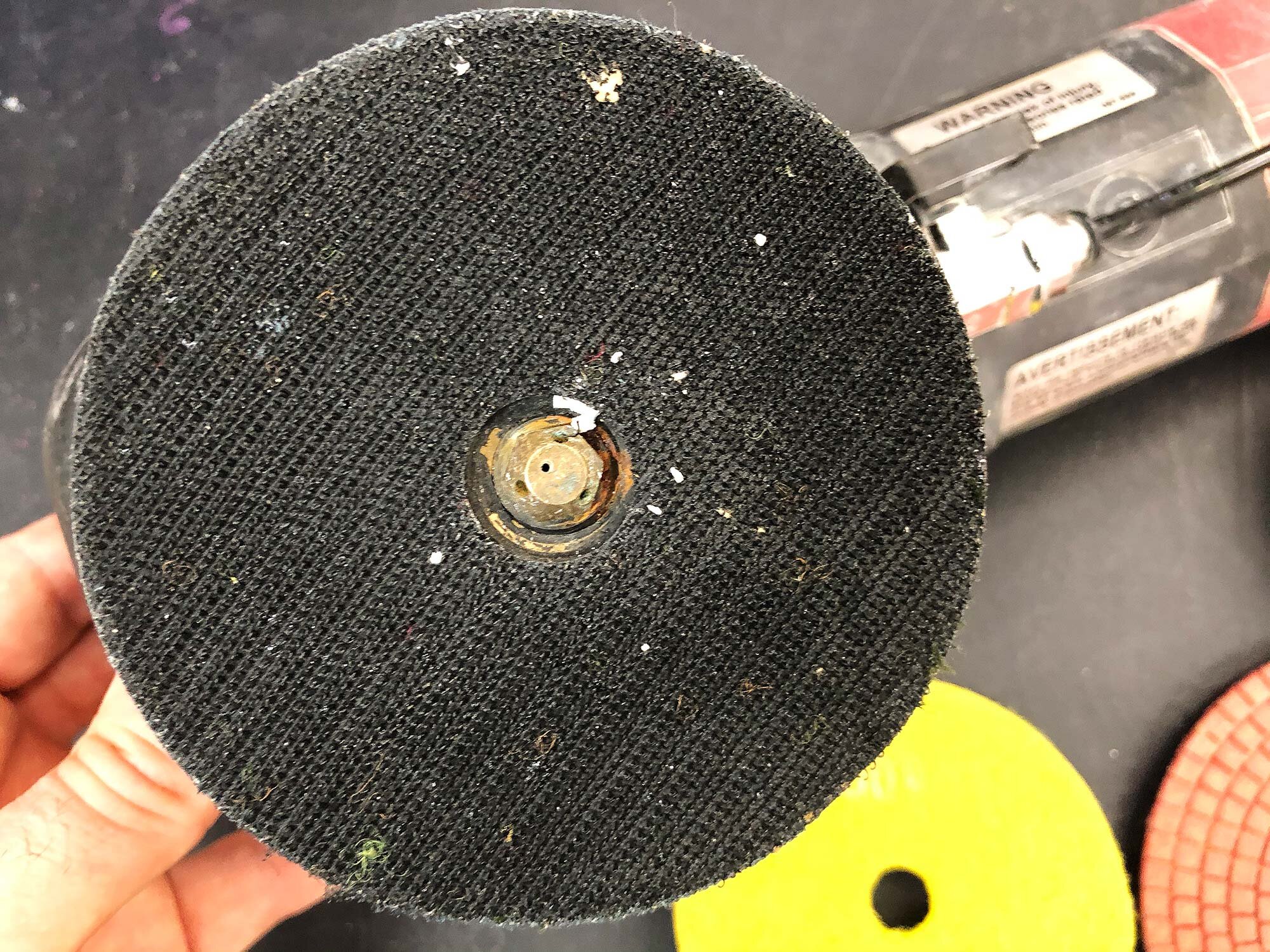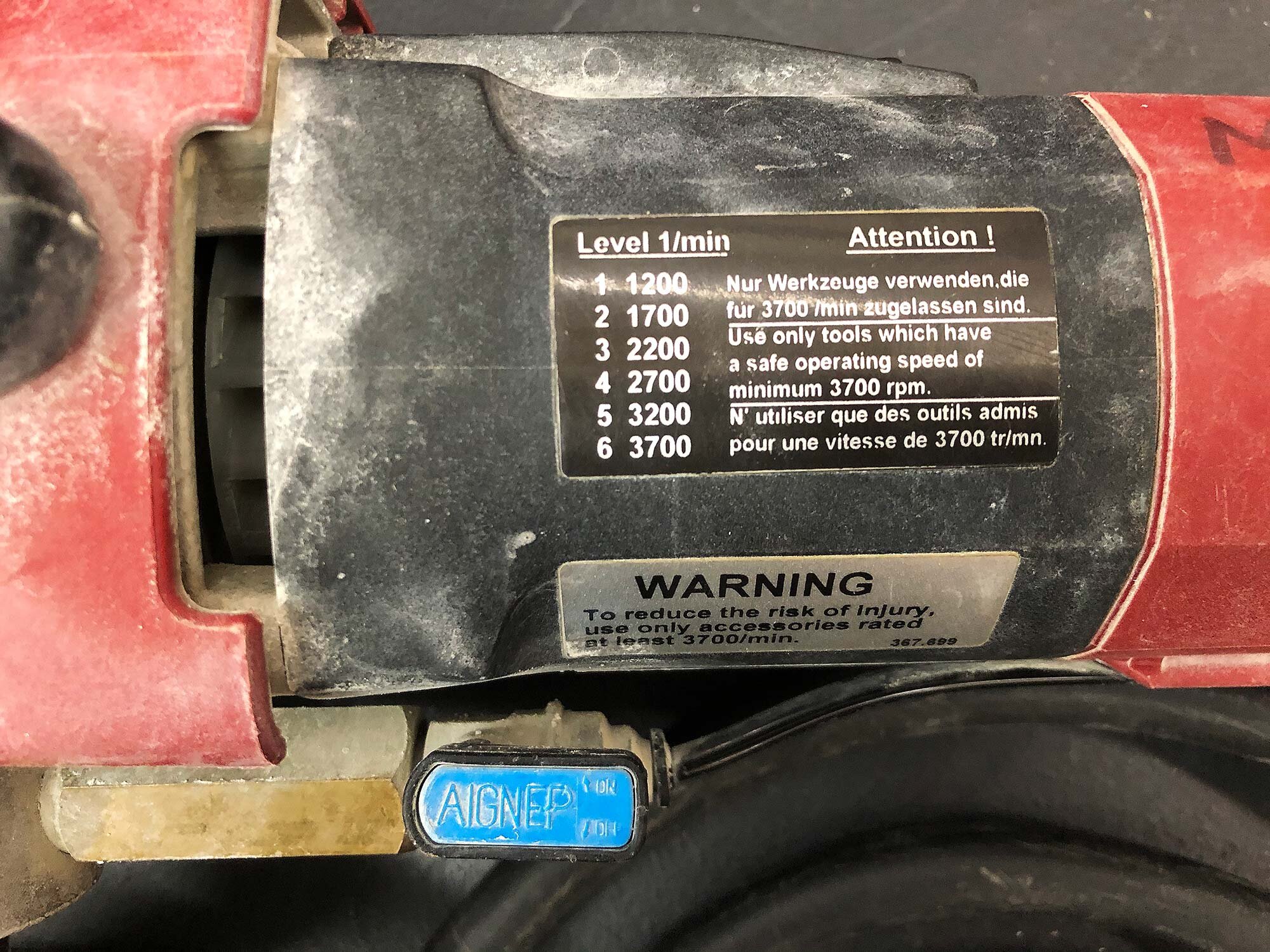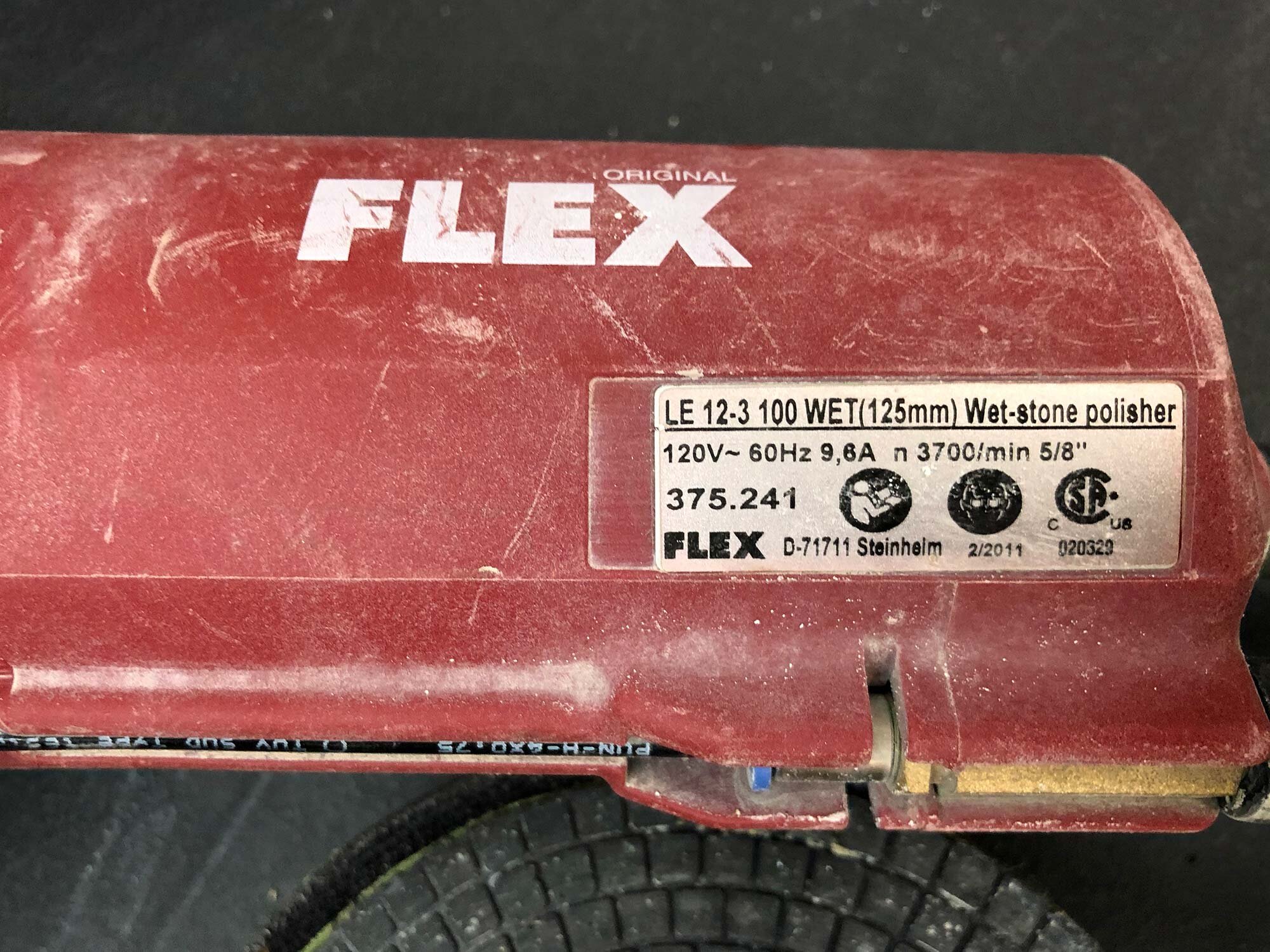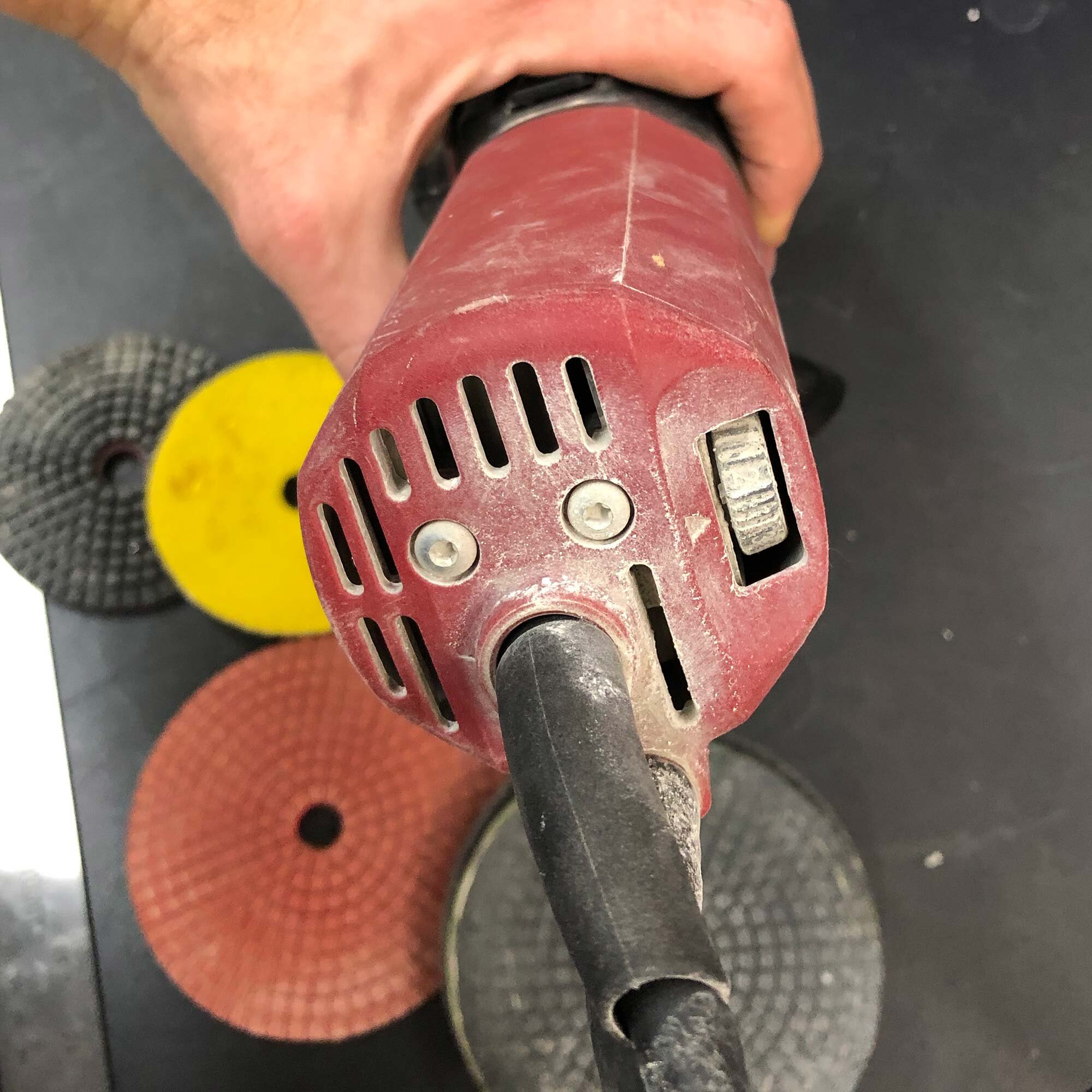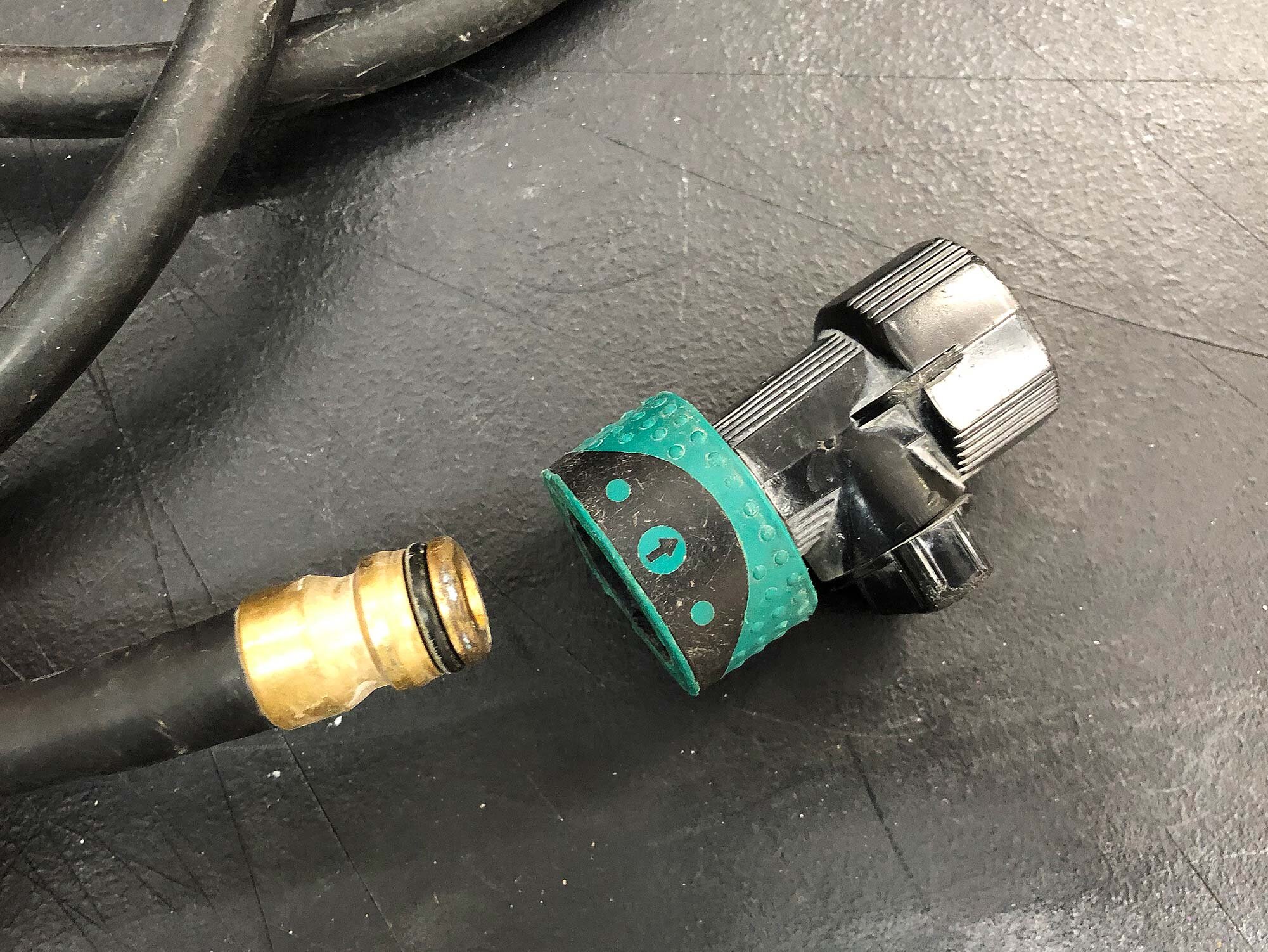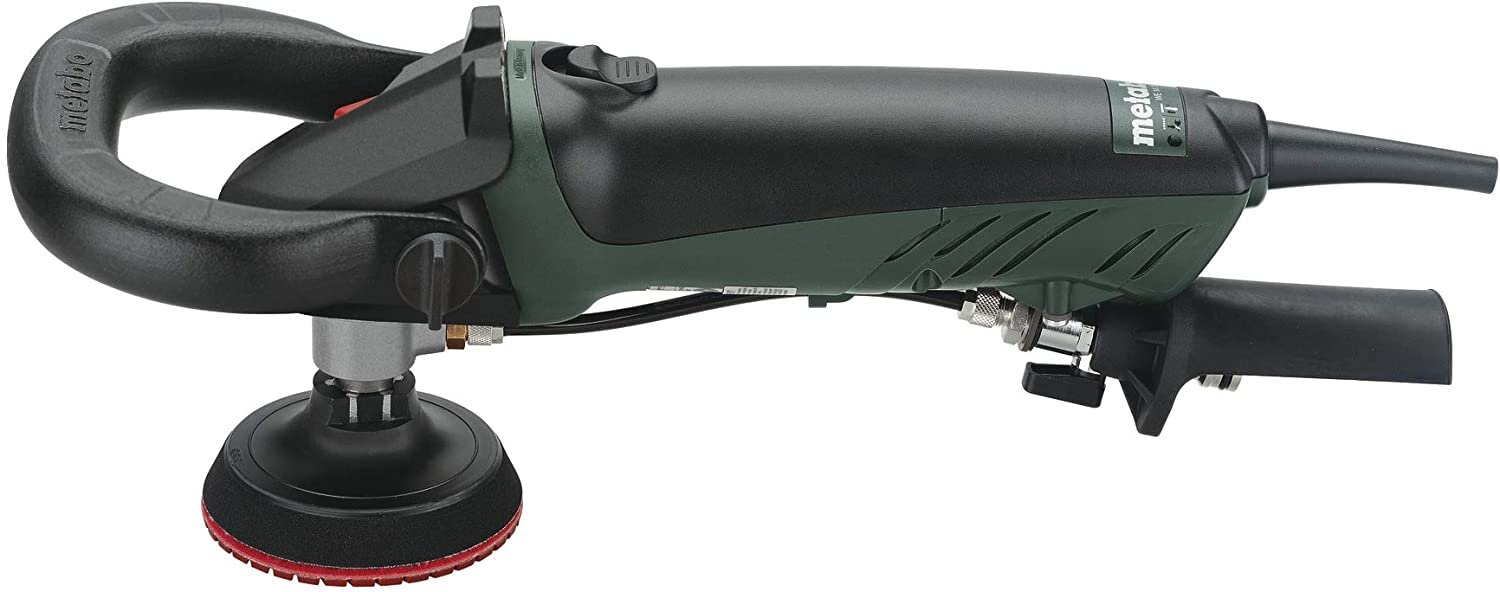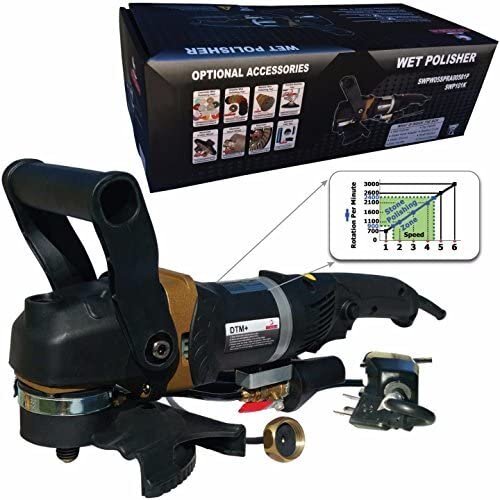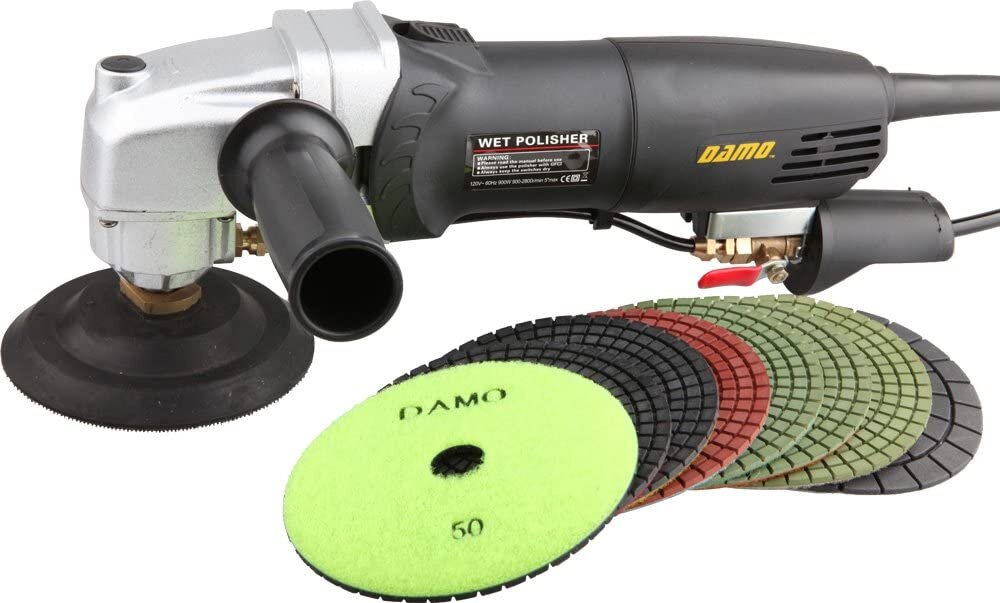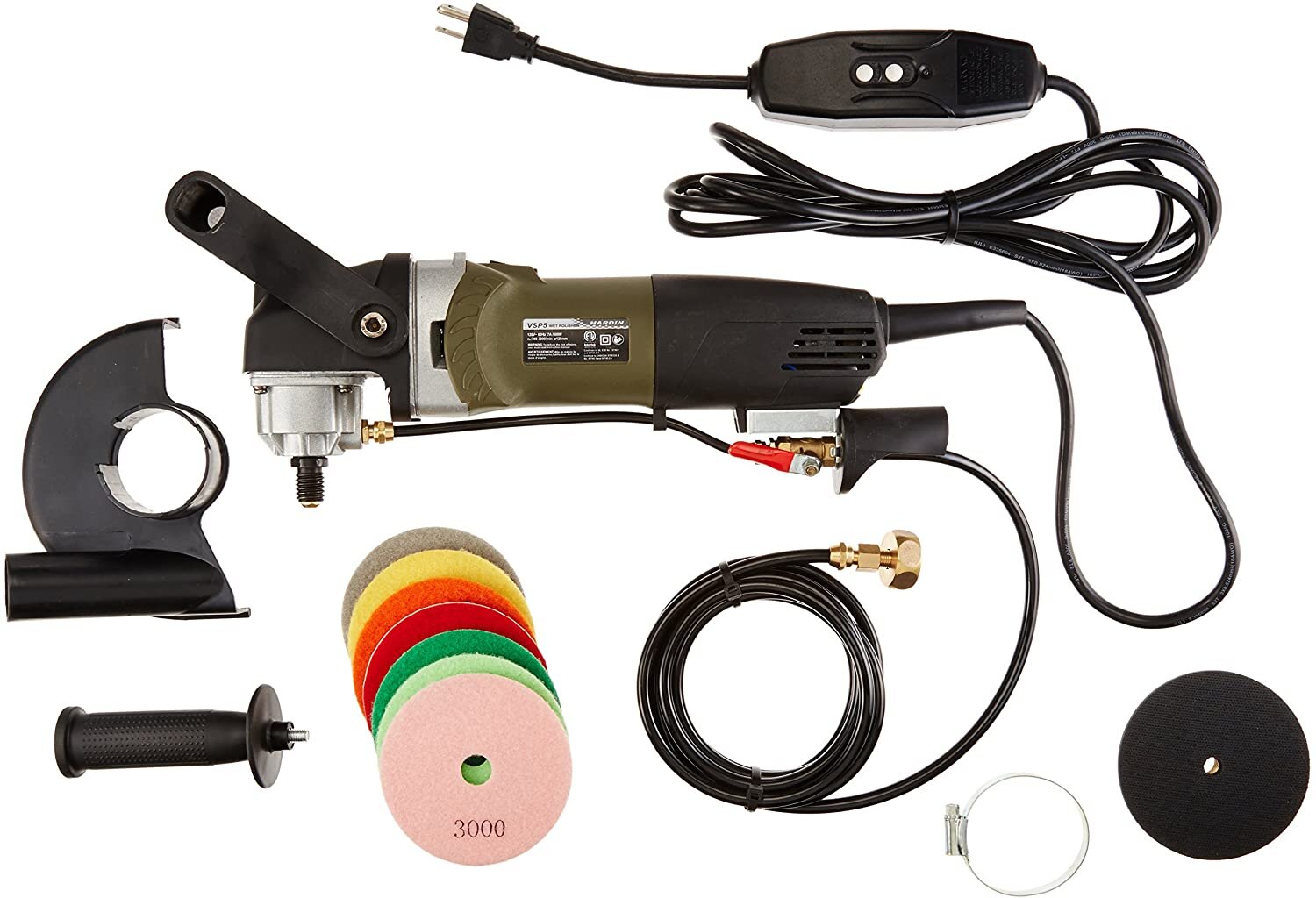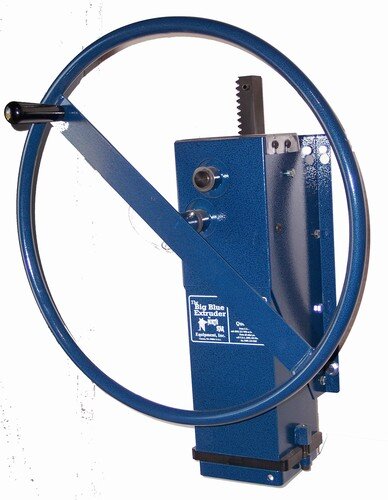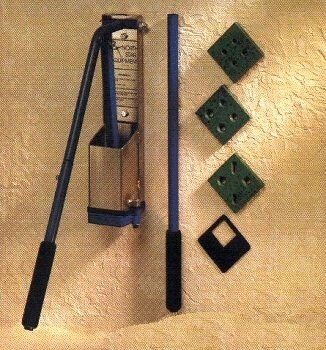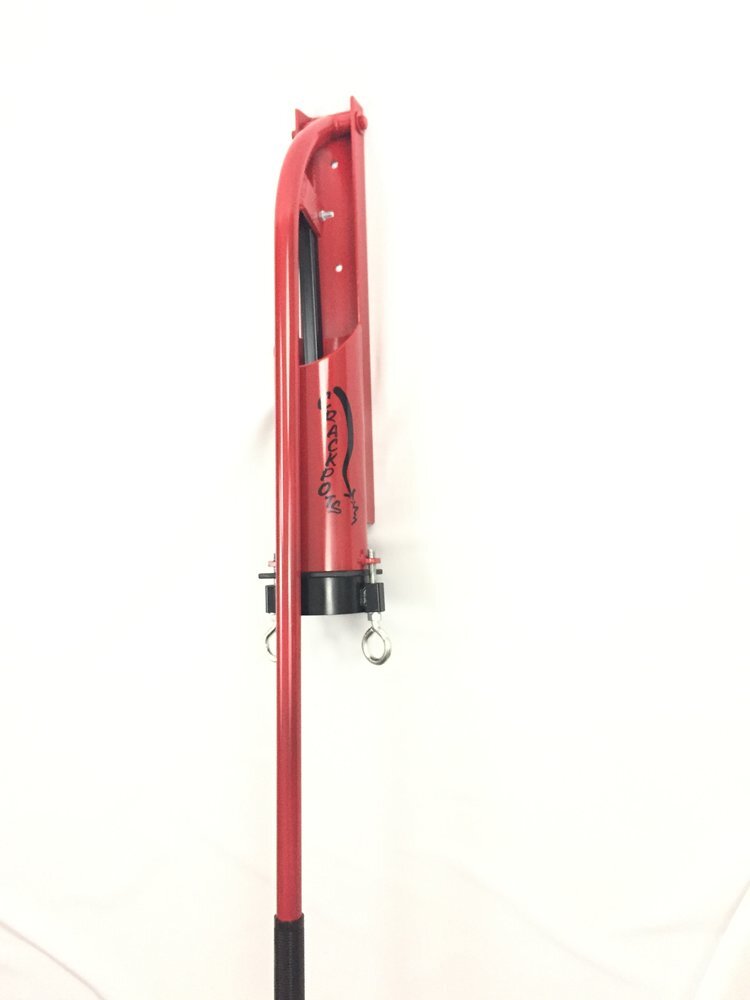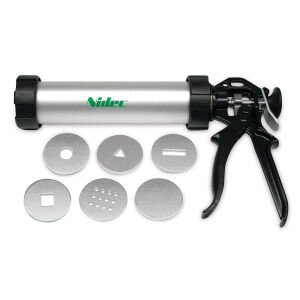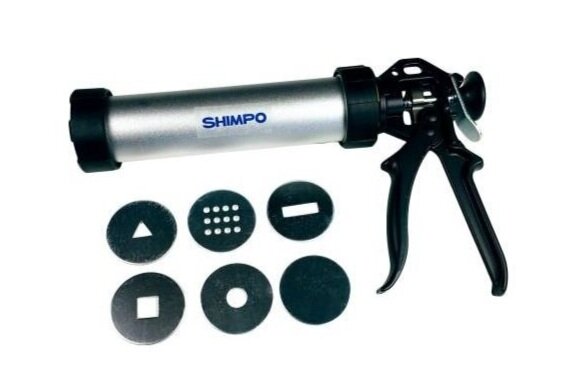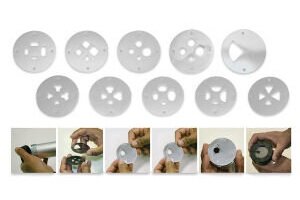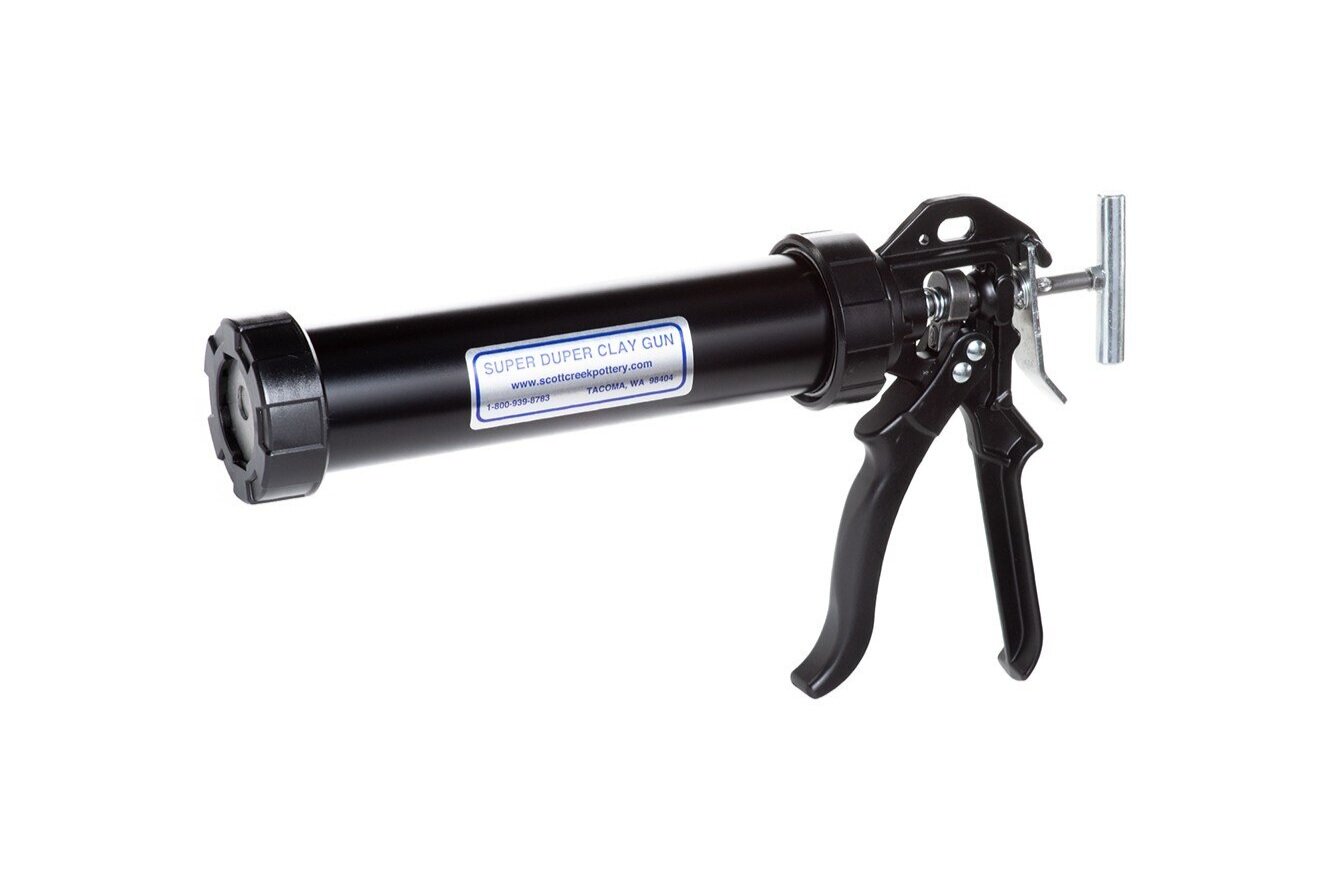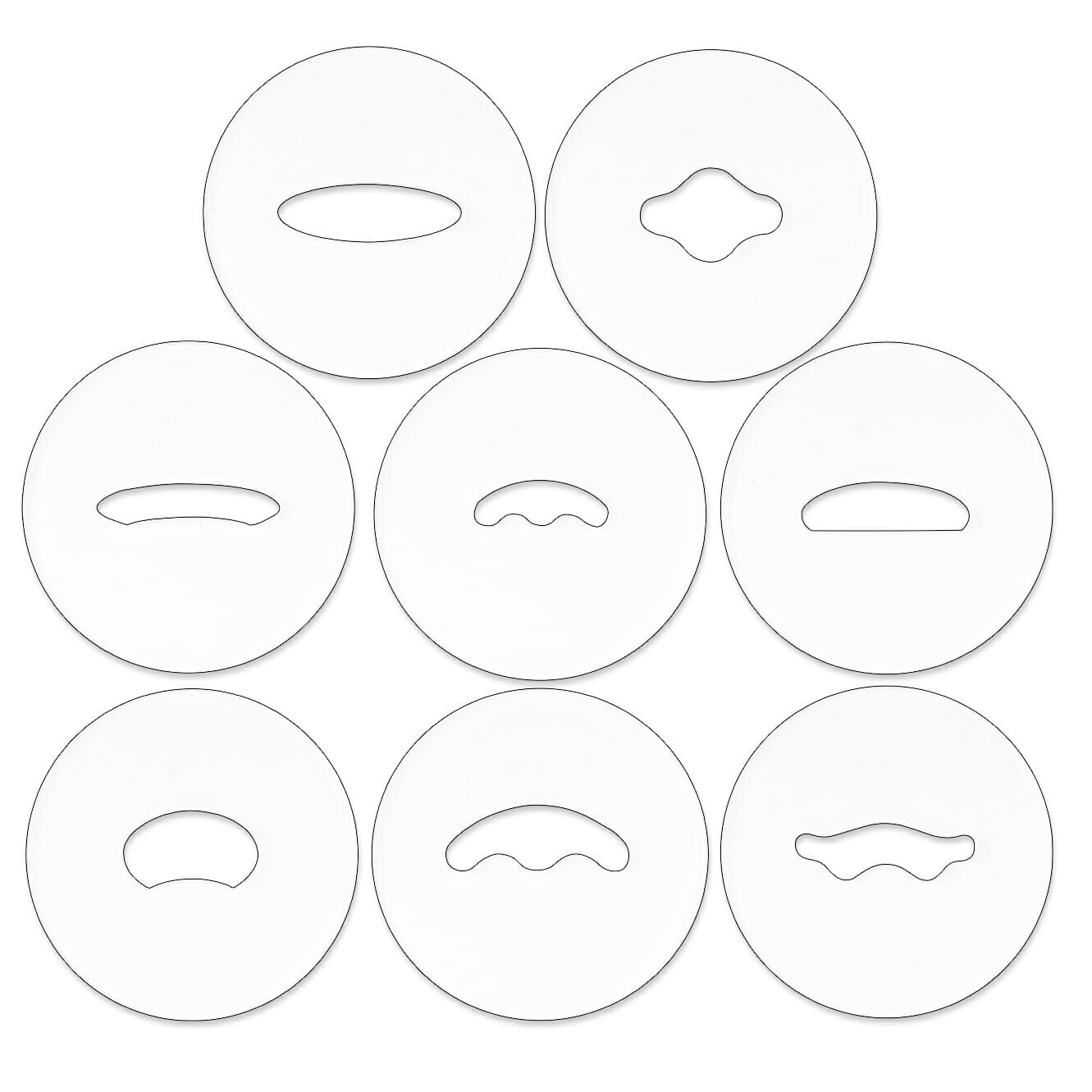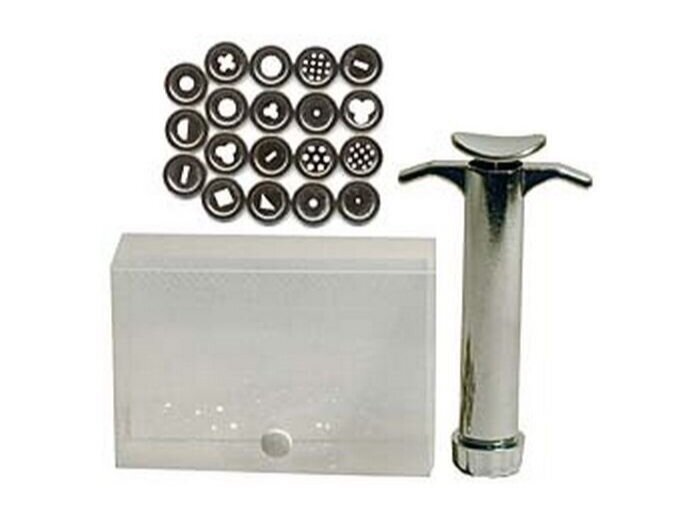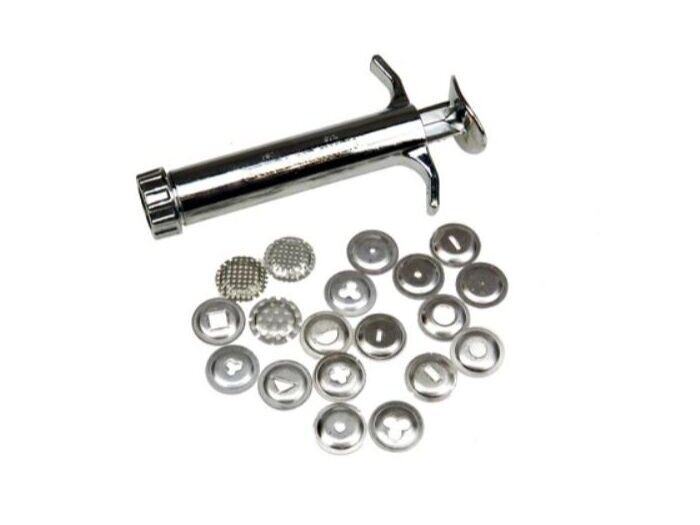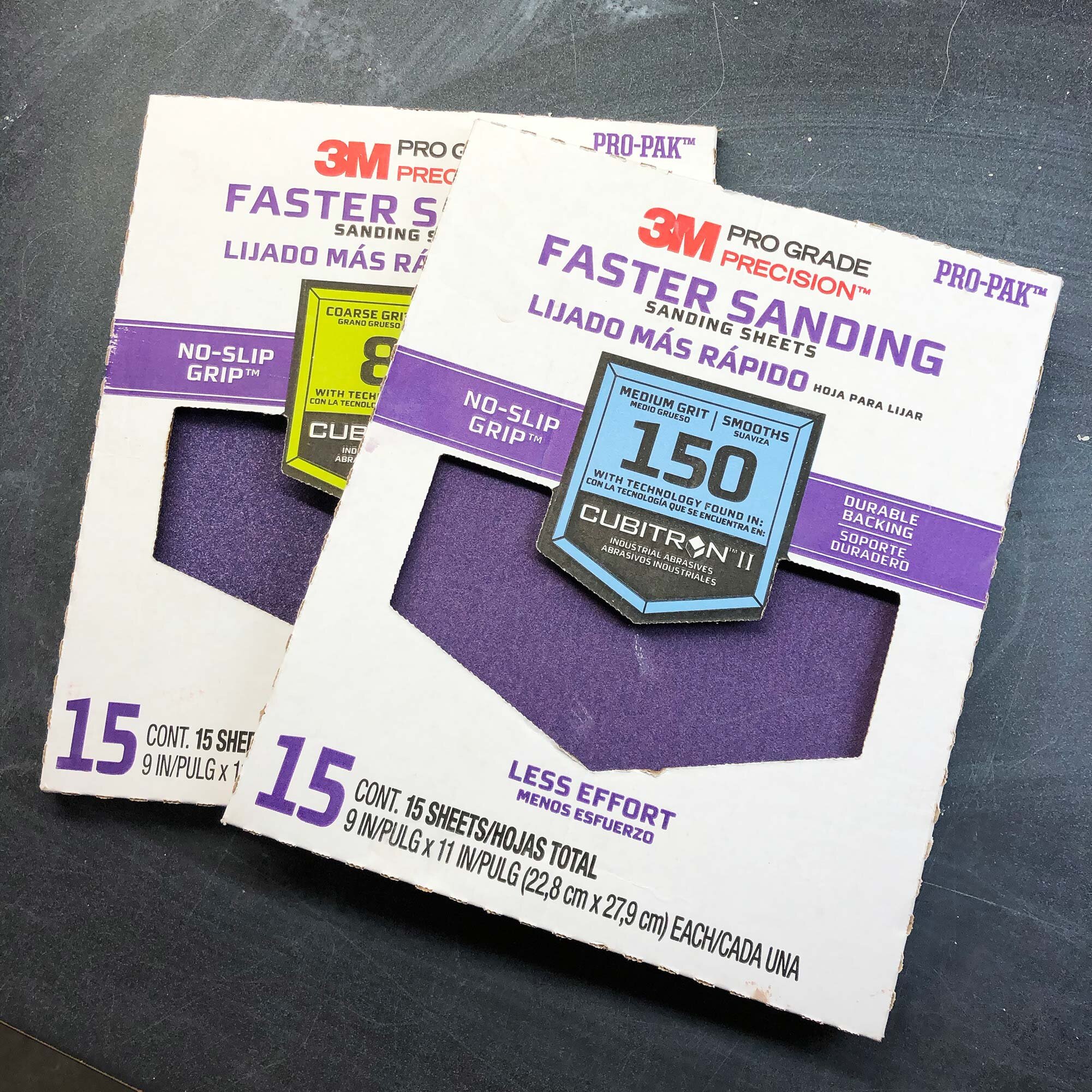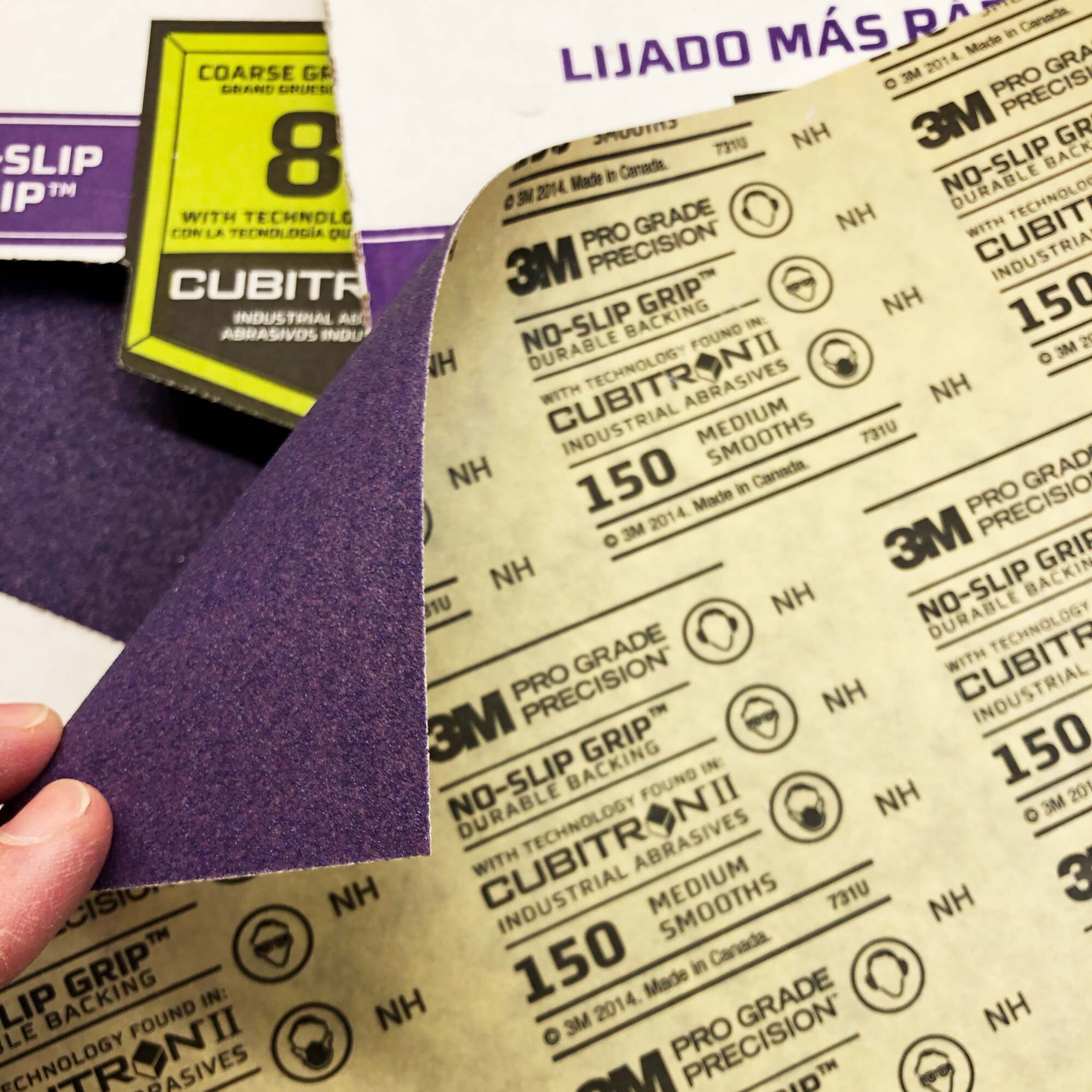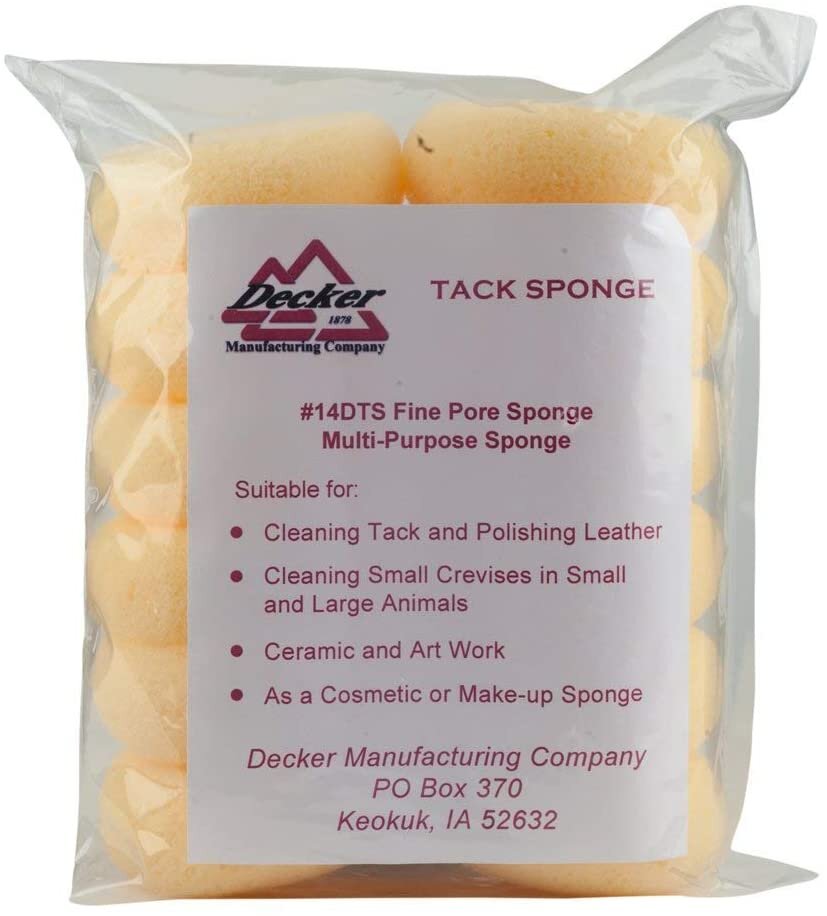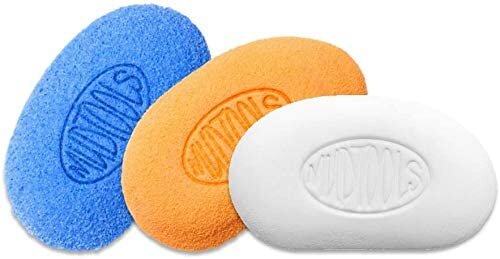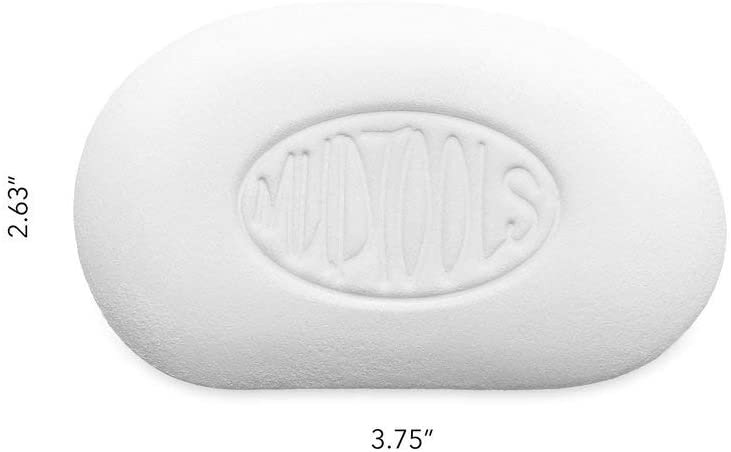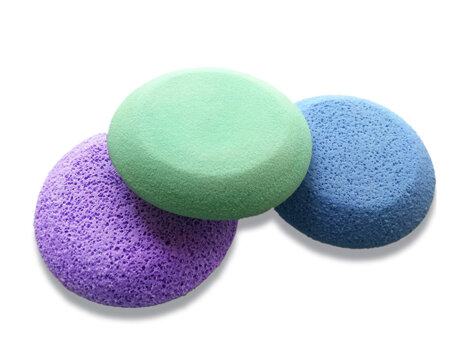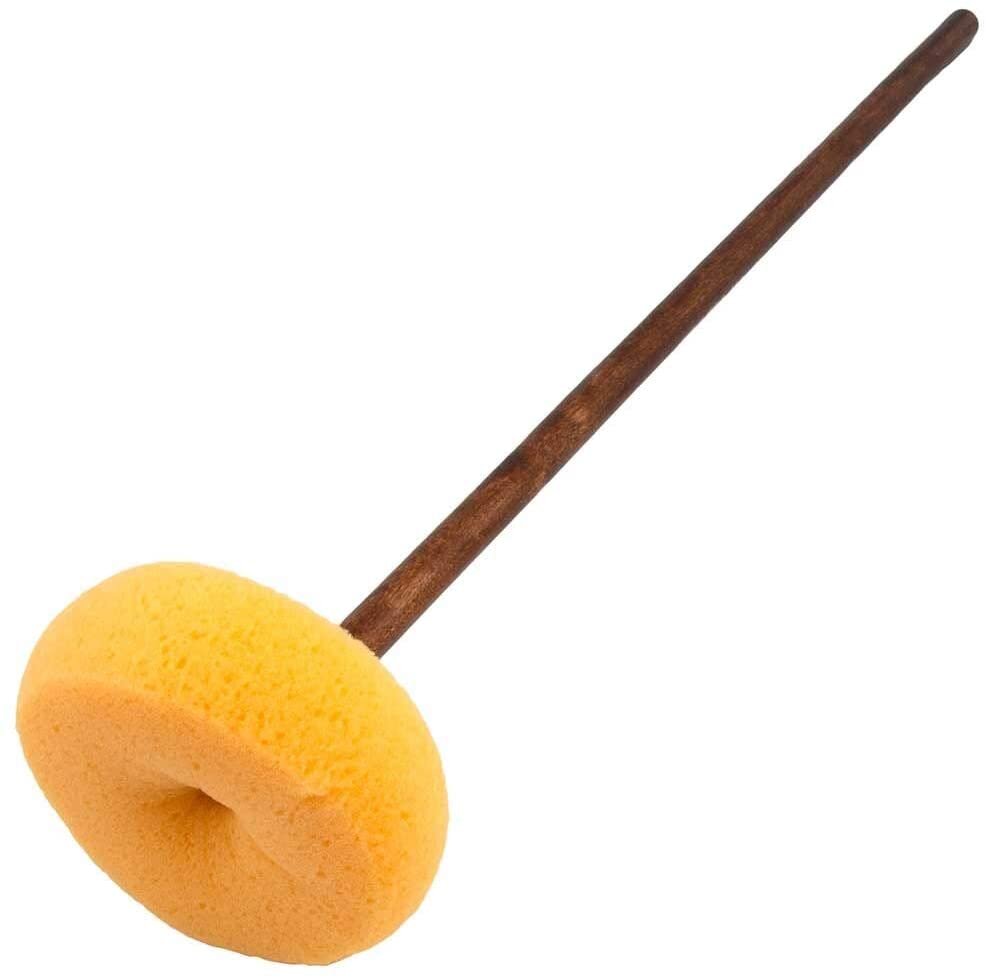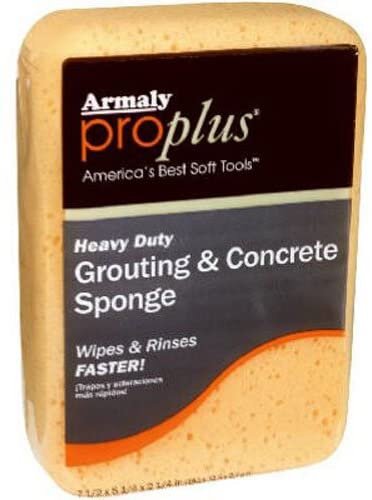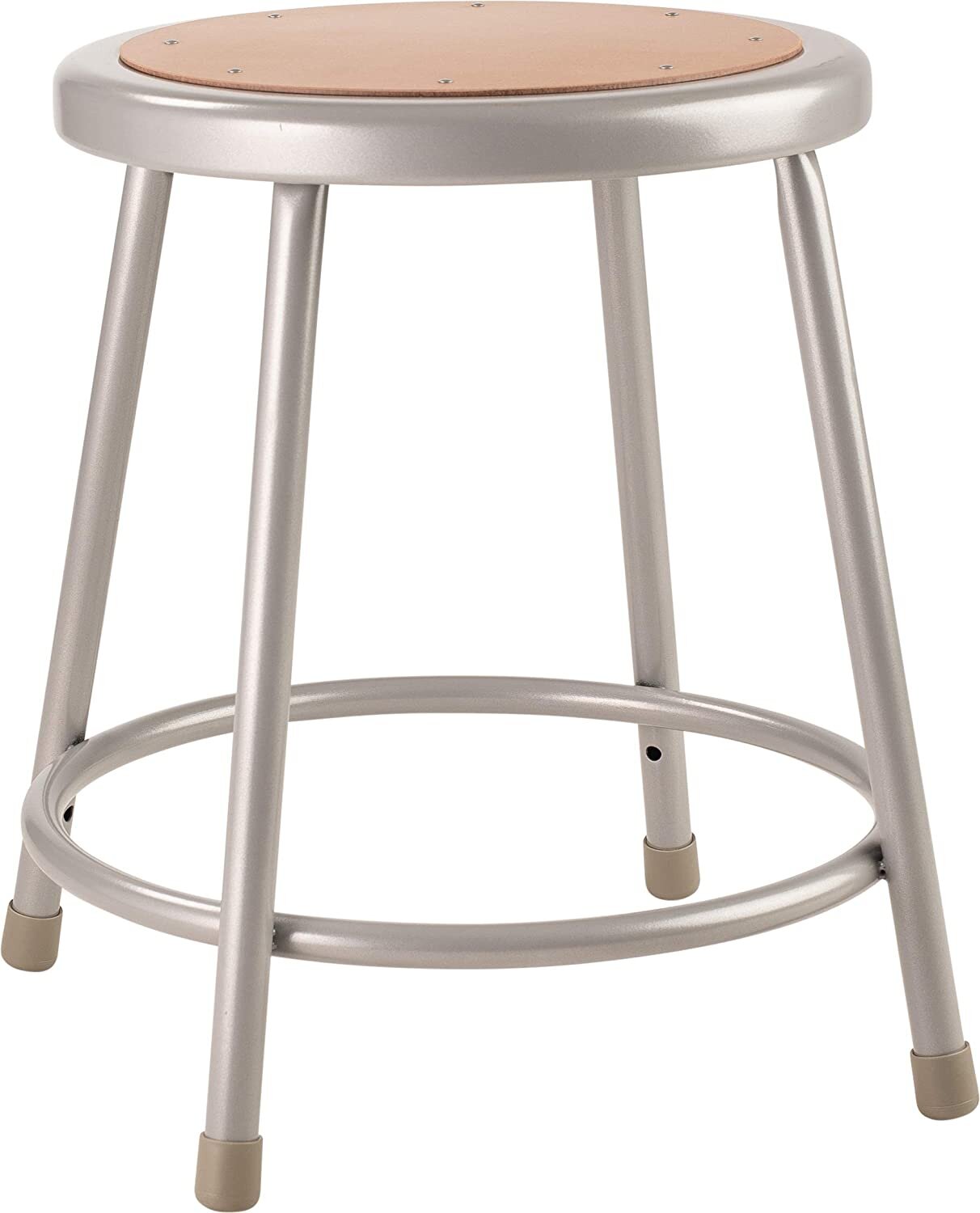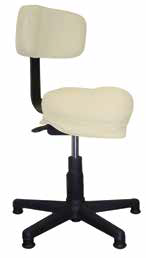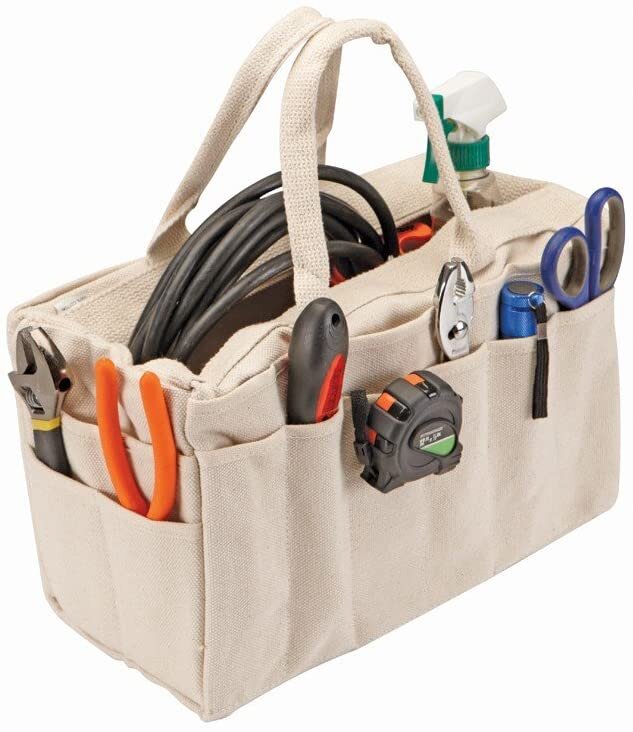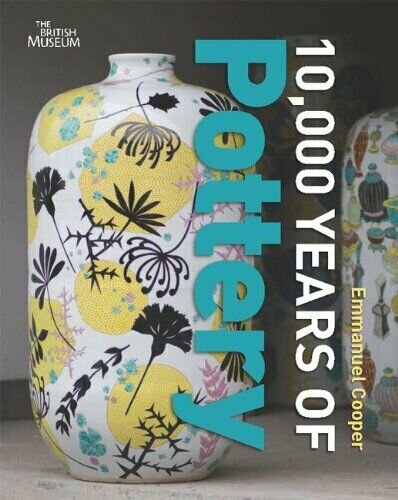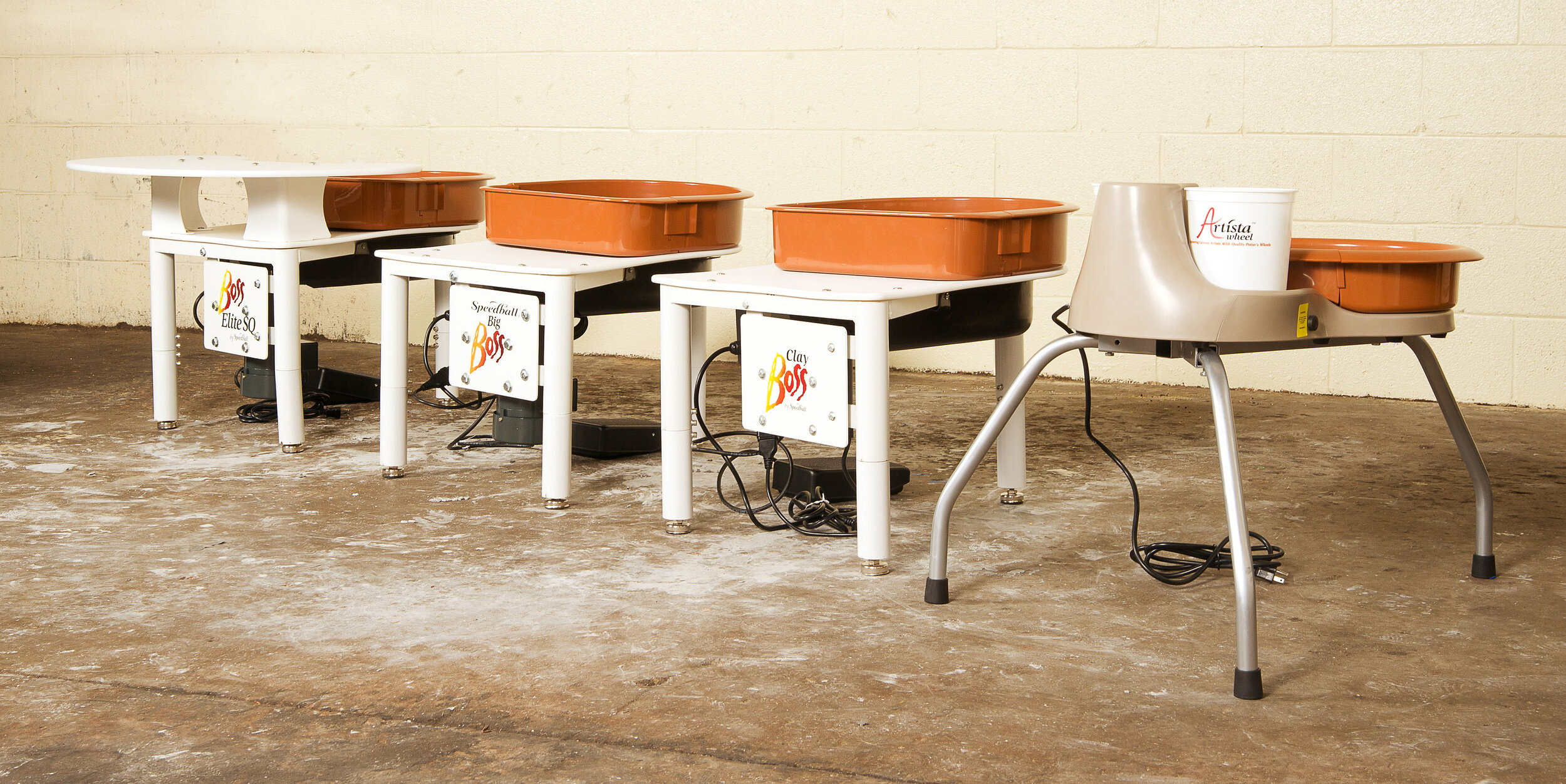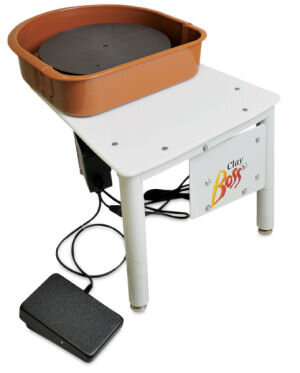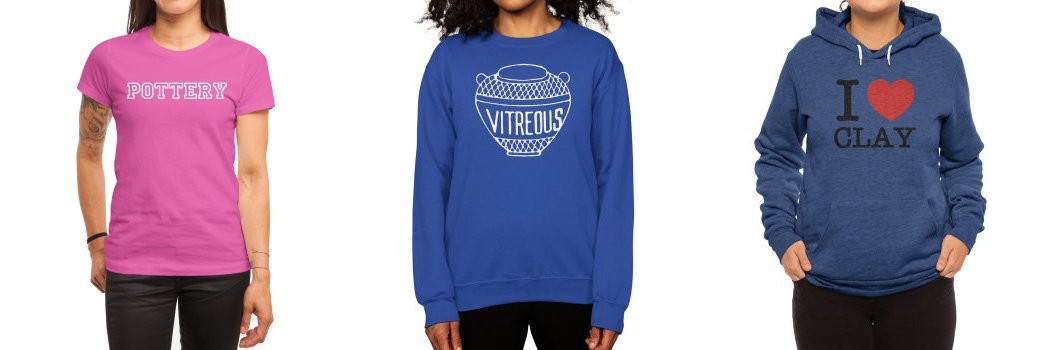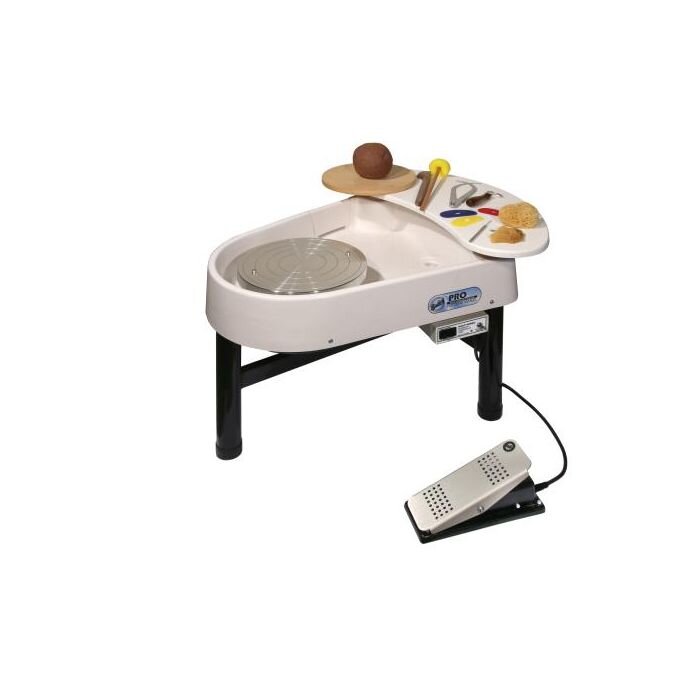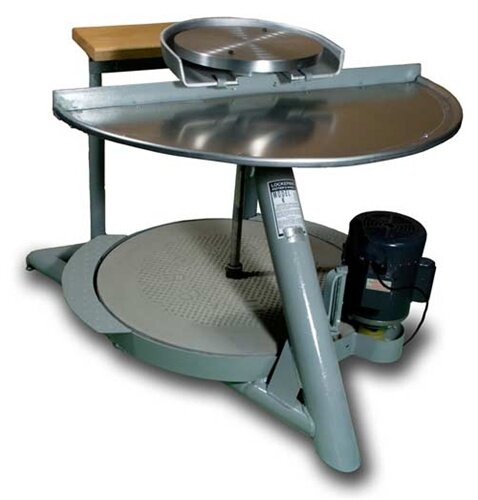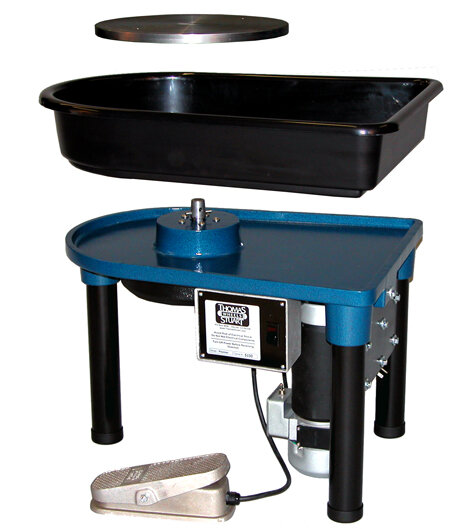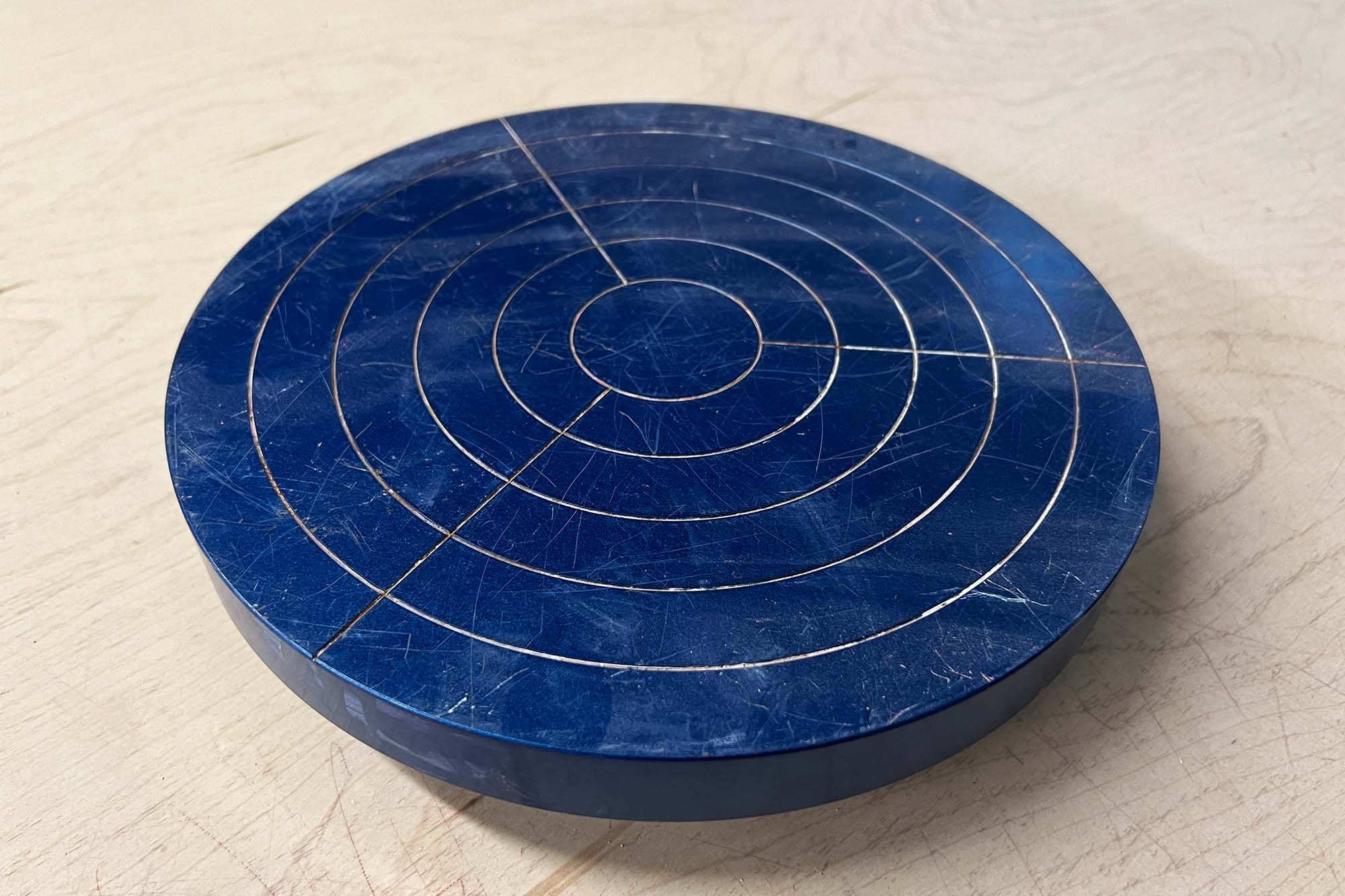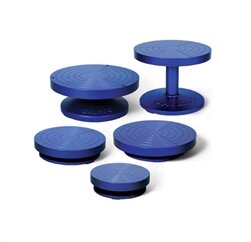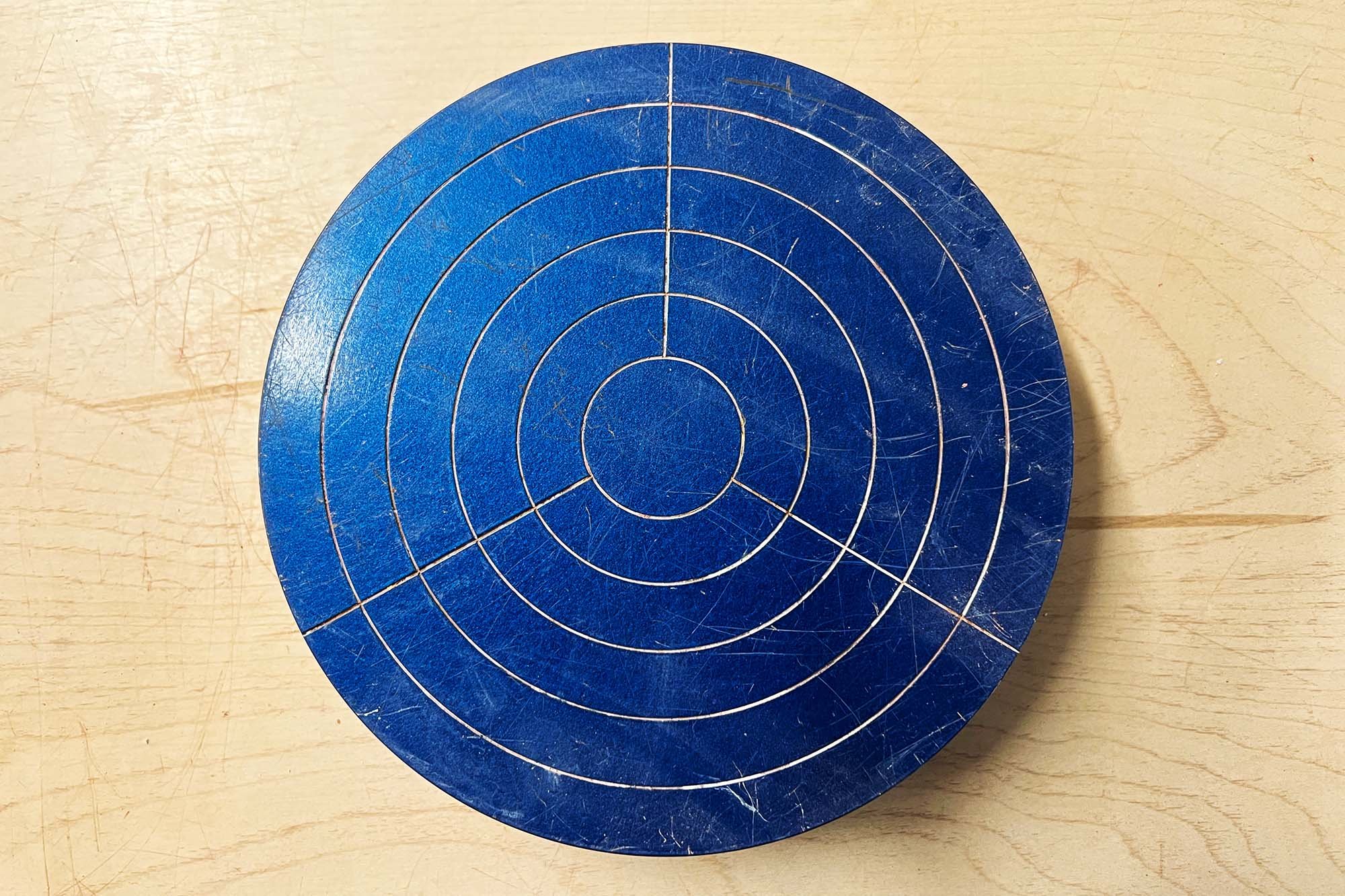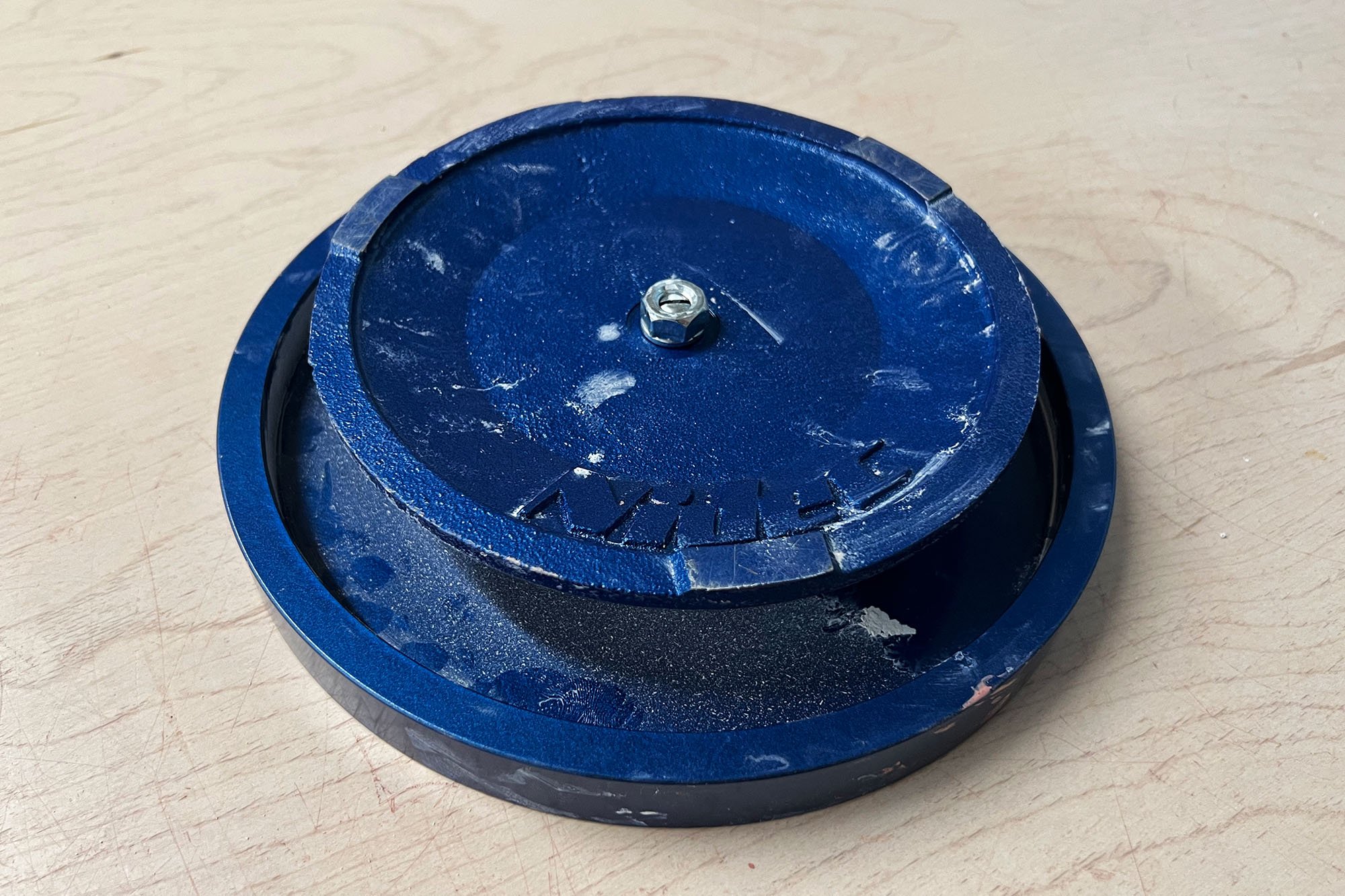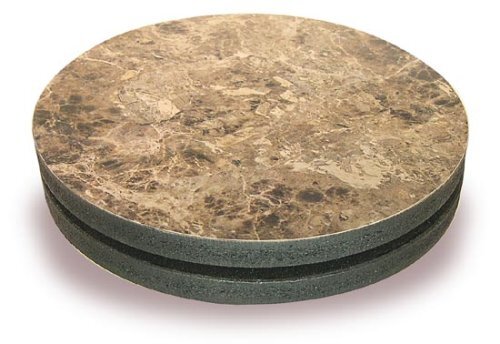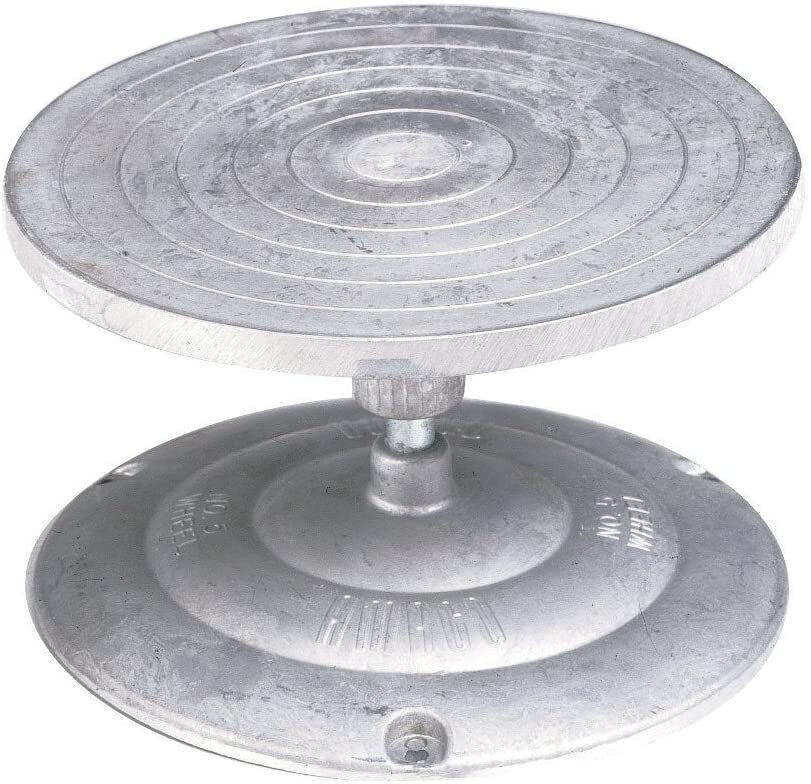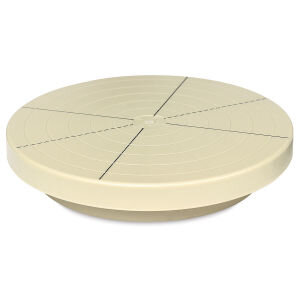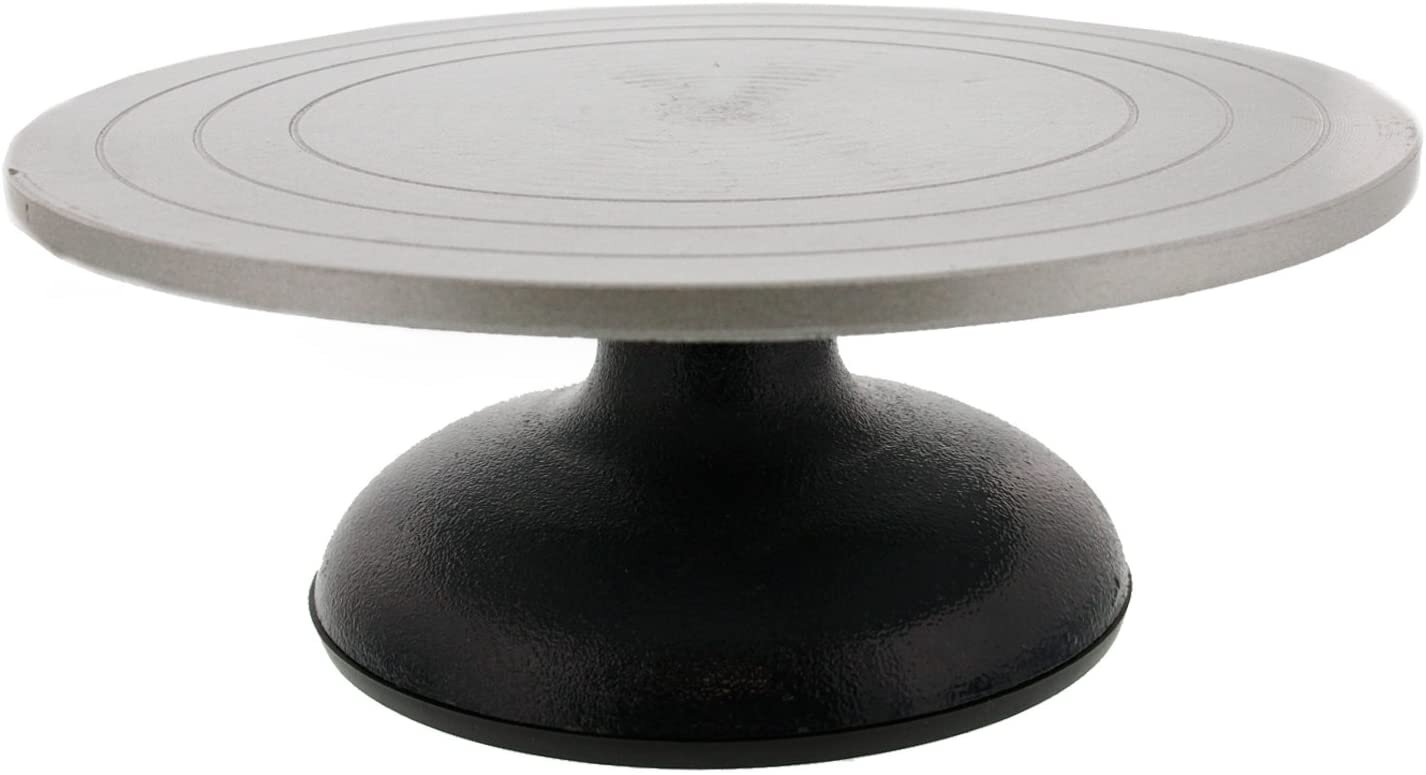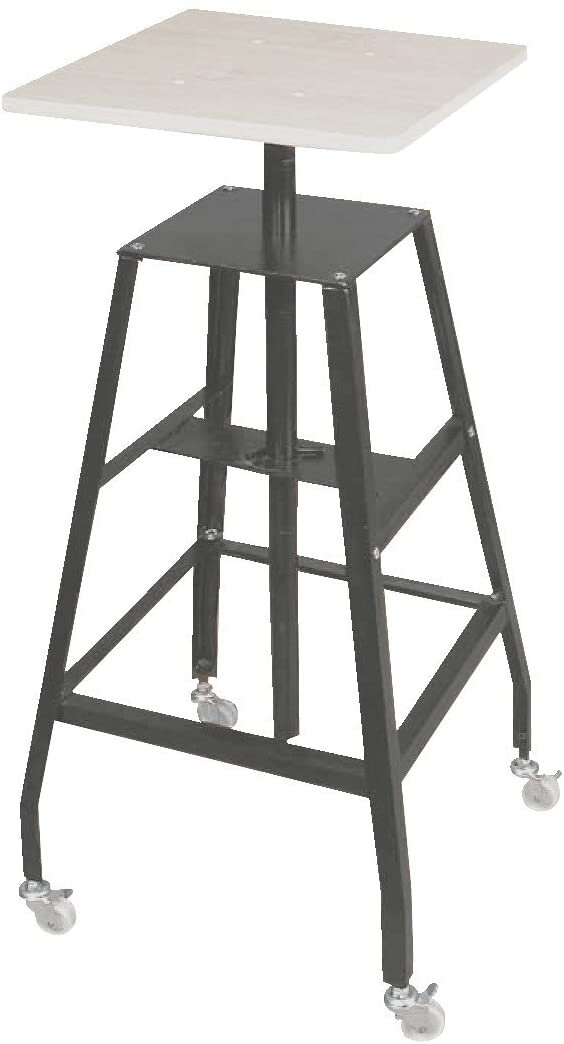The Shimpo VL Whisper, a top pick for a full sized potters wheel.
This gift guide has more than 30 ideas of gifts for potters, ceramic artists, or anyone who works with clay. Most of these suggestions are priced between $5 and $100, along with a few higher-priced items like pottery wheels and slab rollers.
When shopping, keep in mind that most potters probably already have a basic tool kit and a few others tools. But if someone is just starting, we’ve also got a handy guide to the best tools for pottery beginners, and there are many other posts on this site with reviews of tools and books we love.
Note: This site uses affiliate links for sites such as Amazon and Blick. If you click the links and complete a purchase, we may receive a percentage at no extra cost to you.
Xiem Studio Tools BatMate
The Xiem Studio Tools BatMate.
The BatMate from Xiem Studio Tools is a 12 or 14 inch diameter piece of synthetic fabric that can be placed in between a bat and wheel head to virtually eliminate any wobble, improving the accuracy of throwing and trimming. Many potters, however, wet the fabric and place it directly on a wheel head to use when trimming pots. At around $15, this is a tool that gets used all the time once it’s in a potter’s kit.
The Claypron
The Claypron is a split-leg apron designed specifically for working with clay at the potter’s wheel. It’s available in a variety of colors, is made with high-quality, washable cotton, and is one of the most popular aprons in ceramic studios. It has ties at the neck and waist, and generally retails for around $35.
Weleda Skin Food
Weleda Skin Food is a luxurious, extra-thick cream.
Pottery and clay can be hard on hands and any potter will appreciate the gift of nice lotion. A favorite everyday cream is O’Keeffe’s Working Hands Cream (shop at Amazon), but a real upgrade is Weleda Skin Food. It’s a rich, luxurious cream that will help protect hands during a long studio session or at home. This extra thick cream smells great, melds into your skin quickly, and the squeeze tube makes it easy to use at home or studio. It usually costs around $17–19 for a 2.5 oz tube.
Potter’s Skin Butter
Potter’s Skin Butter from Cara Mae Skincare is deep hydration for hardworking hands. Made by a potter for potters, this is a great gift. Available in Tangerine, Lavender, Mint and Unscented in a variety of sizes.
Cara Mae Skincare has other lotions as well, all equally great.
10,000 Years of Pottery by Emmanuel Cooper
The 4th edition of 10,000 Years of Pottery
This lavishly illustrated book is a great addition to any potter’s bookshelf and will provide years of inspiration. It’s 360 pages long and there are full-color pictures on almost every page. Tracing the history of ceramics from the Ancient Near East through contemporary times, the book covers all parts of the globe along with the arts and crafts movement, ceramics and industry, studio ceramics, and more. Originally published in 1972, the book has been updated continuously since. The most recent 4th edition is available as a paperback for $40.
Speedball Artista Tabletop Wheel
The Speedball Artista Wheel (top) pictured here with Speedball bats.
The Speedball Artista is a great tabletop wheel that is strong enough for most potters but is also portable and can be stored with ease. It’s the perfect option for an at-home practice wheel or for someone looking to try out pottery with a professional machine. It has an 11” wheelhead, a 1/3 horsepower motor, is compatible with standard 10” bats, and weighs just 26 pounds. It’s usually available for $450-$500. For a complete overview, check out our guide to tabletop wheels.
Diamond Hand Polishing Block
The Stadea diamond hand polishing foam blocks.
Diamond hand pads are the perfect way to sand away burrs, small glaze drips, and rough patches on pots, sculptures, or kiln shelves and posts. Made of industrial-grade diamonds embedded in plastic, these are available from a variety of manufacturers such as Stadea as either soft, flexible pads or semi-hard foam blocks. The foam blocks are my favorite because they provide structure and support your hand, but the flexible pads are useful for sanding more complicated shapes. Available as sets or individual pads, it’s recommended to get four individual pads in the range of 50 grit, 100 grit, 200 grit, and 400 grit.
Shimpo Banding Wheels
Shimpo Banding Wheels are available in a variety of sizes.
Banding wheels are very useful for coil building, sculpting, and decorating. Nidec-Shimpo Banding Wheels are the best on the market, made of cast iron with sealed bearings. They are on the heavy side, but this added weight gives the wheels a smooth, even spin. Shimpo banding wheels come in five different sizes ranging from $60 to about $120. For more info, read our complete review of banding wheels, but of the options on the market, there is no doubt that these are the best.
Nidec-Shimpo Handheld Extruder
The Nidec-Shimpo Handheld Extruder comes with 5 basic dies and a blank.
A handheld extruder is one of the best ways to make handles or other shapes in a quick, efficient way. Basically a specialized version of a caulking gun, soft clay is inserted in the 2” wide barrel, a die is placed at the end, the cap screwed on, and you can pull the trigger and the plunger begins pushing clay through the die. You can also use hollow dies to make small forms that would be almost impossible to make by hand.
There are a variety of handheld extruders, which are all about the same, but the Nidec-Shimpo Handheld Extruder is compact and well built. The key is getting dies that work for. In addition to the basic dies, my favorite add on is the Scott Creek Handle Die kit, which should match up with any small handheld extruder. The Shimpo Handheld Extruder is usually around $60 and extra die kits generally cost around $40.
MudTools Essentials Kit
The MudTools Essentials Kit.
MudTools makes innovative tools such as their beloved flexible plastic ribs, and this MudTools Essential Starter Kit includes nine of their most popular tools. A great gift for beginners, experienced potters will also appreciate this kit. Included are three flexible polymer ribs, the Mudshark cutting tool, a cut-off wire with polymer handles, a long plastic scraper/rib, a sponge, the MudTools all-in-one trimming tool, and the MudTools shredder. The kit typically costs around $70.
Note: Some marketing describes this as a 10-piece kit, but I wouldn’t classify the plastic box/holder as a “tool.”
Speedball Underglaze Sample Pack
The Speedball Underglaze Sampler includes 12 colors in 2oz bottles.
Speedball Underglazes are studio favorites and are great way to get vibrant, saturated colors on ceramics. They can be applied by brush, sponge, or spraying. Use alone for a matte finish, or in combination with a clear glaze for a glossy finish. Sample packs are a great way to find the underglaze colors that work best, and are available from Speedball and a variety of manufacturers. The Speedball sampler pack includes 12 colors in 2 oz bottles, and typically costs around $42.
There are a lot more underglaze options. Here are a few that are recommended:
AMACO Velvet Underglazes are available in 4 different sampler sets of 2 oz jars for $52 each. Shop at Blick
Mayco has a 10 pack underglaze sampler for around $40. Shop at Amazon
Sax True Flow Underglaze has a 12 pack sampler set for around $43. Shop at Amazon
Bluetooth Speaker
The JBL Flip 4 is our pick for an entry-level bluetooth speaker.
It’s always great to have tunes in the studio, and a portable bluetooth speaker makes it easy to play anything from your phone, tablet, or laptop. The JBL Flip 4 is slightly older (meaning it’s available at a discount) but is still a great option that sounds great, is easy to pair with devices, and comes with long-lasting build quality. For something bigger and louder, check out the JBL Charge line of speakers. The JBL Flip 4 is waterproof, available in a variety of colors, and usually retails for around $90.
Mastering Ceramics book series
The Mastering Ceramics books are great for beginners and intermediate pottery students. The thorough, straightforward advice covers a variety of techniques in an easy to approach style. All three books are a great addition to any potter’s bookshelf.
The books include
Mastering the Potters Wheel by Ben Carter, published 2016
Shop at Amazon | Shop at Blick | Shop at Bookshop.org
Mastering Hand Building by Sunshine Cobb, published 2018
Mastering Kilns and Firing by Lindsay Oesterritter, published 2019
Tote Bag for Tools
This nylon tote bag is great for ceramics, pottery, art, and craft tools.
Potters and ceramic artists usually have a variety of tools and an open-top bag is the best way to store them. It allows tools to dry out without rusting, and provides easy access to grab what you need. The JJRing nylon art/craft bag is has a variety of pockets, is available in eight colors, and is a great value, typically priced at $15 to $25.
Revco Green Split Leg Apron
The Revco split-leg apron
This green split-leg apron is popular with many potters and has a few features that make it a nice upgrade from a standard kitchen apron. Made from cotton, it has an adjustable, clip-on neck strap and it also has clips to attach the split legs to either leg. Some may prefer a longer apron (such as the Claypron) but this apron covers the thighs and the split-leg design makes it perfect for sitting at the pottery wheel. Usually available for $20 to $25, the Revco green apron is available in 36”, 42”, and 48” lengths. The 36” will work for most, or pick 42” for someone around 6’ tall.
For our complete guide to aprons, click here.
Xiem Studio Tools Precision Applicator
The 3 oz Precision Applicator from Xiem Studio Tools.
A great decorating tool is the Xiem precision applicator, available in 1 and 3 oz sizes. These applicators have a soft, flexible rubber bulb with a variety of screw-on metal tips. Mostly used for slip trailing and slip-decoration techniques, these bulbs can be used to apply just about any type of thicker, viscous liquid. The larger 3 oz size will be the best option for most. There are cheaper slip-trailing options that are a plastic bottle with similar metal tips, but the rubber bulb in the Xiem applicator provides steady, even pressure that is just easier to use. For around $22, this is a quality tool.
Magna Cart
The Magna Cart.
If you work with clay, you need to move heavy stuff all the time. Whether it is boxes of clay, packaged ware for shipping, or large sculptures, the Magna Cart is an invaluable tool that folds up for efficient storage when not in use. Store it in a closet or the trunk of a car, it’s a handy tool that will get used all the time. The cart can hold 150 lbs (I’ve pushed it to 200 and that can be too much), has 5” rubber wheels, a 15” wide base and the handle can extend to 39” tall. There are a lot of folding carts on the market now in all shapes and sizes, but the classic Magna Cart is still the best option.
Azul Board Game
Azul, a tile-based strategy game for 2-4 players.
This tile-based strategy game is fun for the whole family, but may be particularly enjoyed by fans of Portuguese ceramic tiles or azulejos. To play Azul, tiles are selected and arranged on the game board to score points. Once a player completes a horizontal row of tiles (typically after multiple rounds or 20–40 minutes of play) points are scored and a winner crowned. It’s an award-winning game that was first released in 2017. Recommended for ages 8 and up.
An example of Azul game play.
Milwaukee M12 Cordless Drill
The Milwaukee M12 3/8” cordless drill kit.
The Milwaukee M12 compact cordless drill is a studio favorite. It’s strong enough for most jobs, but small and light so that it’s comfortable for just about anyone. Paired with the right mixer blade, this is an ideal drill for mixing glazes, plaster, or other tasks in a ceramics studio. Quality tools are always appreciated in the studio, and a cordless drill like this just gets the job done. Milwaukee also makes a wide variety of tools that fit the M12 battery. This kit typically retails for $99.
Click here to read more on cordless drills.
Recommended drill accessories for ceramics:
Jiffy LM Laboratory mixer for mixing small glaze cups.
Plastic helix mixer for mixing 1-2 gallon glaze buckets.
Jiffy ES Mixer for mixing 2 to 5 gallon bucket.
Dewalt 14 piece bit set for drilling holes and the Dewalt 45 piece screwdriver set.
Carve Your Clay by Hilda Carr
Carve Your Clay by Hilda Carr
This recently-published book gives a lot of ideas for surface decoration including carving, inlay, scraffito, wire cutting and more. With easy-to-follow instructions and great illustrations, it’s an inspirational book. Based on Hilda Carr’s signature style but with variations and ideas for every potter, the book is available in hardcover or paperback.
Giffin Grip Trimming Tool
The Giffin Grip in use. The tool comes with arms of various sizes.
The Giffin Grip is a trimming tool that can really upgrade a studio. It attaches to any sized pottery wheelhead, and various arms allow you to easily grip vases, tall pots, or any pot really. It sure beats trying to attach pots using small bits of a clay. It’s not cheap—typically around $250—but it lasts for ever and once a potter has one, they’ll use it all the time.
Wooden Rollers and Stamps
Set of 5 wooden texture rollers
These sets of wooden rollers and stamps allow potters to quickly and easily add relief textures and patterns to slabs, pots, or any piece of clay. The wood is long-lasting, durable, easy to clean, and can really add that extra-special touch to elevate handmade work.
The set of 5 wooden texture rollers is available from a few different sellers and typically retails for around $30.
Set of 16 stamps with a storage box.
The set of 16 stamps typically retails for around $20-$23.
Shimpo VL-Whisper Pottery Wheel
The full-sized Shimpo VL-Whisper pottery wheel is a top pick and one of the most popular wheel models on the market. Made by Nidec-Shimpo, it features an innovative magnet-driven wheelhead that is virtually silent. It also has a 14 inch wheel head, can center just about any amount of clay, and has adjustable legs. You can even remove the legs and have the wheel sit flat, converting it to a tabletop or standup wheel if desired. All around, it’s our favorite wheel and top pick in our pottery wheel buyer’s guide.
The VL-Whisper is reversible, has a detached foot pedal, and a removable splash pan. It typically retails for around $1,500 plus shipping.
Small Tools
These small tools are all great additions to any potter’s tool kit. Get one or all to make a great gift.
Kemper Clay Drill
The Kemper Clay Drill
The Kemper Clay Drill is the best way to drill holes for spouts or drain holes in planters, or just to make circular holes in any piece of clay. It makes a variety of sizes, simply keep twisting and work the tool deeper for a wider hole. It’s easy to use, easy to clean, and replaces all the other drill tools in one easy piece.
Mini Ribbon Tool Set
The Mini Ribbon Tool Set
This set of 6 tools is great for detail work, decorating, and finishing a piece of pottery or a sculpture. At 5 1/2” each, the metal tools don’t take up much room but they can do a lot, especially for detail work or scraffito. For around $13, it’s a great addition to a potter’s tool kit.
Neiko Diamond Bits
Neiko diamond hole drilling bits.
Diamond bits allow you to drill through fired and glazed ceramic, and this small set from Neiko is a great introductory set. Pair it with any drill, and you are set. Just be sure to use it with plenty of water so the bits do not overheat. Ranging from 5/32” to 1/2”, the Neiko bits are a good size for tasks such as drilling cord holes in ceramic lamps or adding drainage holes for planters. At $10 or less, the Neiko bits are a cost-effective addition to any ceramic studio.
Metal Rib Set
A variety of ribs can help a pottery easily achieve different shapes on the wheel or handbuilding. This cost-effective, affordable set of 10 ribs includes a wide variety of shapes as well as two serrated ribs that are useful for creating texture or joining clay together.
Fettling Knife
The Kemper Fettling Knife.
A good quality clay knife is so useful in the studio. The best option is the Kemper F97 Hard Fettling Knife. The blade is not “hard” but is just the right stiffness for cutting or turning the knife at an angle to use for smoothing or other detail work. The F96 Soft Fettling Knife has a more flexible blade that is not as useful or durable in the studio. Both Kemper knives are way better than the various generics as it the blade is attached to the handle with high quality glue. Generic fettling knives often fall apart with even the most basic use.
Anker Soundcore Q20 Noise Cancelling Headphones
Over-ear noise cancelling headphones can really help you focus on your work, especially if you work in a shared studio environment. There are a lot of options for this type of headphone, but the Anker Soundcore Q20 strike a balance between quality and affordability, especially considering they will probably get covered in clay at some point. These headphones have an impressive 40 hour playing time, and a dynamic sound quality that while not quite audiophile level, really deliver a lot for the $50 price tag.
3M Respirator
A quality dust mask is a must have for anyone who mixes glazes from scratch, makes their own clay, or works with plaster. The best option is a 3M respirator. A basic model is about $15 plus the filters, but for a few dollars more you can get the “rugged comfort” mask which has a more comfortable liner and a few extra features. Pair it with P100 filters or P100 cartridges, and you’ve got high quality protection against silica and other airborne particulates.
Zebrawood Carving Tool
The P1 Zebrawood Carver from Diamond Core Tools.
The Zebrawood Carvers from Diamond Core Tools are functional, long-lasting (replaceable blades!), and beautiful. At 5.5 inches long, they feel like a pencil and can be used for sharp, even cutting tasks such as scraffitto and other forms of decoration. Diamond Core makes these with a wide variety of cutting blades—the P1 is a great carver to start with. At $37 each, these are on the expensive side for a ceramic tool but the adjustable blade and beautiful wood makes this a great gift.
The Ceramics Reader
This book brings together texts, extracts, and other pieces of writing on the field of ceramics. Covering past and present, it’s recommended for serious hobbyists, ceramic students, professionals, or anyone that wants to read more about this amazing medium. At 616 pages long, there’s something in there for everyone. Don’t read it front to back—just flip it open and find what interests you.
Available in hardcover or paperback for around $50.
Shimpo Pottery Stool
The Shimpo Potter’s Stool
The Shimpo Potter’s Stool is the most versatile, comfortable, and functional pottery stool on the market. It has four adjustable legs with nine adjustable slots on each leg, with a range of 19 to 26 inches high. The legs can be adjusted independently, allowing for the stool to be set at an angle if desired. It also has a comfortable, padded seat. It’s a great upgrade for any potter.
The Shimpo Potter’s Stool measures 16 x 16 inches and ranges up to 26 inches tall. It generally costs around $90.
Solid Maple Rolling Pin
The 24” wide solid maple rolling pin.
This solid maple rolling pin is 24” wide and 3” in diameter with handles. Pair it with a few wooden shims or rulers, and you’ve got a quick adjustable height slab roller that will make wonderful slabs. And best of all, there are no bearings, gears, or internal parts that will break down. And since it is solid, it’s easy to just wipe down and clean with a sponge. At $30, it’s a great value and is a studio tool that will last forever.
Slab Mats
Slab Mats are great working surfaces for clay.
Slab Mats are great working surfaces for handbuilding, can be cut up and used underneath wheelthrown pots, and are also a canvas alternative for use with slab rollers. Slab mats are a plastic kind of fabric, with one smooth side and one side that is slightly fuzzy and ideal for working with clay. You can cut with clay knives on them and not worry about damaging your table top surfaces. They are easy to clean, just wipe down with a sponge, and seem to generate much less dust than canvas. They are available in a variety of sizes but the larger 22 x 50” size really allows you to spread out.
North Star Portaroller
The North Star Portaroller.
The North Star Portaroller is an amazing machine that can instantly upgrade any studio. Designed for artists who are on the go, it’s also ideal for home studios because it quickly breaks down into three pieces that can be stored when not in use. The Portaroller has two metal rollers, a crank, and two table top pieces that fit on either side of the roller. The top roller can be adjusted for slab thicknesses up to 2.5 inches. The roller can make slabs that are 16 inches wide. It’s a well thought out piece of equipment that is backed by North Star’s impeccable record of quality. It typically retails for around $600.
Other Gift Ideas
Pottery Wheels
Thinking of getting a new wheel as a gift? Check out our guide to table top wheels here, and our guide to full-size wheels here.
Or maybe you were thinking of a kiln? Read our guide to Skutt kilns here.
We’ve got a lot more ideas in our tool guides such as:
and tools that can be used in the kitchen or the studio.
Other Ceramic Gift Ideas:
Classes: A set of classes at your local ceramics studio can be a great gift. If you can’t find a studio, ask a local clay supplier if they can recommend local studios.
Magazine Subscriptions: Magazines are great sources of ideas and inspiration. Check out The Studio Potter, Pottery Making Illustrated, or Ceramics Monthly.
Tours, Trips, or Conferences: Look for pottery-specific travel tours, retreats, or conferences.
What ideas do you have for pottery gifts? Let us know in the comments.
